Planning a 12-day Ireland itinerary can be a pain in the backside… So, we’ve done all of the hard work for you!
We’ve spent 25+ years travelling around Ireland and the itinerary below leans on that experience and the many mistakes we made along the way!
In a nutshell, this 12-day itinerary:
- Starts and ends in Shannon
- Has been meticulously planned
- Has an hour-by-hour itinerary for each day to save you time/hassle
- Follows logical routes that take you to hidden gems, tourist favourites and great pubs and restaurants
Who this itinerary will suit
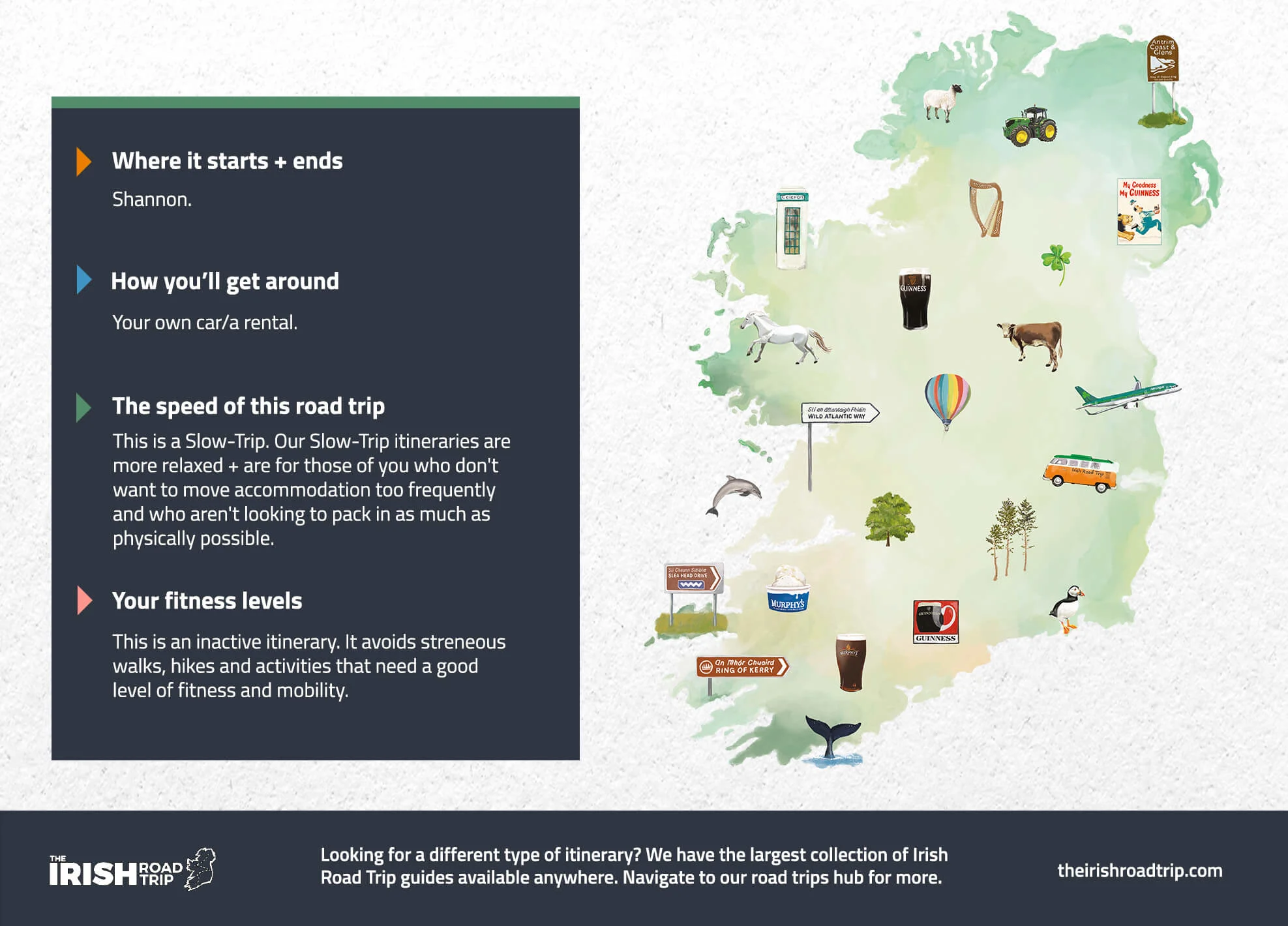
Now, before you scroll down, take 10 seconds to look at the graphic above – each of our road trip itineraries have been tailored to specific needs.
This road trip is specifically for those of you:
- Starting in/near Shannon
- Using your own car/a rental
- Looking to explore at a slow pace
- With a low level of fitness (i.e. it avoids long walks and hikes)
- Remember, we have hundreds of different itineraries here if this one doesn’t suit you.
An overview of this itinerary

Click here to see a high resolution map
The map above gives you a very high-level overview of where this route will take you.
It uses several bases (e.g. Cork for 3 nights) and provides you with day-long road trips you can head off on, so you avoid having to change accommodation constantly.
Now, I’ll stop rambling on – here’s a day-by-day insight into each of the days below!
Day 1: Arrive in Shannon and head to Limerick
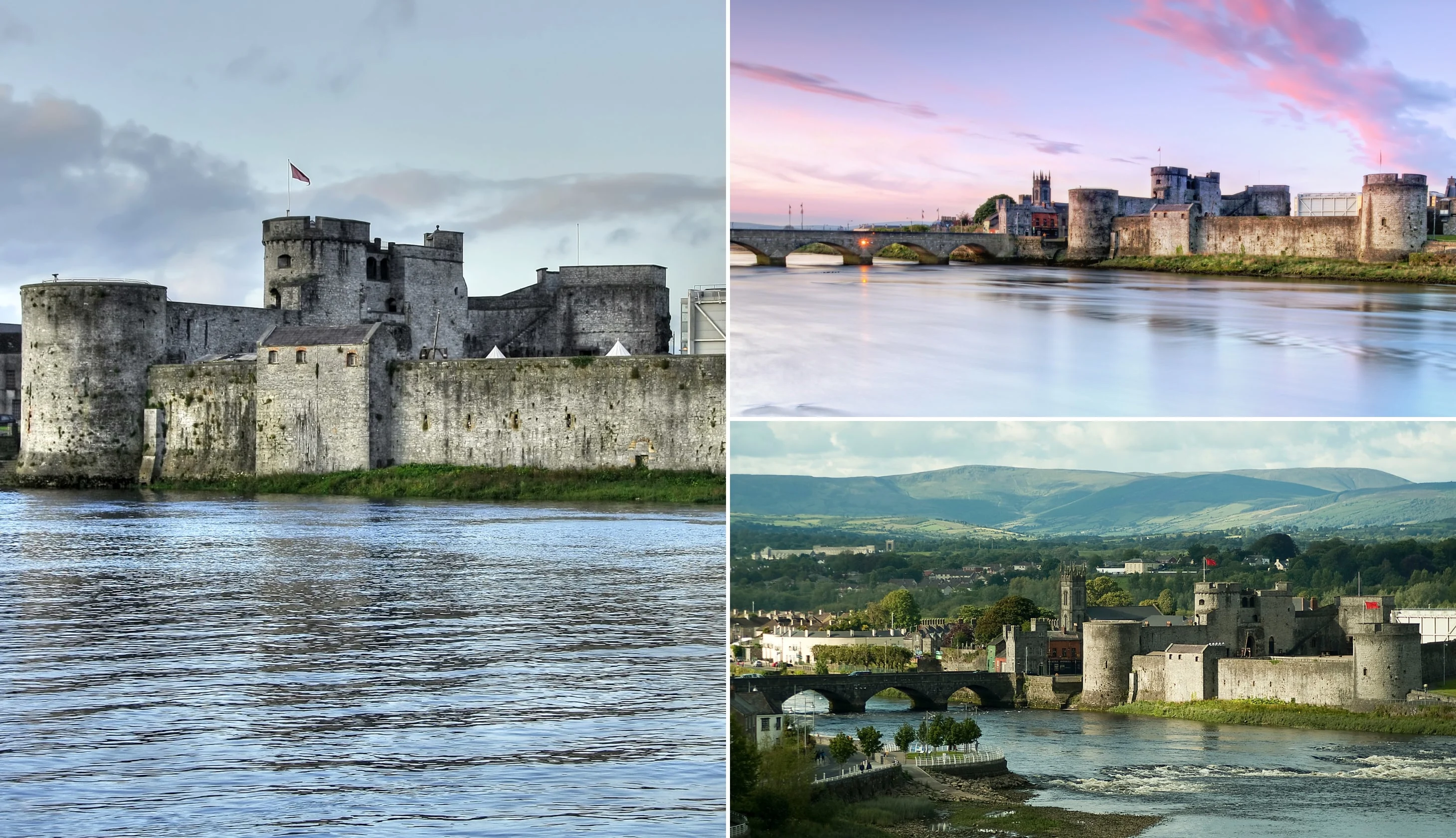
Photos via Shutterstock
Day 1 of this 12-day Ireland itinerary is going to be very dependent on the time that you arrive into Shannon.
For this itinerary, we’re going to make an assumption that you’ve landed in the morning and are ready to explore from mid-afternoon.
After you touch down, pick up your rental car and make your way to Limerick City. You’re going to be spending one night here before moving on to Killarney on day 2.
Recommended accommodation in Limerick
- Budget: Woodfield House Hotel (15-minute walk from the city with excellent reviews) and Shelbourne House (cosy spot 20 minutes walk from the castle)
- Mid-range: Limerick City Hotel (very central hotel near the river) and The Bedford (very central boutique townhouse with exceptional reviews)
- Luxury: The Savoy Hotel (central, boutique 5-star) and The George (central spot on O’Connell Street in Limerick city centre)
Stop 1: Limerick City

Photos via Shutterstock
Welcome to Limerick City! It takes between 25 and 30 minutes via the N19 and N18 from Shannon Airport. There’s a toll through the tunnel, so make sure you have some euro coins or a contactless card so you can get through. Once you arrive, we recommend checking into your accommodation and leaving the car, as you’ll be heading to the rest of today’s stops on foot!
Stop 2: Lunch
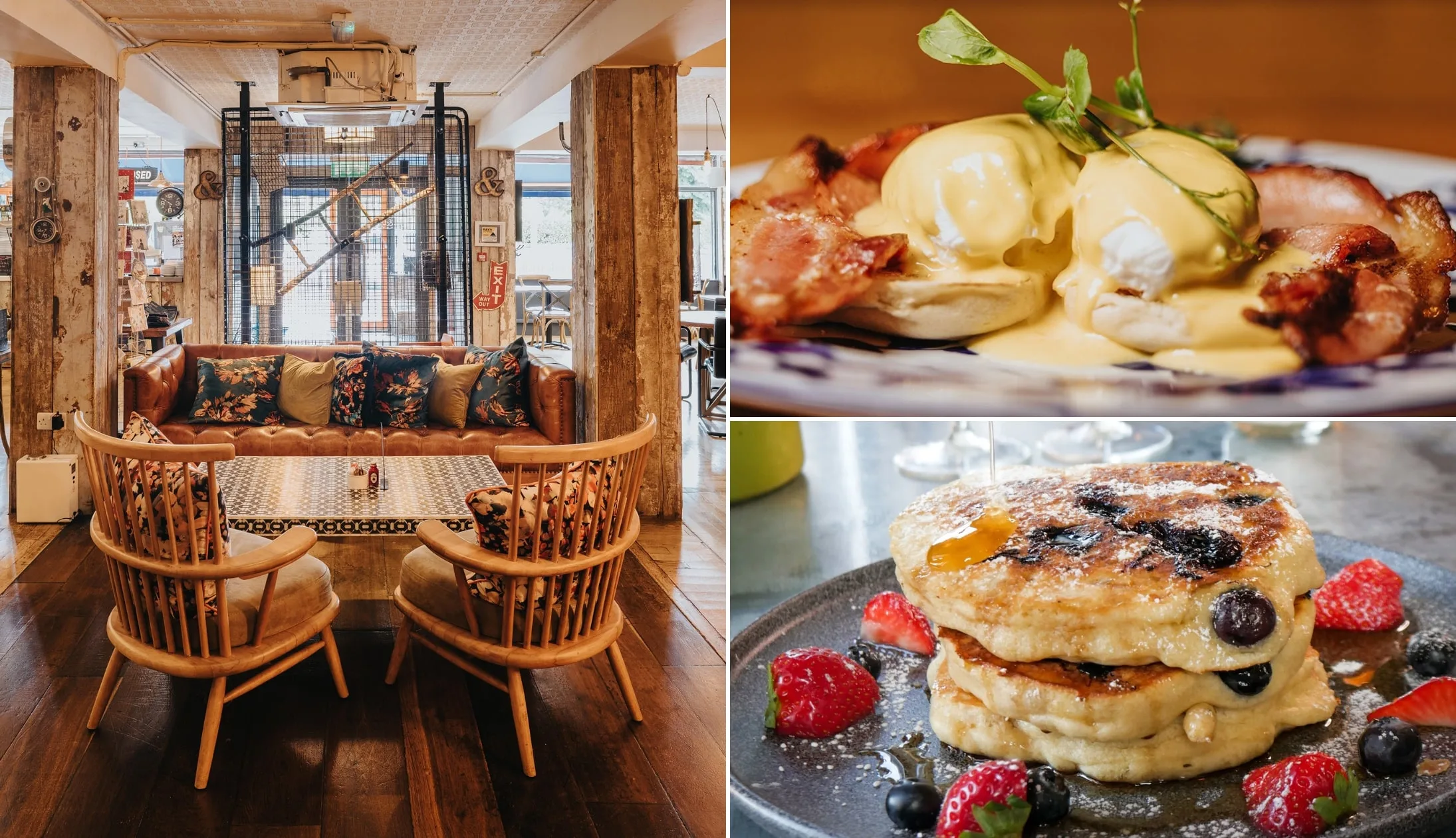
Photos via Hook and Ladder on FB
It’s probably close to lunchtime by now and we’ve got a couple of suggestions for you. We usually head to Coqbull, The Buttery, or the Hook and Ladder when we’re in the city. Coqbull is a casual dining restaurant serving up top-notch burgers and wings. The Buttery is our go-to for brunch, and the Hook and Ladder (the one on Sarsfield Street) has delicious sandwiches and a mouth-watering vegan burger.
Stop 3: King John’s Castle

Photos via Shutterstock
Head off to King John’s Castle, a 10-minute walk from the centre of the city. The 13th-century castle sits on King’s Island, on the banks of the River Shannon. The castle is in fantastic condition and is one of Europe’s best-preserved Norman castles.
King John’s Castle was built under the orders of King John, the “Lord of Ireland” and Richard the Lionheart’s brother. It was built in between 1200 and 1212, with numerous repairs and extensions over its 800-year history.
The castle was a military stronghold with solid curtain walls, turrets, and strong fortifications. However, despite this, it sustained heavy damage during the 1642 siege of Limerick (the first of five Limerick sieges during the 17th century). There’s a fantastic exhibition on the siege inside the castle if you’d like to learn more.
Most people spend around one and half hours visiting the castle and visitor centre. You can have a look at the interactive exhibits, try on historic costumes, and in the summer, play Medieval games in the courtyard!
Stop 4: St Mary’s Cathedral

Photos via Shutterstock
The next stop is St. Mary’s Cathedral. It’s a 3-minute walk from King John’s Castle, and you probably passed it on your way to the castle. The cathedral was founded in 1168, making it even older than King John’s Castle and the oldest building in Limerick that’s still in use today!
The cathedral contains six chapels, but if you’re pressed for time, the Lady Chapel is a must-visit. The Lady Chapel contains its original pre-reformation altar, which is four metres long and weighs three tons. During the mid-1600s, the altar was removed and dumped by Oliver Cromwell’s troops when they captured the city. But, by some miracle, it was recovered in the 1960s and reinstated to its rightful place.
Another highlight of St. Mary’s Cathedral is its misericords (small wooden carvings). They are the only complete set in Ireland and the only remaining pre-Elizabethan carvings.
Stop 5: The Hunt Museum
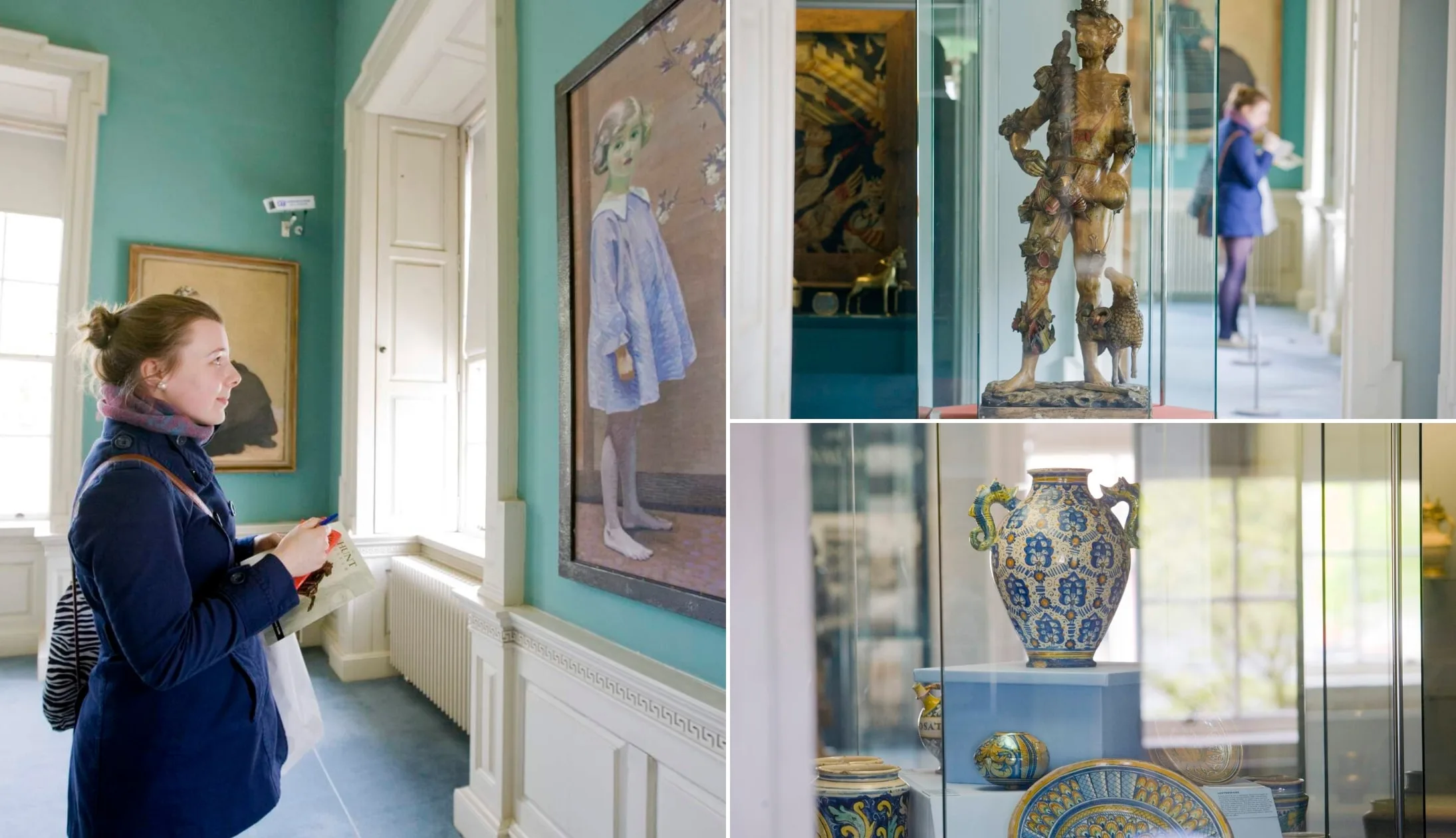
Photos via Tourism Ireland’s Content Pool
It’s time to walk another 3 minutes to the Hunt Museum. Again, you probably already passed it on your way to the castle.
The Hunt Museum was established after John and Gertrude Hunt decided to donate items from their personal collection to the people of Ireland.
The museum has a large collection with over 2,500 artefacts, including pieces from Ancient Egypt and Stone-Age Ireland. Highlights of the collection include works by Picasso and dresses by famous Irish fashion designer Sybil Connolly.
Recently, the museum launched the “Museum in a Garden”, a beautiful garden dotted with 3D printed replicas of historical artefacts (you can grab a ticket online here).
Stop 6: Dinner, drinks and live music
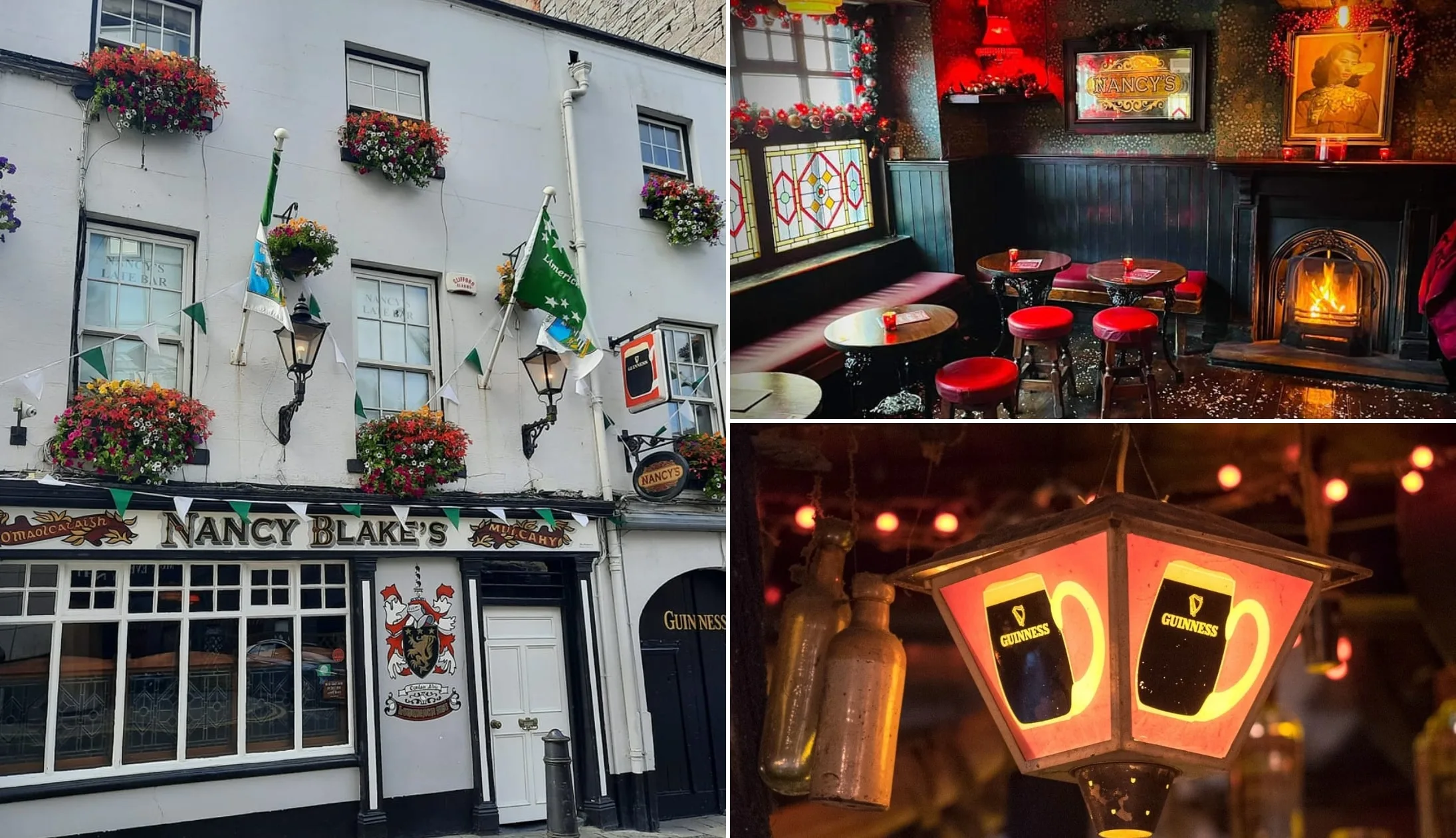
Photos via Nancy Blakes on FB
There’s some excellent restaurants in Limerick and there’s some mighty old-school pubs in Limerick, too.
Our Limerick food recommendations
Our absolute favourite spot for dinner is the Curragower. It’s right on the banks of the River Shannon with beautiful views of King John’s Castle across the water.
Grab some delicious pub grub like the roasted lamb rump or the lightly breaded scampi, then stick around for some pints after dinner.
Otherwise, we also like SpitJack (the rotisserie pork belly is a customer favourite) and The Locke (they have a delicious steak and ale pie and great vegetarian options).
Our Limerick pub recommendations
For drinks, again, we love the Curragower, but Tom Collins is another lovely pub.
Another great trad pub is Nancy Blakes, and depending on the night, they might have some music on. However, if you don’t mind heading a little out of the city centre, then Charlie Malones is a must-visit.
In our opinion, it’s one of Limerick’s best-kept secrets, with a real old-school pub vibe.
Limerick is a great city for trad music. The Locke often has music and even dancing on some nights if you’re lucky! Dolans is also great, but it’s a short walk from the city centre.
Day 2: Killarney

Photos via Shutterstock
It’s day 2 of your 12 days in Ireland itinerary, and today, you’ll be hopping in the car and heading to Killarney. You’ll be spending three nights in this peaceful town which sits on the outskirts of a beautiful national park.
It’s a long-ish drive to Killarney from Limerick, so grab a hearty breakfast before you get on the road.
The Story Cafe is a lovely little cafe with a cosy interior and some great food. They have healthy options like poached eggs on toast or granola, as well as their hearty Mega Story Breakfast and sweet and savoury crepes.
The Hook and Ladder is also a great breakfast stop, they have several locations in the city so you can pick the one closest to your accommodation.
Recommended accommodation in Killarney
- Budget: New Street Lodge (basic accommodation a stone’s throw from the National Park) and Castle Lodge (cosy B&B a 5-minute walk from Killarney House)
- Mid-range: Killaran House (exceptional accommodation in a great location) and Killarney Avenue (right by the park with excellent rooms)
- Luxury: Muckross Park Hotel & Spa (an elegant hotel a 10-minute walk from Muckross Abbey) and The Killarney Park (old-worlde style 5-star near the train station)
Stop 1: Arrive in the town and try and check into your accommodation
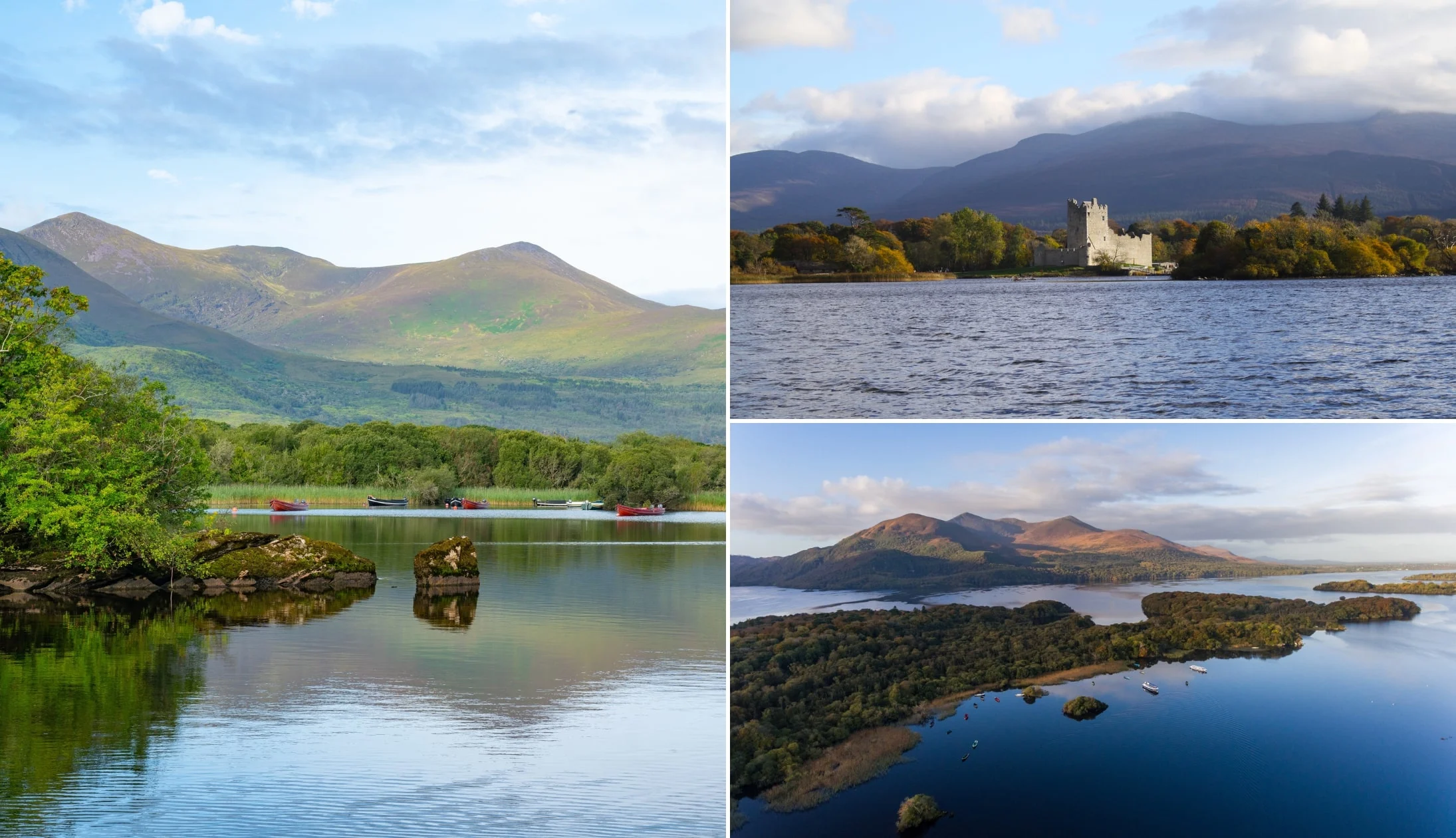
Photos via Shutterstock
Welcome to Killarney Town! Killarney is roughly two-hour drive from Limerick City. Once you arrive, if you feel like stretching your legs a bit, consider grabbing a coffee to go from Bean in Killarney and then going for a little wander.
If you can, try and check into your accommodation – this will likely depend on when you arrive, as some places won’t allow you to check-in until the afternoon.
When you’re ready, it’s time to explore the area and we’ve three different ways of exploring for you to choose from.
There’s endless things to do in Killarney, but a combination of the options below will help you see a good chunk of the area.
Option 1: The jaunty

Photos via Shutterstock
Another great, and very unique way to explore Killarney, is via one of the traditional jaunting cars (i.e. the horse and cart).
On this 1-hour guided jaunty tour you’ll:
- See Ireland’s highest Mountain Range – the MacGillycuddys
- Trot past the 15th-century Ross Castle
- See the impressive St Mary’s Cathedral
- Learn about Killarney from a traditional Jarvey guide
Option 2: The Lakes of Killarney boat Cruise

Photos via Shutterstock
Arguably one of the most popular tours in Killarney is this 1-hour (and very reasonable) boat tour that takes you around Killarney’s lakes.
The tour takes place on a glass-covered boat with heating, and it gives you a completely different perspective of the national park.
You’ll drift by the 6th-century Innisfallen Monastery, see the highest mountain in Ireland and, at times, see Red Deer and White Tailed Eagles.
Stop 2: Dinner, drinks and music in Killarney
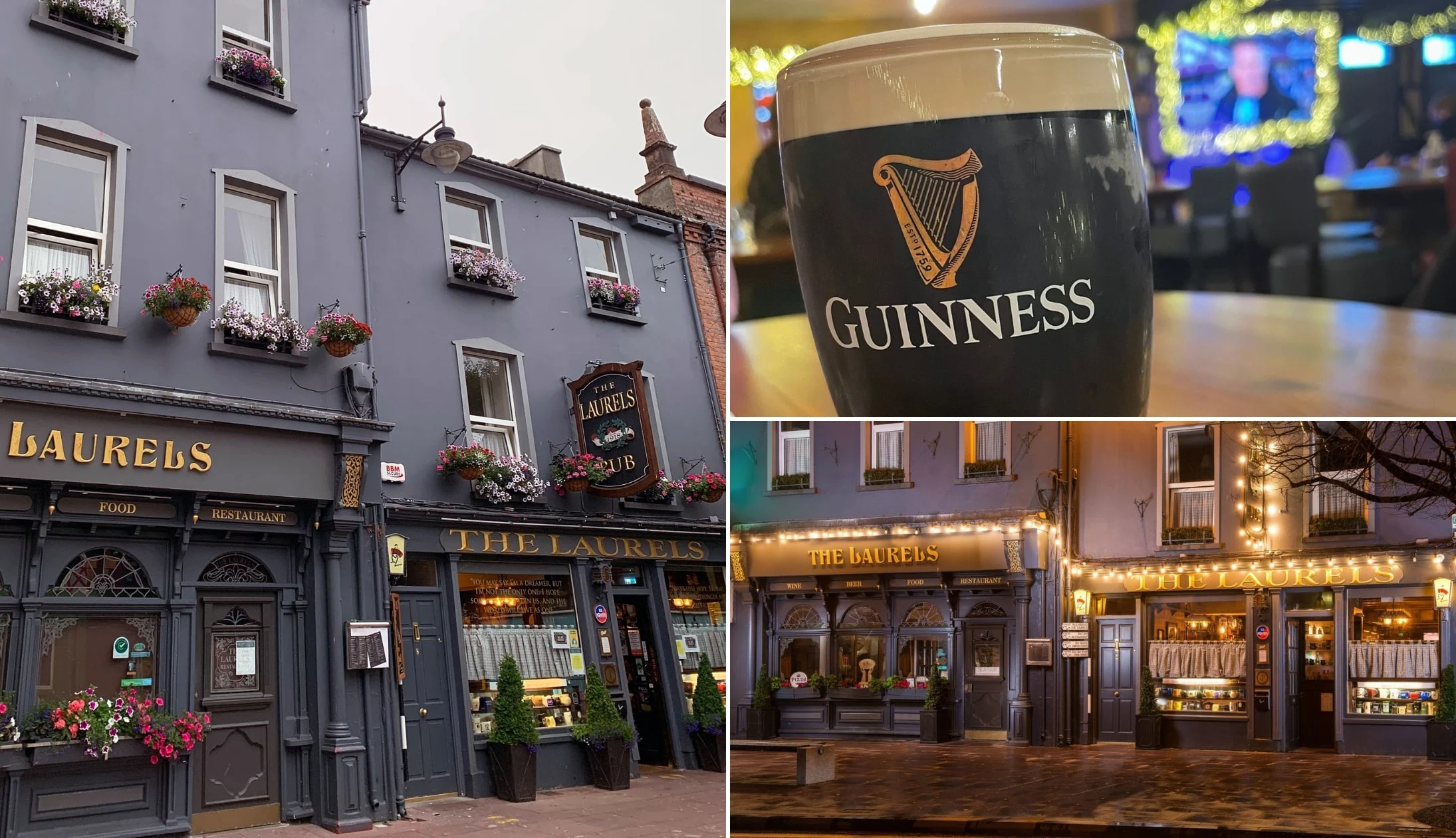
Photos via The Laurels on FB
Freshen up at your hotel, then head out for a well-deserved dinner!
It’s been a long day and, luckily enough, there’s plenty of places to kick-back in for a fine feed and a tipple.
Our dinner recommendations
There are some exceptional restaurants in Killarney. Our favourites are the Mad Monk (they serve amazing seafood like sizzling crab claws and deep water prawn tagliatelle), Kitty O’Se (splash out on the Seafood Tower to share), and Murphy Browns (hearty Irish dishes like roasted duck and fish and chips).
Our pub recommendations
There’s some mighty old-school pubs in Killarney, too. For post-dinner drinks, head to JM Reidy’s, the Laurels Pub, or O’Connors.
They all have a traditional pub feel and are a great choice for a pint. JM Reidy’s has a lovely courtyard which is great in the summer, and O’Connors is perfect if you feel like cocktails.
If you want to hear some live music, JM Reidy’s and O’Connors often have live music sessions.
Day 3: The Ring of Kerry
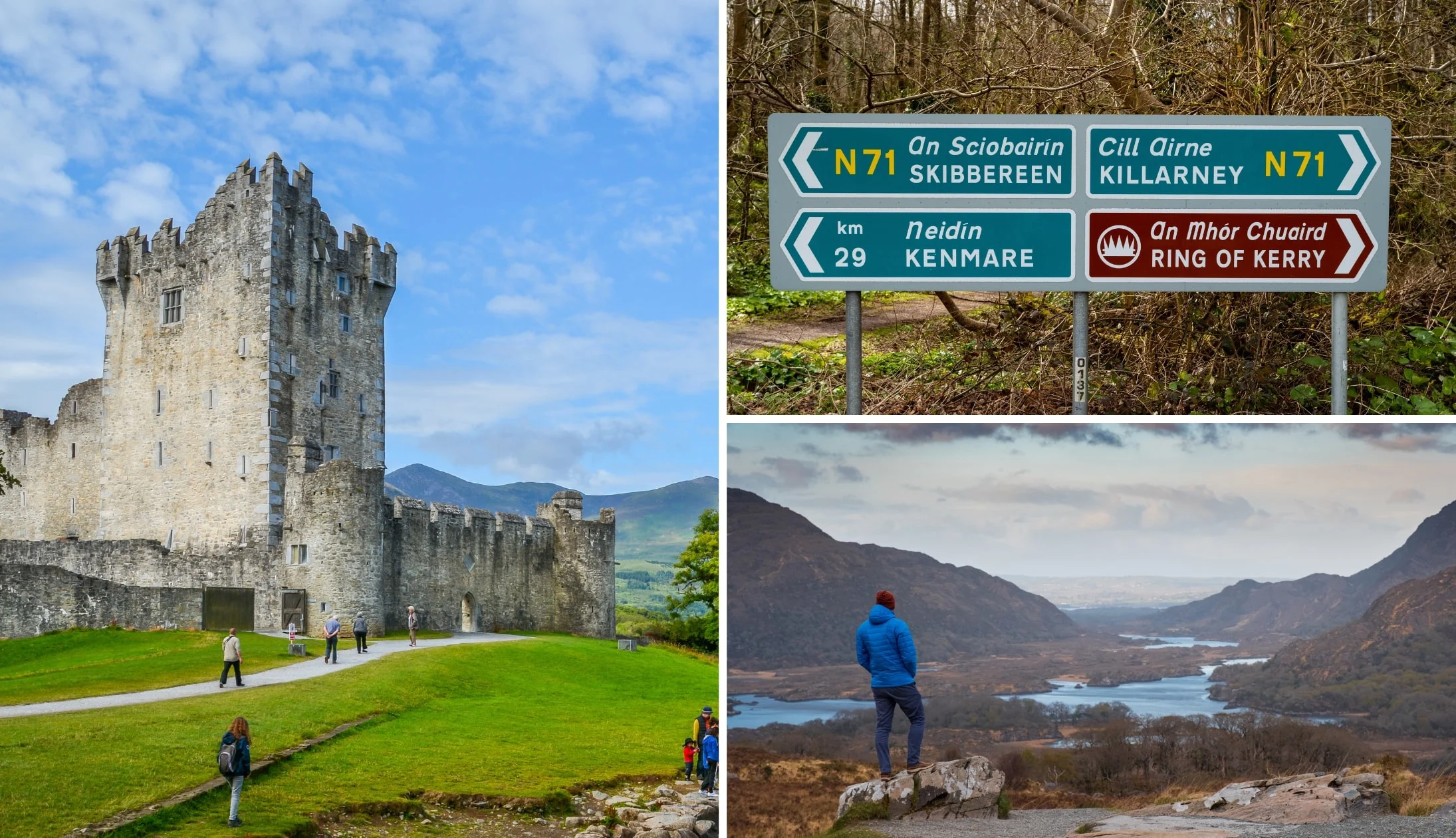
Photos via Shutterstock
Today we are setting off on the Ring of Kerry. You are going to be exploring the ring of Kerry clockwise, stopping at some of our favourite locations that most tour buses just skip by.
Be prepared for breathtaking views, stunning landscapes and the type of scenery that imprints itself upon your mind forever.
We’d strongly recommend reading this Ring of Kerry guide (with a handy Google Map) before you set off as it’ll tell you everything you need to know.
Start the day with a hearty breakfast at your accommodation, or if you’d prefer to go out, we have a couple of suggestions!
Petit Delice is a family-run French patisserie with a stunning covered patio. It’s a great choice if you’re after a morning coffee and a freshly-baked pastry. Otherwise, Manna Cafe does a tasty full Irish as well as breakfast baps and pancakes.
Stop 1: Ross Castle
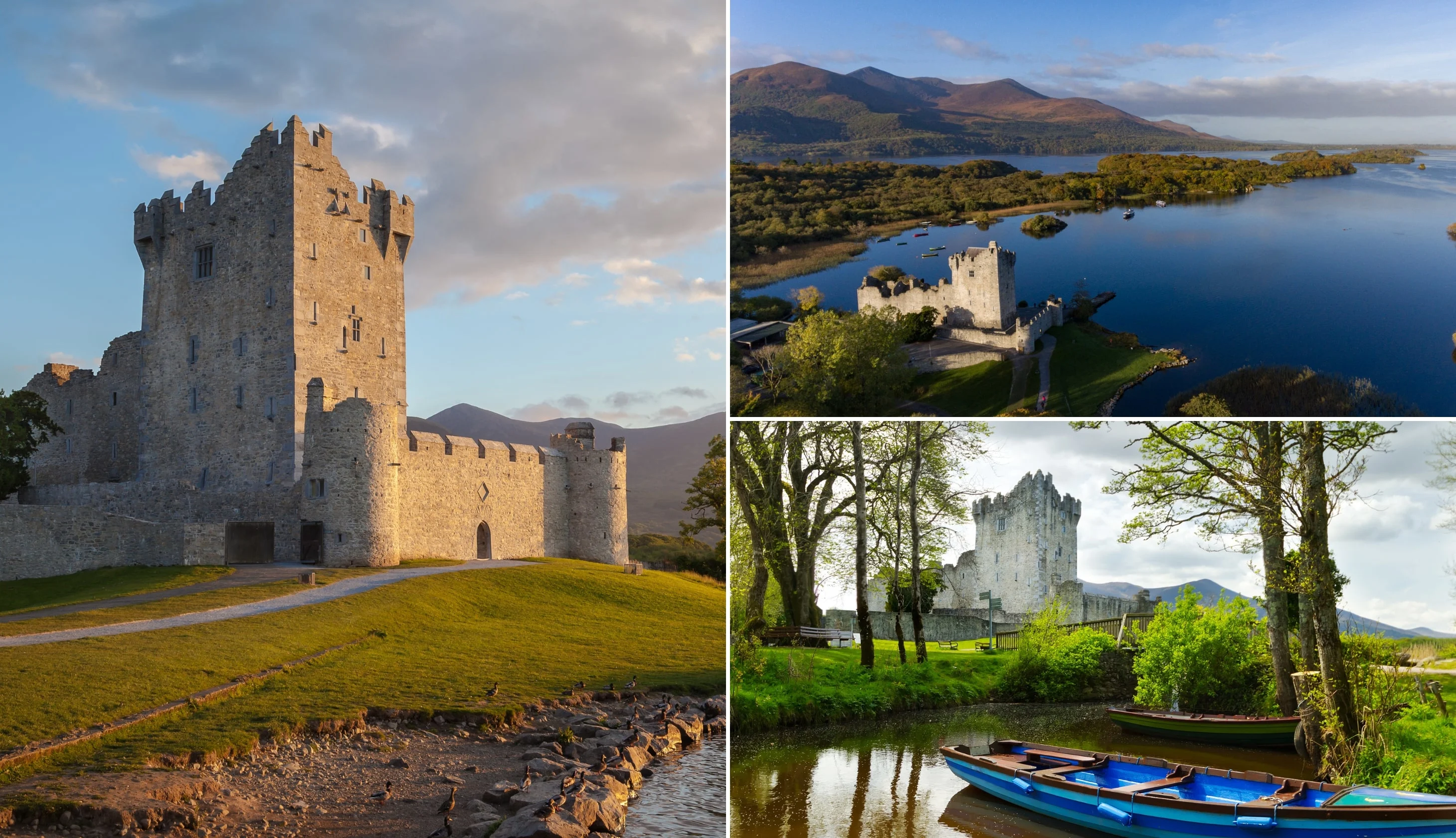
Photos via Shutterstock
(If you visited Ross Castle yesterday, feel free to skip this stop and head straight to Torc Waterfall.)
From Killarney, it’s a 7-minute drive to Ross Castle in Killarney National Park. You can also take a horse and carriage to it, if you like!
Ross Castle was built by O’Donoghue Mór, an Irish Chieftain in the 15th century. The castle is in great condition and sits on the shores of Lough Lenane.
It’s steeped in mystery and according to local legend, O’Donoghue still sleeps under the lake’s waters, rising every seven years on the first morning of May.
You can either visit the grounds and admire the castle from the outside or buy a ticket and join a guided tour.
During the tour, you’ll be taken through the various rooms and given information about the castle’s past inhabitants. The tour lasts around 45 minutes.
Stop 2: Torc Waterfall
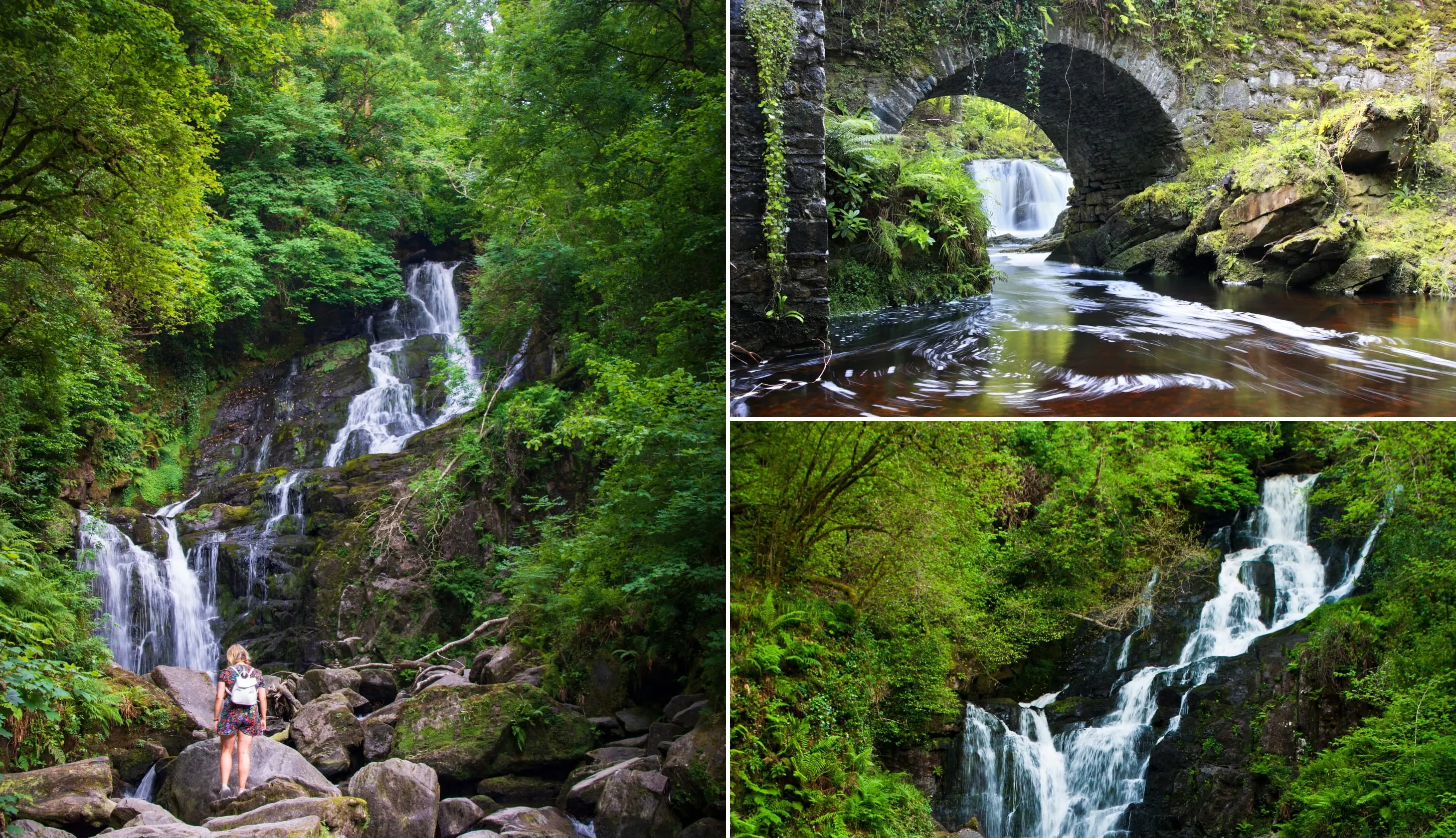
Photos via Shutterstock
From Ross Castle, drive 15 minutes to the enchanting Torc Waterfall. According to local folklore, the waterfall was home to a man who was cursed by the devil to turn into a boar each night.
When his secret was revealed by a farmer, the man burst into flames and retreated to the Devil’s Punchbowl.
There are two car parks close by, but in our experience, the closest car park, Killarney Hiking Parking Lot (here), is often full. So, you may need to park in the Torc Waterfall Lower Parking on the N71 (here).
From the Torc Waterfall Lower Parking, it’s roughly 1km to the waterfall along a paved cycle path that passes by some gorgeous scenery.
From Killarney Hiking Parking Lot, there’s a small path that cuts through the forest and joins up with the cycle path roughly 250 metres from the waterfall.
Stop 3: Ladies View
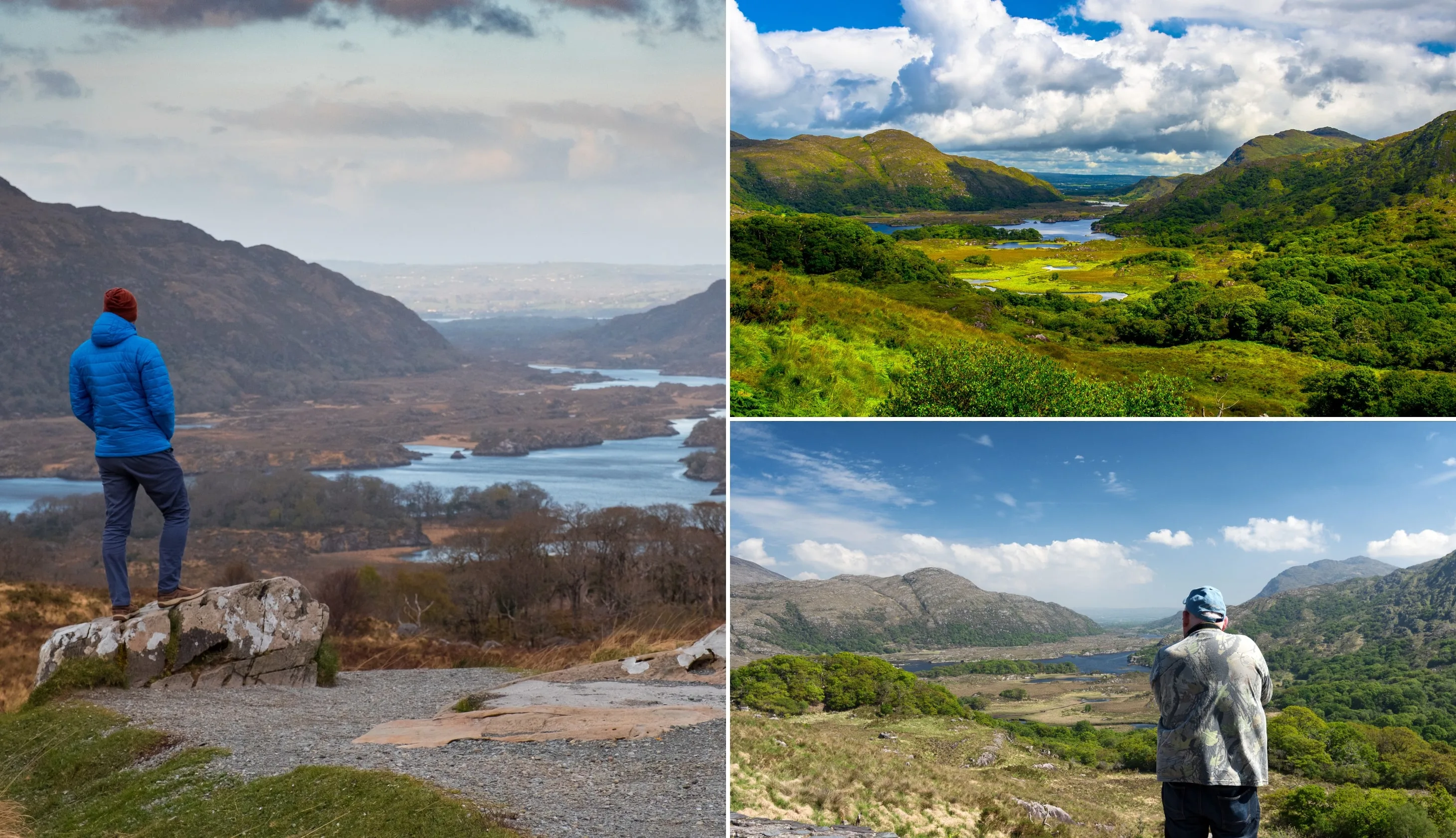
Photos via Shutterstock
From Torc Waterfall, it’s roughly a 15-minute drive to Ladies View. The viewpoint here is a popular stopping point on the Ring of Kerry road, with roadside parking directly facing the view (see parking here on Google Maps).
The viewpoint was named in honour of Queen Victoria’s ladies-in-waiting who were in awe when they visited in 1861 during a royal visit. The view looks out over the Upper Lake with mountains rising up on either side.
Stop 4: Moll’s Gap

Photos via Shutterstock
Drive for around 9 minutes along the N71 to another popular spot on the Ring of Kerry road, Moll’s Gap! There’s plenty of parking at Moll’s Gap (see parking here on Google Maps), but take care as the parking area is on a sharp bend.
Molls Gap is also known as Céim an Daimh in Irish or ‘Gap of the Ox’, but it gets its nickname after Moll Kissane, owner of a local shebeen (unlicensed pub).
The pub was established in the 1820s when the road was being built, and Moll’s homemade poitin (a strong liquor sometimes made from potatoes) was a favourite with the construction workers!
Stop 5: Kenmare
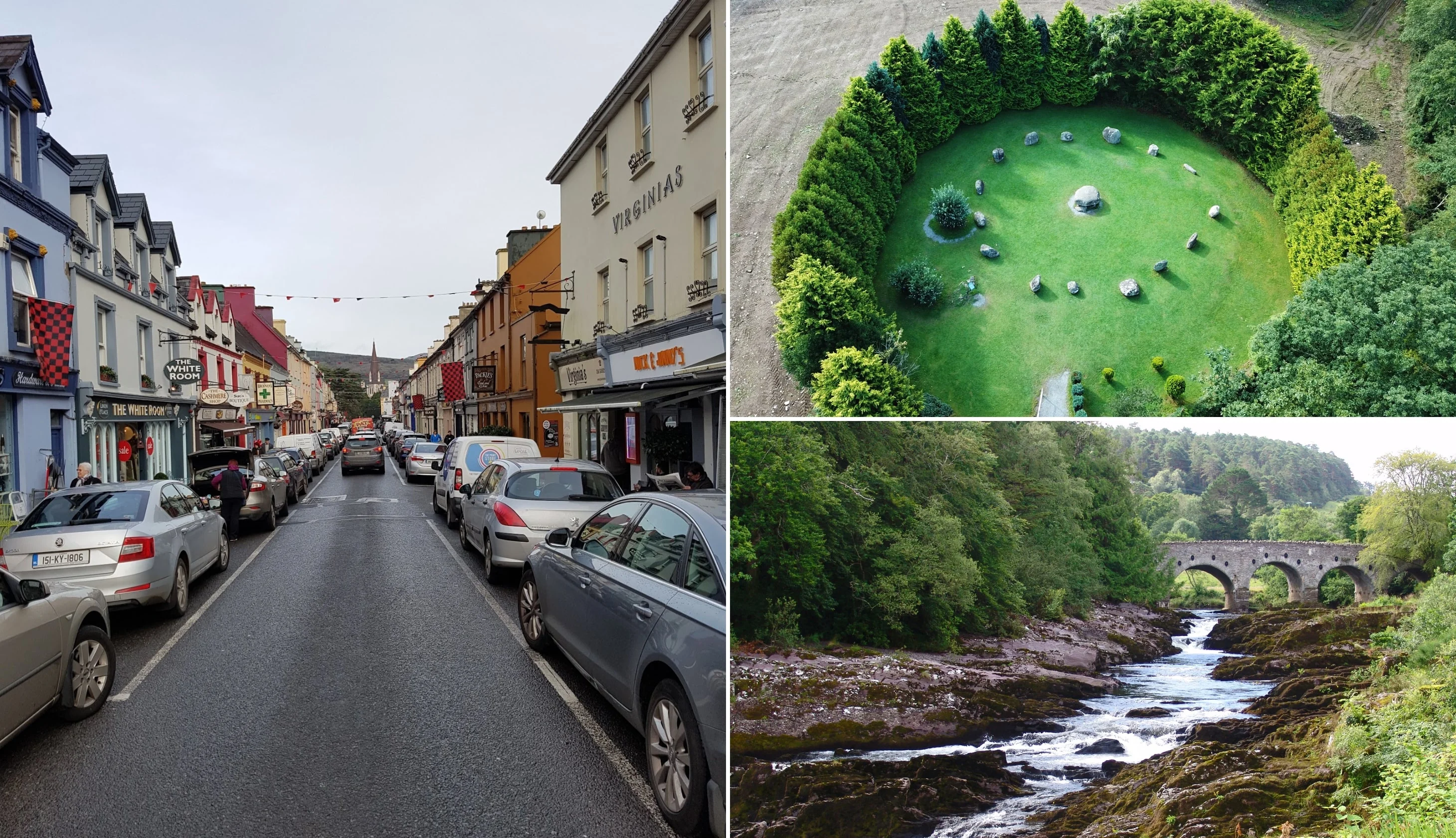
Photo left: The Irish Road Trip. Others: Shutterstock
Continue on the N71 for 12 minutes to Kenmare, a lovely town at the head of Kenmare Bay. It was founded in 1670, and to this day, it’s still full of charm, with colourful houses, traditional pubs, and quaint cafes.
Spend some time exploring the street on foot, popping into the local shops, or heading for a mid-morning coffee at Pucini’s Coffee and Books or Cafe Mocha.
Stop 6: Derrynane Beach
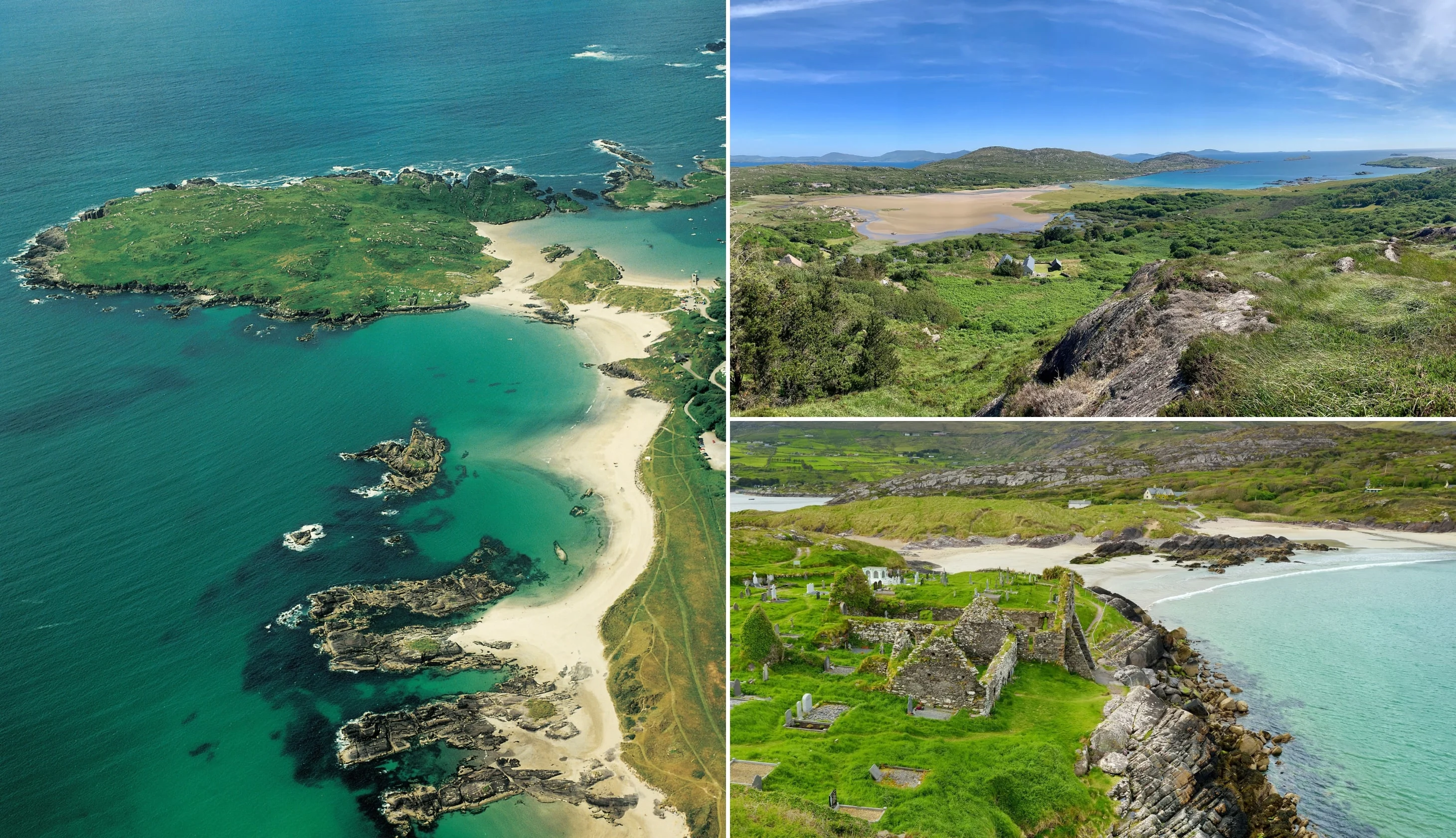
Photos via Shutterstock
From Kenmare, it’s a one-hour drive to Derrynane Beach – one of the finest beaches along the Wild Atlantic Way.
This a lovely white-sand beach backed by soft sand dunes that’s perfect for sauntering along. There are dangerous currents, and a small section is known locally as “Danger Beach”.
Stop 7: Lunch in Waterville

Photos via Dooley’s on FB
It’s time for lunch, so drive 18 minutes to Waterville, Charlie Chaplin’s favourite village in Ireland!
We’ve got a few top picks for where to eat, these are: An Corcan (casual dining and homemade food), Dooleys Seafood and Steakhouse (opens from 1pm serving hearty Irish dishes), and The Lobster Bar and Restaurant (a family-run restaurant with traditional Irish favourites).
Stop 8: Coomanaspig Pass

Photos via Shutterstock
The Coomanaspig Pass is one of the highest points in Ireland that can be accessed by car. From the top, the views are spectacular, and the drive up to the pass is equally as stunning.
Approach the pass via the R565 and the Skellig Ring. The drive takes just under 30 minutes, with plenty of places to pull over and take in the view.
Stop 9: Kerry Cliffs

Photos via Shutterstock
Continue onto the Kerry Cliffs, less than 5 minutes down the road. The cliffs are absolutely magnificent, rising 300 metres above the Atlantic Ocean.
The views from the Kerry Cliffs are wonderful, and on clear days you can see The Skelligs to the west as well as Puffin Island!
Admission to the cliffs cost €4 and there are plenty of places to park. The cliffs are open daily from 9am to 7:30pm. If you’re feeling a little peckish, there’s a small cafe for drinks, cakes, and sandwiches.
Stop 10: Valentia by way of Portmagee
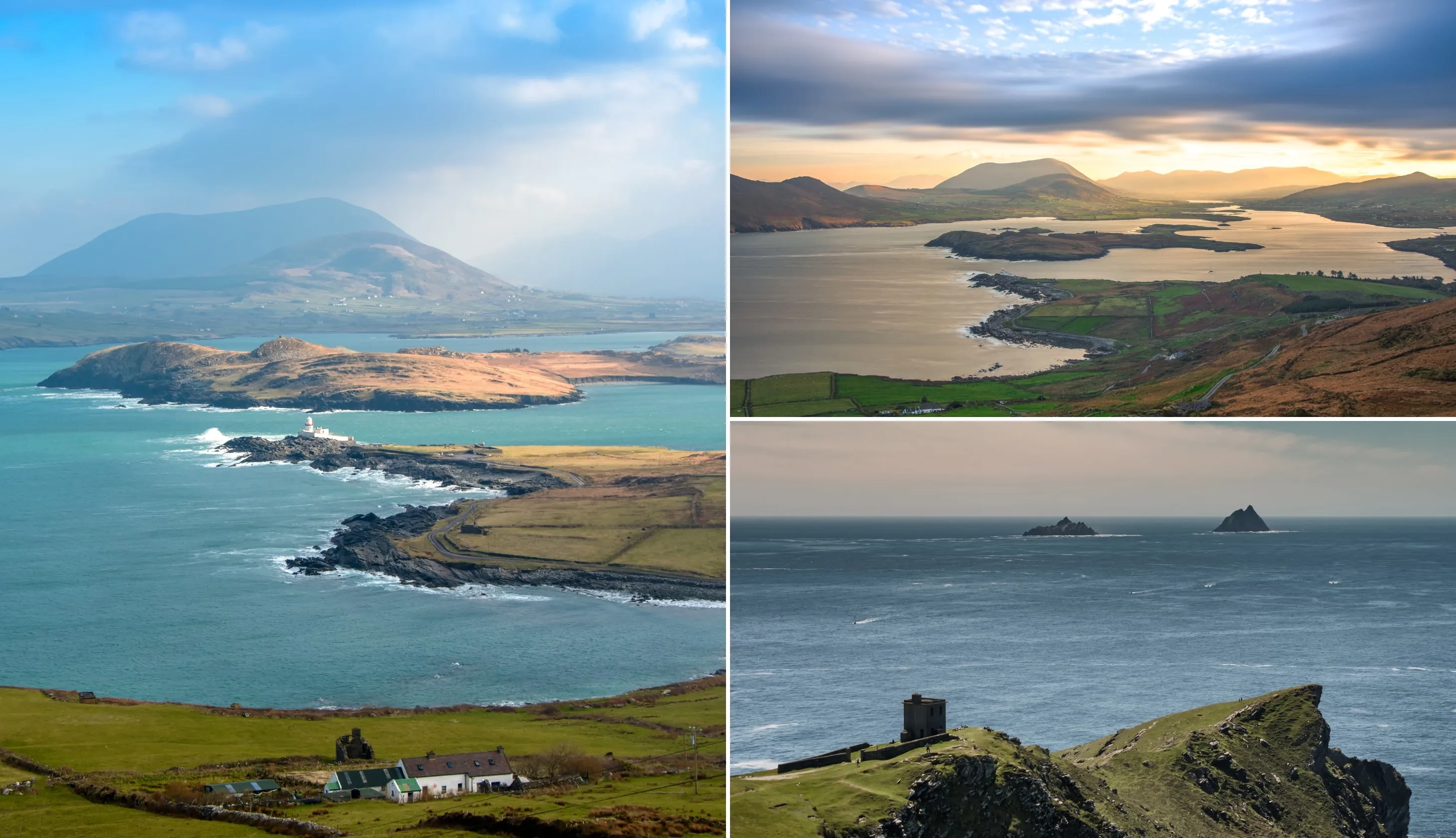
Photos via Shutterstock
It’s time to head to Valentia Island, one of Ireland’s most westerly points. From the Kerry Cliffs, it’s a short drive onto the island via the bridge in Portmagee.
You’ll be using this route to get onto the island, but please note that to get off the island, you’ll be taking the ferry in Knight’s Town (more details below).
There’s lots to do in Valentia, but some of our favourite things are the Valentia Island Lighthouse, the Slate Quarry, and the stunning Geokaun Mountain and Fogher Cliffs.
The Slate Quarry is the most westerly quarry in Europe and the oldest quarry in production in Ireland. Slate from the quarry can be found in Westminster Abbey, the Paris Opera House, and the Houses of Parliament.
Geokaun Mountain is the highest point on the island, standing 270 metres tall. The Fogher Cliffs are on the northern face of Geokaun, with incredible views of the Atlantic, distant mountains, and several islands.
There are three car parks/viewing points along the way. The last one here is the closest to the summit. The landowner charges a small entry fee.
Once you’re finished exploring Valentia, it’s time to take the ferry from Knight’s Town off the island. The ferry runs between 7:45am and 9:25pm Monday – Saturday and 9am to 9:25pm on Sunday. Check the latest timetable on their Facebook Page.
Stop 11: Cahersiveen

Photos via Shutterstock
From the pier in Reenard Point, it’s a 7-minute drive to Cahersiveen. Some cool places to check out in the area are the Old Barracks, which has several exhibitions about the history of the local area, including The Life and Times of Daniel O’Connell, and the Cahersiveen ring forts, which are roughly 3km from town.
Park here to explore the Leacanabuaile Ring Fort and the Cahergall Stone Fort on foot.
Stop 12: Rossbeigh
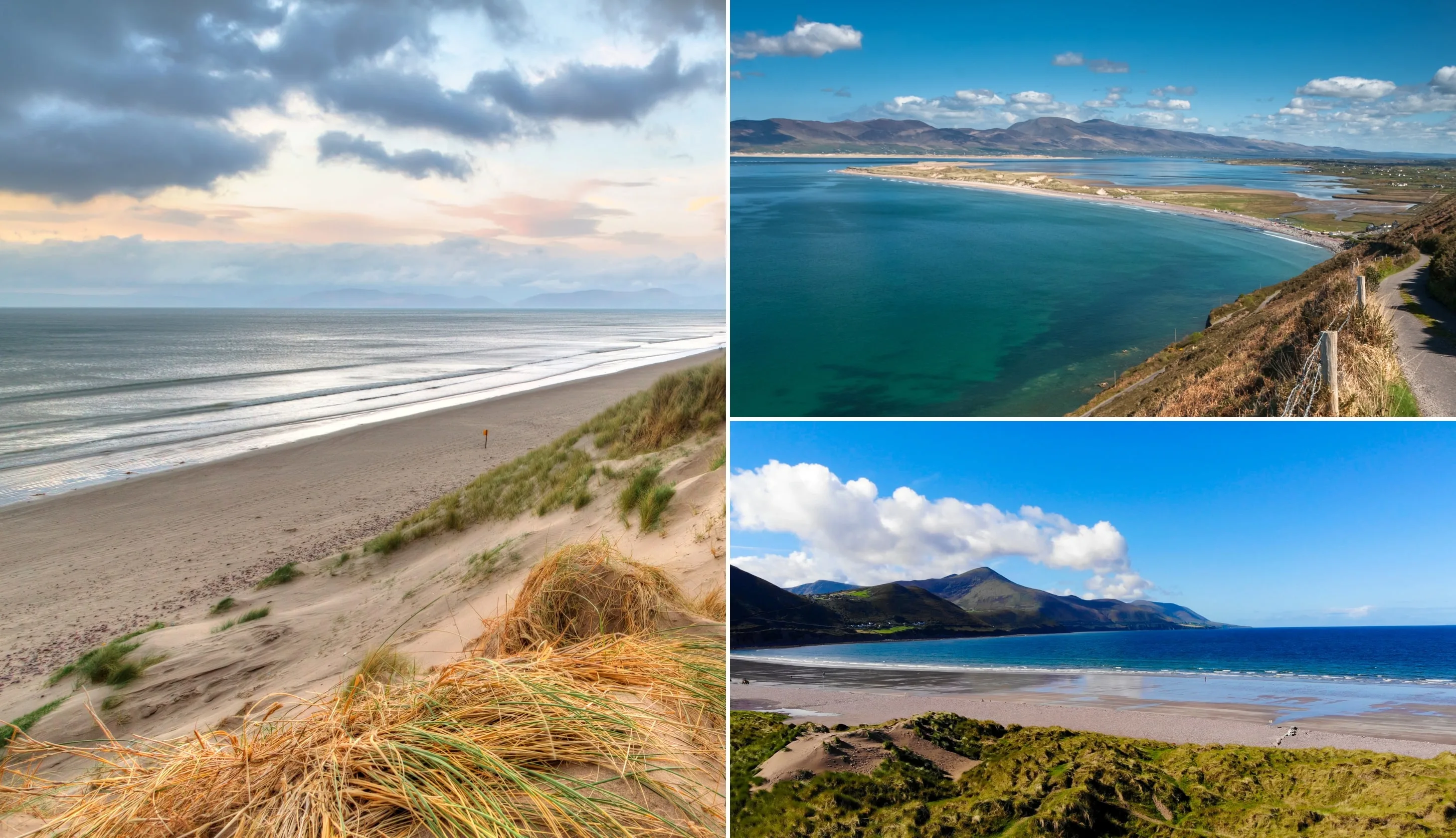
Photos via Shutterstock
From Cahersiveen, Rossbeigh Beach is a 30-minute drive. Rossbeigh Beach is a beautiful 6km long sandy beach with great views over Dingle Bay.
It’s a Blue Flag beach and one of the most popular in the area! We love it for a summer swim or a nice scenic walk in the winter.
Stop 13: Back to Killarney for the night

Photos via The Laurels on FB
The day’s activities are over, and from Rossbeigh, it’s a 50-minute drive back to Killarney.
Our dinner recommendations
There are some exception restaurants in Killarney. Our favourites are the Mad Monk (they serve amazing seafood like sizzling crab claws and deep water prawn tagliatelle), Kitty O’Se (splash out on the Seafood Tower to share), and Murphy Browns (hearty Irish dishes like roasted duck and fish and chips).
Our pub recommendations
There’s some mighty old school pubs in Killarney, too. For post-dinner drinks, head to JM Reidy’s, the Laurels Pub, or O’Connors.
They all have a traditional pub feel and are a great choice for a pint. JM Reidy’s has a lovely courtyard which is great in the summer, and O’Connors is perfect if you feel like cocktails.
If you want to hear some live music, JM Reidy’s and O’Connors often have live music sessions.
Day 4: The Dingle Peninsula

Photos via Shutterstock
Today, you’ll be exploring the Dingle Peninsula. A beautifully remote corner on the country’s southwest coast, with rugged coastline, lovely beaches, and rolling green hills.
There are some beaches on today’s agenda, so bring some swimwear if this is a summer trip, or some extra layers if it’s winter.
Start with a nice breakfast in Killarney before hopping in the car. We’d recommend getting something to eat where you’re staying, or heading to JM Reidy’s or the Shire Bar, which both do a great breakfast.
A note about today
We’re going to give you all of the main attractions located along what’s often referred to as the Dingle Peninsula Loop – you don’t have to visit all of them.
But we want to give you a sense of the stops, some of which get missed, so you can decide which you’d like to see and which you’d like to avoid.
In this guide you’ll find a map with the looped drive outlined along with all the key stops.
Stop 1: Inch Beach

Photos via Shutterstock
Our first stop of the day is a 45-minute spin from Killarney Town.
Inch Beach, as you’ll see from the photo on the left above, is nearly like a little peninsula in itself. It stretches for an impressive 5.5km and it’s a lovely spot for a stroll.
There’s a small car park up front and, before you braze the chill Atlantic breeze, you can grab a coffee from Sammy’s (you can’t miss it).
As you ramble, you’ll see surfers attempting to conquer the waves whole the mountains of Kerry off in the distance seem to loom over you from every angle.
Stop 2: Minard Castle and beach
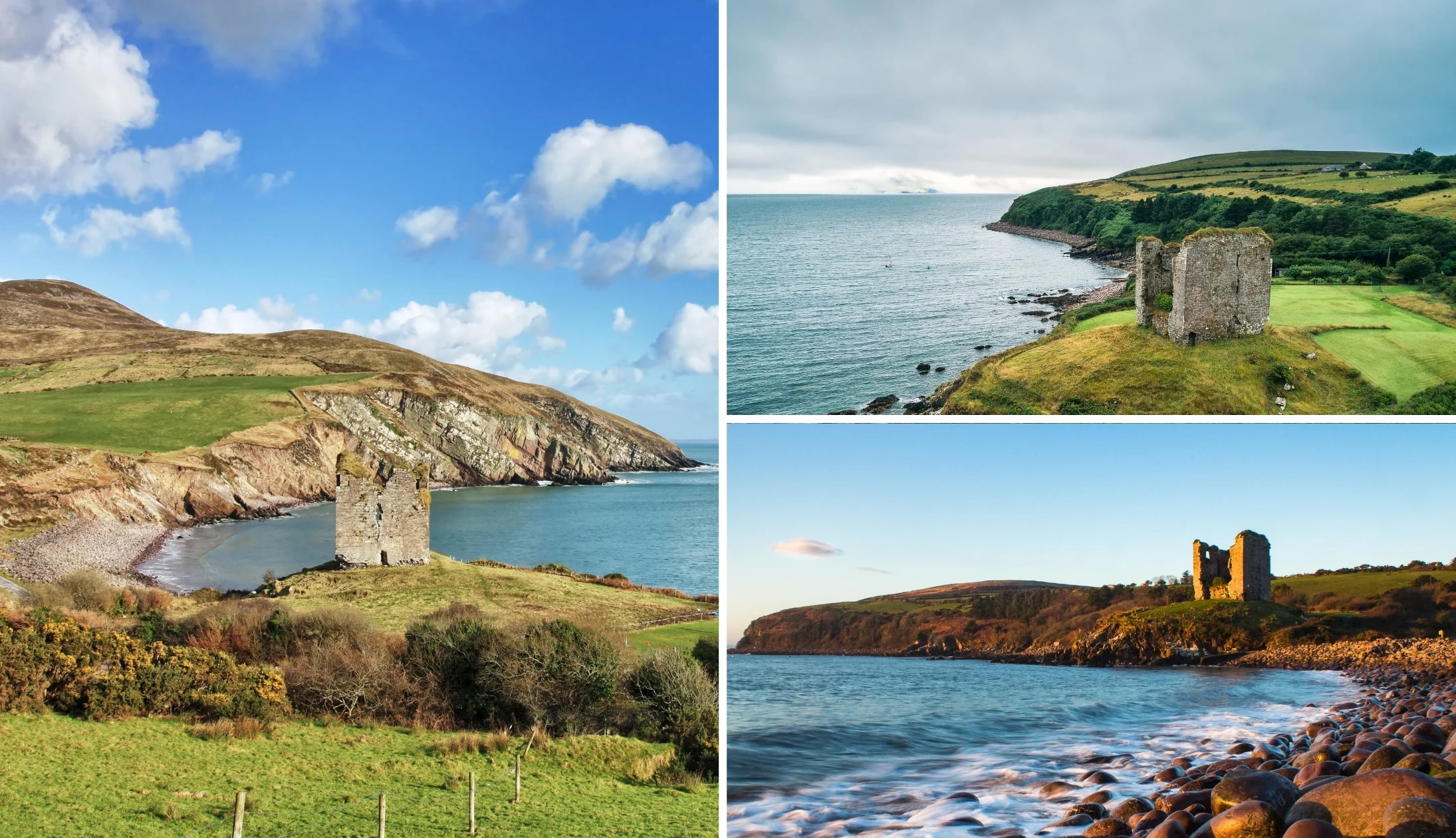
Photos via Shutterstock
Now, if you’ve ever watched the 1970’s film ‘Ryan’s Daughter’, you might recognise Minard Castle, which was referred to in the movie as ‘The Tower’. It’s a 15-minute drive from Inch Beach.
The castle here is finely plonked on a little grassy hill that overlooks the water, commanding breath-taking views on a clear day.
Minard Castle dates to the 16th century and it is one of several ‘Fitzgerald castles’ that were built by the Knight of Kerry on the Dingle Peninsula.
Stop 3: Conor Pass

Photos via Shutterstock
Next up is Conor Pass – a 25-minute drive from Minard Castle. At an impressive 410m above sea level, the mighty Conor Pass is one of Ireland’s highest mountain passes, and it can be the stuff of nightmares for nervous drivers.
However, you don’t have to drive it. If you head up to it from the Dingle side, you’ll reach a car park before you hit the narrow road.
From here, you can soak up views of the surrounding valley and watch the cars navigate its narrow bends from afar.
Stop 4: Dingle Town
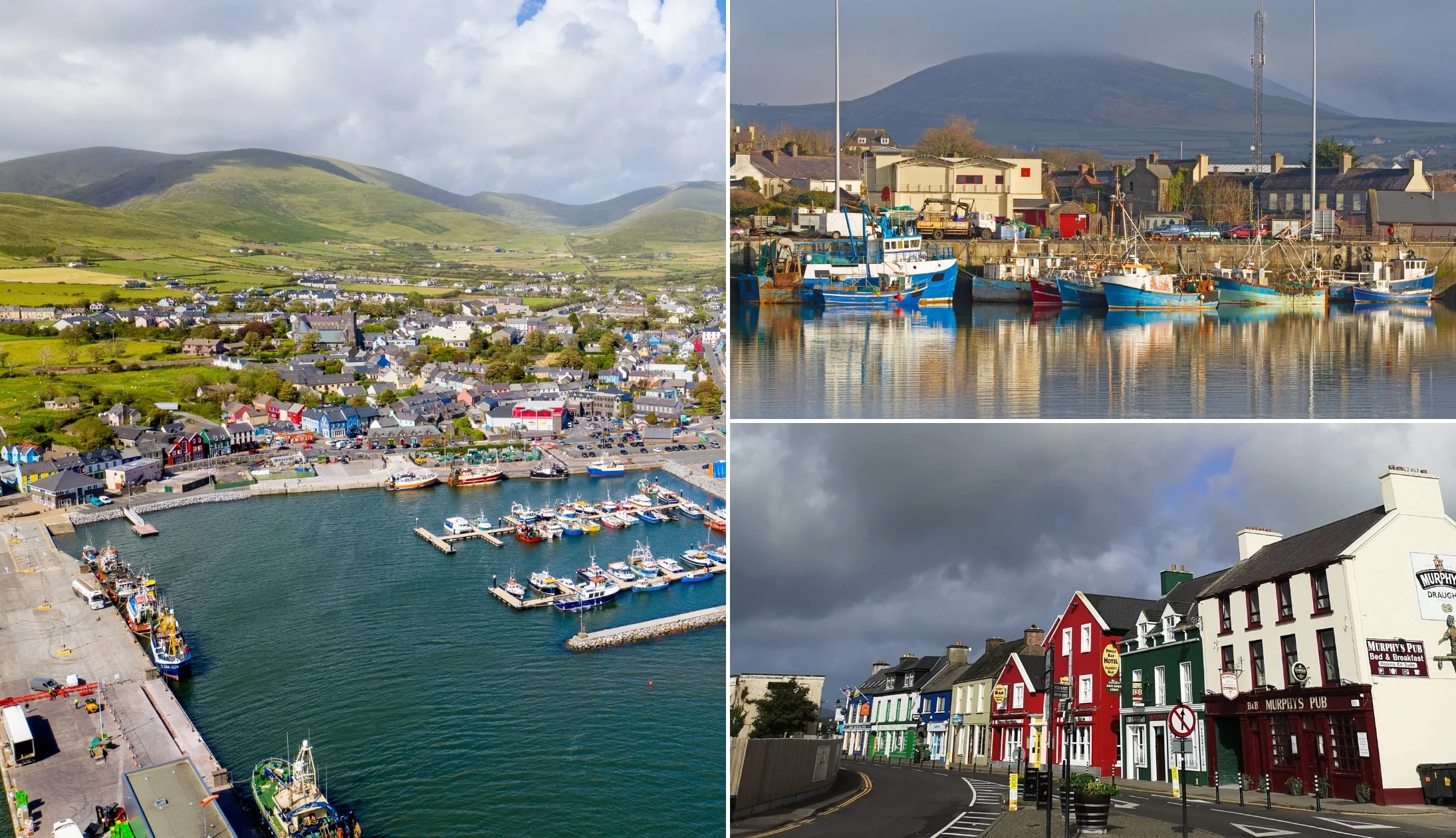
Photos via Shutterstock
You’ll have to double back on yourself, next, and drive the short 10 minutes to the lively Dingle Town.
It’s well worth parking up (you’ll find a car park at the pier), hopping out and heading for a stroll around this colourful little town.
It’s very walkable and, while very touristy, it boasts a fine bit of charm and character. In the town, you have attractions like the Dingle Distillery and the Dingle Aquarium.
There’s also plenty of great restaurants in Dingle (Fish Box is our go-to!) and there are endless old-school pubs in Dingle, too!
From the town, you can join one of the various Dingle Tours, like the Sea Safari or the boat trip to the Blasket Islands.
Stop 5: Ventry Beach

Photos via Shutterstock
Ventry Beach (13-minute drive from Dingle) is a Blue Flag Beach and it has a lifeguard service throughout the summer months. On a warm day, there’s few places like it.
One of the more popular beaches in Kerry, Ventry Beach stretches for around 4.5km and, for me, it marks the beginning of the Slea Head Drive.
Hop out, flick off your shoes and head for a stroll or a paddle. It’s from this point that the Dingle Peninsula Drive goes from good to great!
Stop 6: Beehive huts, forts and sheepdog demonstrations

Photos via Shutterstock
So, these next stops are completely optional. After you leave Ventry, you’ll follow the road to the coast and it’s here that there are several paid and free attractions.
The first you come to is the Celtic Prehistoric Museum, the second is the FairyFort Ringfort, the third are the Dingle Sheepdog Demonstrations, the Famine Cottages and Dunbeg Fort and the fifth is the Beehive Huts.
You’ll then drive around a bend and reach Cashel Murphy followed by a place where you can hold a baby lamb
Personally, I’ve never done them and I likely never will, but I know of many visitors to the Dingle Peninsula that have.
Stop 7: The viewpoints

Photos via Shutterstock
Now, a word of warning – the Dingle Peninsula Drive has numerous viewpoints. Unfortunately, many of them are beyond bends in the road and you often find yourself missing them.
The issue then is that, at certain stages of the route, there’s very few places to turn. The first two you arrive to are Ceann Sleibhe and the White Cross.
Both are next to each other and each is worth stopping at if there’s room to do so.
Stop 8: Radharc na mBlascaoidí viewpoint

Photos via Shutterstock
The next viewpoint, listed as Radharc na mBlascaoidí or Blasket’s View on Google Maps is one of my favourites on the Dingle Peninsula Drive.
There’s a nice bit of parking here and you’ll be treated to a good eyeful of Dunmore Head. If you’re here when the weather is wild, you’ll see (and hear!) waves bashing against the craggy cliff face below.
Stop 9: Coumeenoole Beach
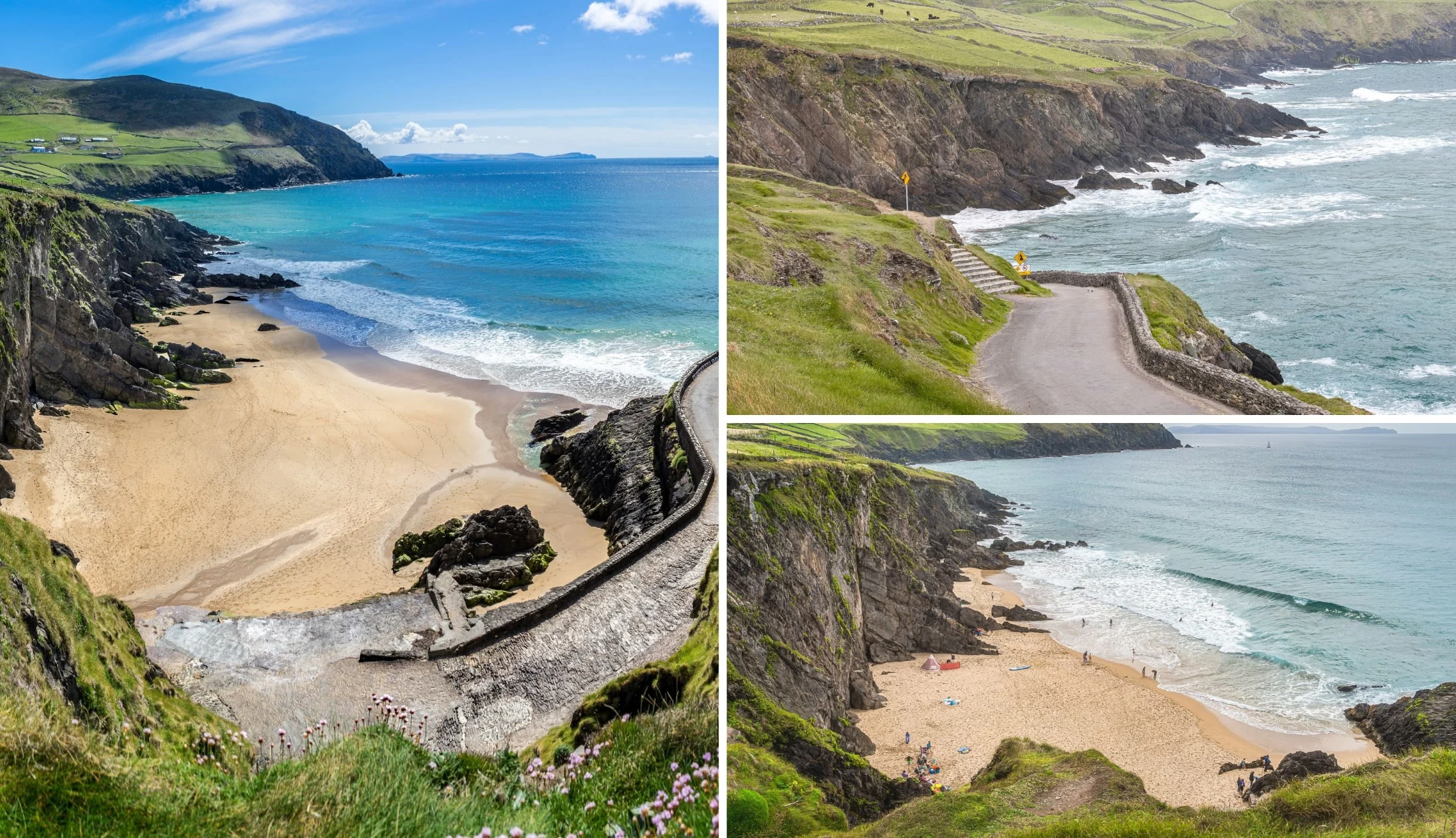
Photos via Shutterstock
Next up is Coumeenoole Beach – another filming location for the movie ‘Ryan’s Daughter’, however, this one comes with a WARNING.
No matter how inviting the water looks here, never enter it – the bay here catches the full force of the Atlantic which creates strong and unpredictable currents.
There’s a little parking area next to the beach and you can either admire it from above or walk down the winding track to the sand.
Stop 10: Dun Chaoin Pier

Photos via Shutterstock
Dun Chaoin Pier is arguably the most notable of the many Dingle Peninsula attractions, thanks to its quirky appearance.
This is the departure point for the ferry to the Blasket Islands and it’s particularly impressive at sunrise and sunset.
Now, another warning – every year a tourist attempts to drive down the path here and gets stuck, destroying their car in the process.
There’s a bit of parking near the ticket office – never… ever attempt to drive down it!
Stop 11: The Blasket Centre

Photos courtesy Valerie O’Sullivan via Ireland’s Content Pool
The Blasket Centre is a good option if you’re doing the Dingle Peninsula Drive when it’s raining and you need a bit of respite.
Boasting magnificent views of the coast and the islands, the Blasket Centre offers an insight into the unique community that lived on the remote Blasket Islands prior to they were evacuated in 1953.
As you walk around it, you’ll get an insight into island life, how the island’s inhabitants made ends meet and plenty more.
Stop 12: Ceann Sraithe (Star Wars filming location)
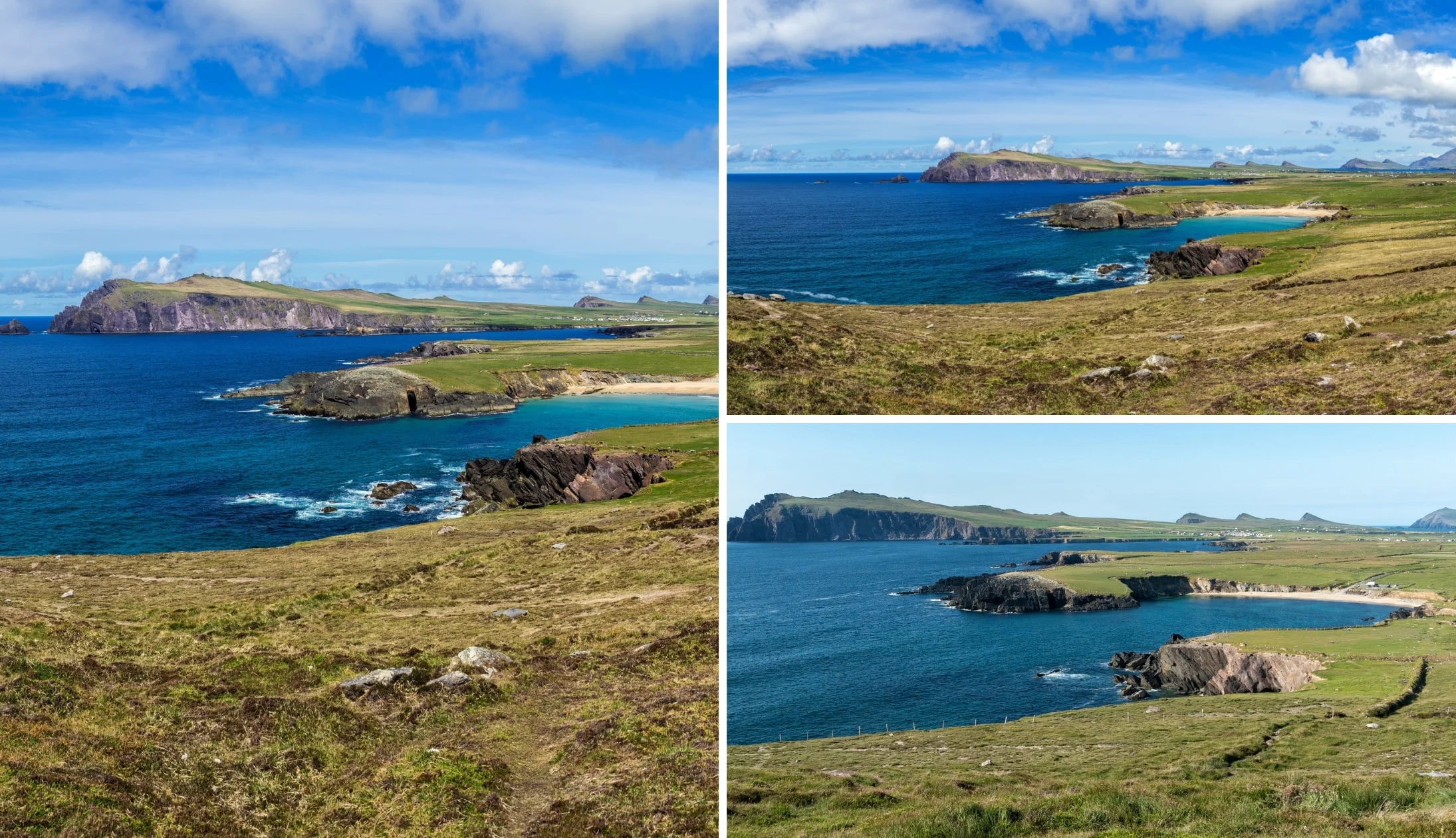
Photos via Shutterstock
As you may be aware, parts of Star Wars: The Force Awakens were filmed in Ireland, most notably on Kerry’s Skellig Michael.
However, a section of the Dingle Peninsula was also used to recreate the Skellig Michael set for later movies. We have this point plotted on the map above.
Now, a warning – there’s no dedicated parking area here, just hard shoulder, so please use caution and never block the road.
Stop 13: Clogher Strand

Photos via Shutterstock
Our next stop is Clogher Strand – one of many little coves that you’ll find dotted around the Dingle Peninsula.
While swimming isn’t allowed here, Clogher Strand is a gorgeous little beach that’s surrounded by rugged cliffs on all sides.
It can make a nice little stop-off point as it’s generally nice and quiet.
Stop 14: Wine Strand

Photos via Shutterstock
One of the more impressive beaches on the Dingle Peninsula is the mighty Wine Strand, a short spin from the previous stop.
There’s a little car park here and, as it’s tucked a little out of sight, tends to get missed by those driving Slea Head.
The views from here are outstanding and you’ll often have the place all to yourself in the off-season,
Stop 15: Gallarus Oratory

Photos via Shutterstock
Gallarus Oratory is one of the final stops on the Dingle Peninsula Drive, and it’s a place that gets plenty of mixed reviews.
There’s a visitor centre (which you need to pay into) or, if you can find parking nearby, you can access it for free via a public path.
It’s believed that Gallarus Oratory was built around the 11th or 12th century. It’s a pokey little structure, standing at just 4.8m by 3m in size.
Stop 16: Dingle for Dinner
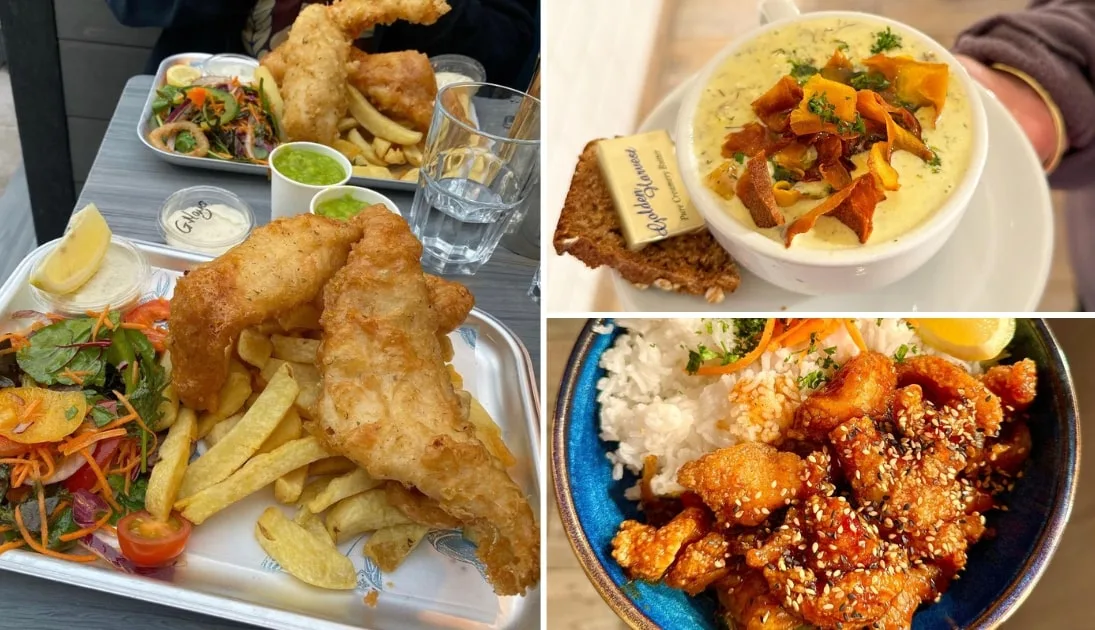
Photos via The Fish Box on FB
Drive around 13 minutes to get back to Dingle, where you’ll be enjoying dinner for the evening. Dingle is a great town for fresh delicious seafood, and you’ll be spoiled for choice when it comes to restaurants.
A few that we recommend are Fish Box (check out their hake burger and fish tacos), The Chart House (a Michelin Guide restaurant serving Irish cuisine), and James Long Gastro Pub (a traditional pub serving local favourites, pizzas, and light bites).
Stop 17: Killarney for the night

Photos via The Laurels on FB
Drive the hour or so back to Killarney and get an early night after your adventure-packed day.
Our pub recommendations
There’s some mighty old school pubs in Killarney, too. For post-dinner drinks, head to JM Reidy’s, the Laurels Pub, or O’Connors.
They all have a traditional pub feel and are a great choice for a pint. JM Reidy’s has a lovely courtyard which is great in the summer, and O’Connors is perfect if you feel like cocktails.
If you want to hear some live music, JM Reidy’s and O’Connors often have live music sessions.
Day 5: Cork City
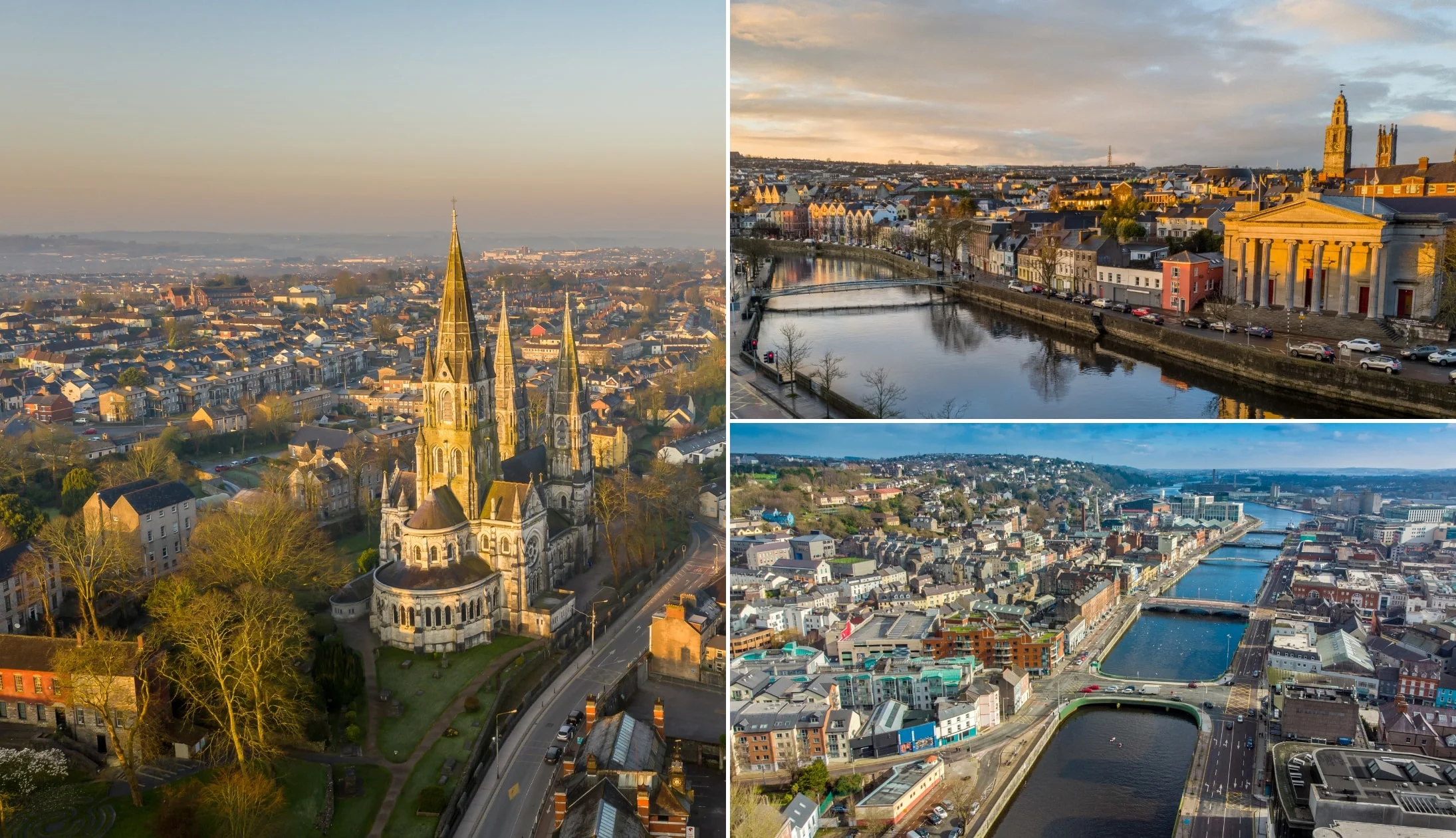
Photos via Shutterstock
We hope you enjoyed your stay in Kerry, today we head off to Cork City where we will be staying for 2 nights.
Recommended accommodation in Cork City
- Budget: Sheilas Tourist Hostel (no-fuss hostel near the train station) + Redclyffe Guesthouse (nice and central with great reviews)
- Mid-range: The Metropole (central with superb reviews) and Hotel Isaacs (in the Victorian Quarter – top-notch rooms and reviews)
- Luxury: Imperial Hotel (stunning and very central hotel) and Hayfield Manor (beautiful, boutique, city centre 5-star)
Grab something to eat before you set off, either at your accommodation or the restaurants we recommended earlier.
Stop 1: Cork City Gaol

Photo left: The Irish Road Trip. Others: Shutterstock
On your way from Killarney, make a stop at Cork City Gaol before you head to your hotel and check-in. It’s around 1.5 hours of driving, and we suggest you park on the street.
Cork City Gaol is a fascinating attraction in a castle-like building that opened in 1824 and closed in 1923. It was home to male and female prisoners who had committed crimes within the city boundaries (those who committed crimes outside were sent to the Cork County Gaol across the river).
The goal was operating through Ireland’s turbulent Civil War, housing male and female Republican (anti-treaty) prisoners, including famous Irish Author Frank O’Connor.
Other famous people who were imprisoned in the gaol include Countess Markievicz, John Sarsfield Casey, James Mountaine, and Brian Dillon.
The Cork City Gaol became a museum in 1993 and is now a popular attraction in the city. You’ll learn about the prisoner’s stories, see the cells, and learn about the harsh 19th-century penal system.
Stop 2: Cork City

Photos via Shutterstock
Drive the 10 minutes in the city, then head to your hotel to drop off your things and freshen up (if you’ve been able to check in early). We recommend leaving your car behind as our stops for the day are easy to reach on foot, and there is little parking available.
Stop 3: Shandon Bell Tower

Photos courtesy Catherine Crowley via Tourism Ireland
Shandon Bell Tower is an iconic landmark in Cork City and a must-visit attraction about 10 minutes from the city centre.
The tower is a part of the Church of St. Anne, which was built in 1722. The church was built to replace an old church on the same site that was destroyed during the Seige of Cork in 1690.
You’ll need to pay a small fee to get to the top of the tower, but from the top, you’ll have wonderful views of the city, and you’ll be able to ring the bells!
Stop 4: The Butter Museum
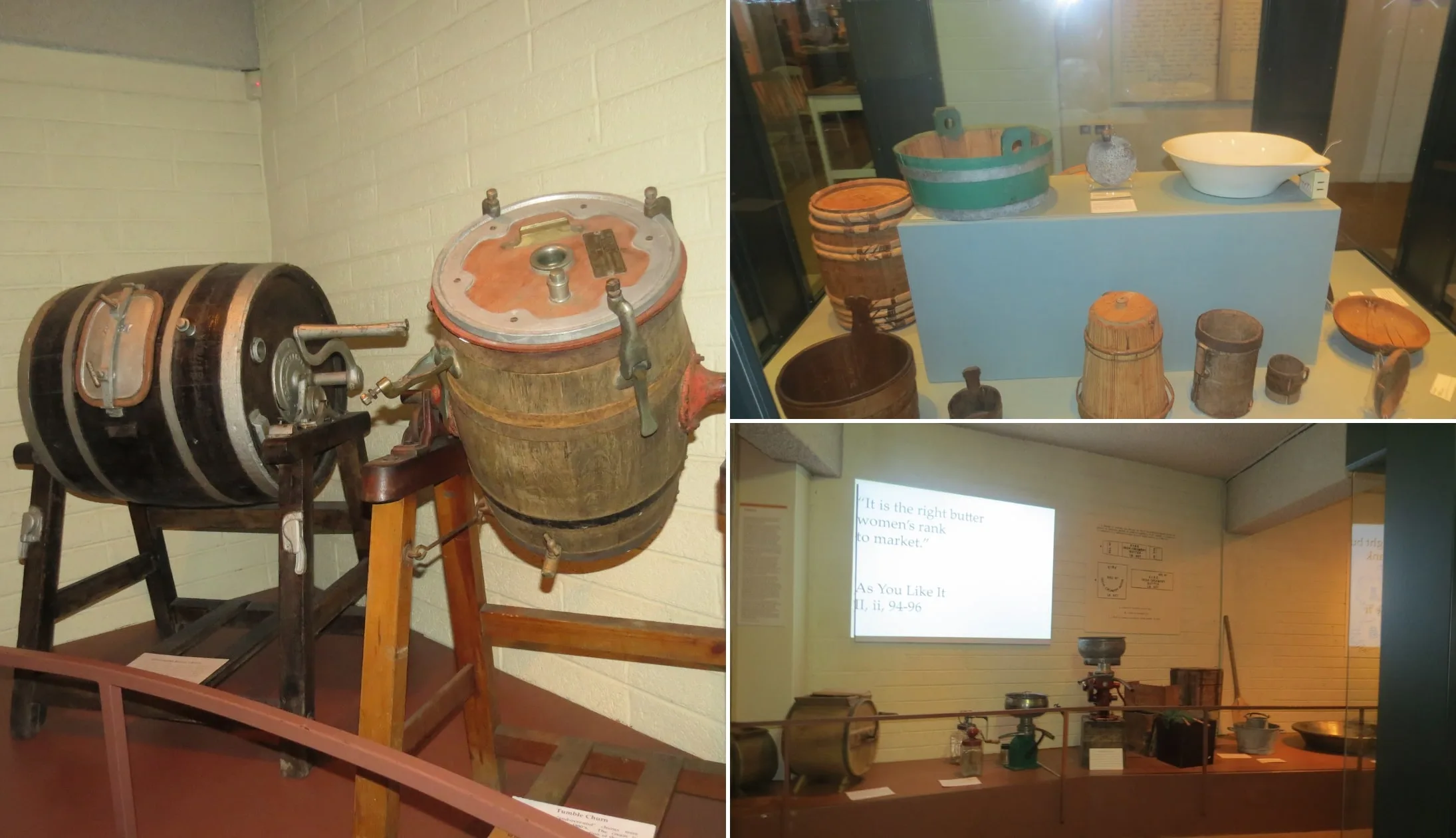
Photos courtesy Catherine Crowley via Tourism Ireland
The Cork Butter Museum is definitely more on the unique side as far as attractions go, but since Cork used to have the largest butter market in Europe, it seems appropriate to visit.
The Cork butter industry is a large part of why Irish butter is so popular to this day.
The museum is a 1-2-minute walk from the bell tower, with some interesting historical info about the city as well as the butter industry.
Stop 5: Lunch in the Cornmarket

Photos via Rising Suns on FB
Walk the short 6 minutes to the Cornmarket for lunch. Be mindful that the next stop is also a foodie destination, so don’t fill up too much!
We recommend popping into Bodega for delicious pub grub, the Cornstore if you’re after something a little more upmarket, or Rising Suns if you’re craving a pizza.
Stop 6: The English Market

Photos by Chris Hill via Tourism Ireland
The English Market is only 4 minutes away from the Cornmarket. It’s a beautiful covered market with impressive mid-19th-century architecture.
Its name, “English Market”, was to help distinguish it from the Cornmarket, formerly known as the “Irish Market”.
The market dates back to 1788, making it one of the oldest covered markets in Europe.
Aside from its history and beautiful architecture, the English Market is known for its delicious food, and you can get everything from artisanal olives to homemade jams.
Stop 7: Elizabeth Fort
Once you’re finished perusing the market, walk the 10 minutes over to Elizabeth Fort. The star-shaped fort dates back to the 17th century and currently sits off Barrack Street in Cork City.
The fort was originally on high ground, but over the years, the city has built up around it, although it still has fantastic views over Cork.
General admission is free, but if you’d like to learn more about this historic fortification, guided tours are offered at 1pm every day (€5), and audio guides are available in multiple languages (€3).
Stop 8: St Fin Barre’s Cathedral

Photos via Shutterstock
St. Fin Barre’s Cathedral is just a short walk over from Elizabeth Fort. It costs €6 to enter and it’s worth every euro. The Gothic-revival cathedral is magnificent, with three showy spies, impressive stone arches, and gargoyles decorating the outer walls.
Inside it’s even showier, with stone archways lining the sides of the nave, and a total of 74 windows, each with individually designed stained-glass panels. However, our favourite part is the sanctuary ceiling – look up when you’re inside and you’ll see why!
The cathedral took 14 years to build from the groundbreaking (1865) to the consecration (1879). It sits on top of a 7th-century Christian site, which is said to have been founded by St. Finbarr.
Stop 9: Dinner, drinks and live music
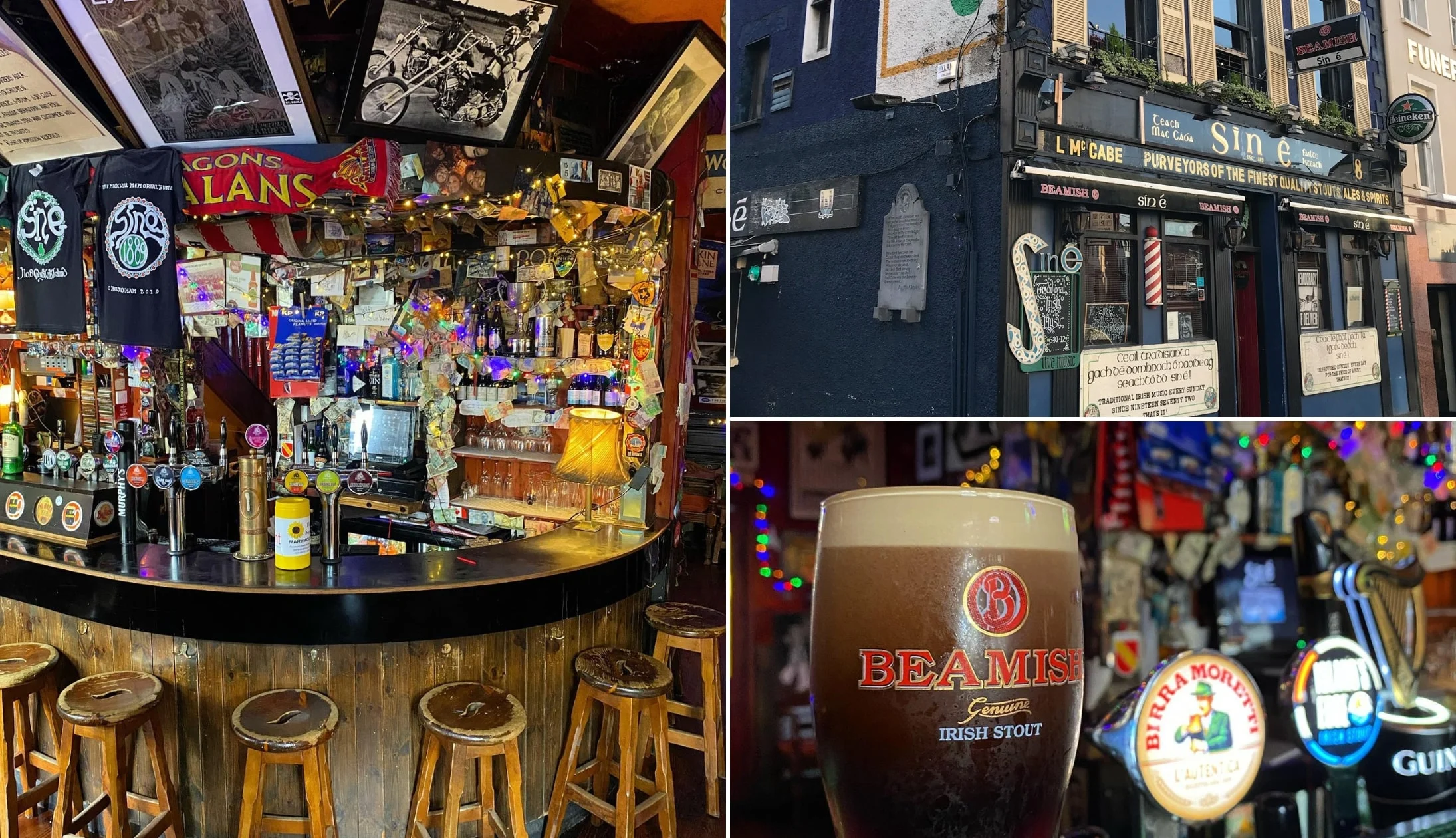
Photos via Sin E on FB
You’ve an endless supply of pubs and restaurants to choose from in Cork. Here’s a few of our favourites:
Our Cork food recommendations
There are heaps of brilliant restaurants in Cork City, but our personal favourites are Market Lane, Old Town Whiskey Bar at Bodega, and Cornstore.
Market Lane has a delicious-sounding menu featuring Irish favourites like pan-fried hake with braised leeks, smoked mussels, and baby potatoes.
Head to Old Town Whiskey Bar for burgers, salads, and traditional pub grub, and Cornstore for steaks and seafood.
Great Cork City pubs
There’s some glorious pubs in Cork, too. For drinks, check out Mutton Lane (a quirky traditional pub), The Oval (a historic pub named after its unique oval ceiling), and Castle Inn (a traditional family-run pub with a great atmosphere).
There are some great spots for hearing some trad music in Cork, our top choices are Sin E and The Corner House.
Day 6: Kinsale

Photos via Shutterstock
Today we are exploring the coastal area just south of Cork City and the village of Kinsale. There’s a bit of walking today between attractions, so make sure to wear suitable footwear and bring plenty of water.
Before you head out, grab some breakfast at your accommodation or take a look for somewhere to eat at the English Market.
Stop 1: Lusitania Monument

Photos courtesy Shannon Forde via Failte Ireland
The Lusitania Museum is a 45-minute drive from Cork City. It’s inside an old Signal Tower, The Old Head Signal Tower, one of 81 built from Dublin to Donegal. The ground floor of the tower tells the story of Ireland’s Signal Towers and the area’s ancient history.
On the first floor, you’ll find exhibitions and artefacts relating to the RMS Lusitania, which was tragically torpedoed by a German U Boat during WWI. The boat sank in only 18 minutes, resulting in many casualties.
Once you’ve learned the story of the RMS Lusitania, head outside to the Lusitania Memorial Garden to look at the powerful 20-metre sculpture, which includes the names of the lives lost on May 7th, 1915. There are also beautiful views over Kinsale Head.
Stop 2: St Multose Church

Photos via Shutterstock
Drive back the 20 minutes back to Kinsale and park in the Main Town Car Park. If it’s full, there is plenty of room on the street nearby. You’re going to be heading to the next few stops on foot from here, so make sure to pay for plenty of parking.
Stroll 5 minutes up to St. Multose Church is thought to be one of the oldest churches belonging to the Church of Ireland! It’s a cruciform church with a crypt that dates back to 1190, although the entire church is built on a 6th-century ecclesiastical settlement.
In the 1750s, the church underwent major additions, however, the church’s large bell tower is a part of the original Norman structure. The church’s graveyard contains 16th-19th-century monuments and mausoleums, as well as the graves of unidentified victims of the RMS Lusitania sinking.
Stop 3: Cosy Cafe and Kinsale

Photos via Shutterstock
If you’re ready for a mid-afternoon coffee, then we suggest stopping by the Cosy Cafe. It’s right across the street from St. Multose, so you really can’t miss it!
You’ve got a little time for a wander if you feel like it, so why not take your coffee to go and explore the gorgeous town of Kinsale?
You can pass by Desmond Castle (it’s most likely closed by you can admire it from the outside), pick up a book from Bookstór (a lovely independent bookstore selling new and second-hand books), or do some shopping in one of the town’s boutique shops.
Stop 4: Charles Fort

Photos via Shutterstock
Hop in the car and drive 5 minutes to Charles Fort. Charles Fort is the country’s largest military installation.
The huge star-shaped building dates back to the late 17th century and, over the years, has seen some fearsome battles.
The fort survived a 13-day siege during the Williamite wars in 1690 and a battle during the Civil War in the 1920s. Make sure to head to the ramparts for the stunning view over Kinsale Harbour.
Stop 5: Lunch at The Bulman
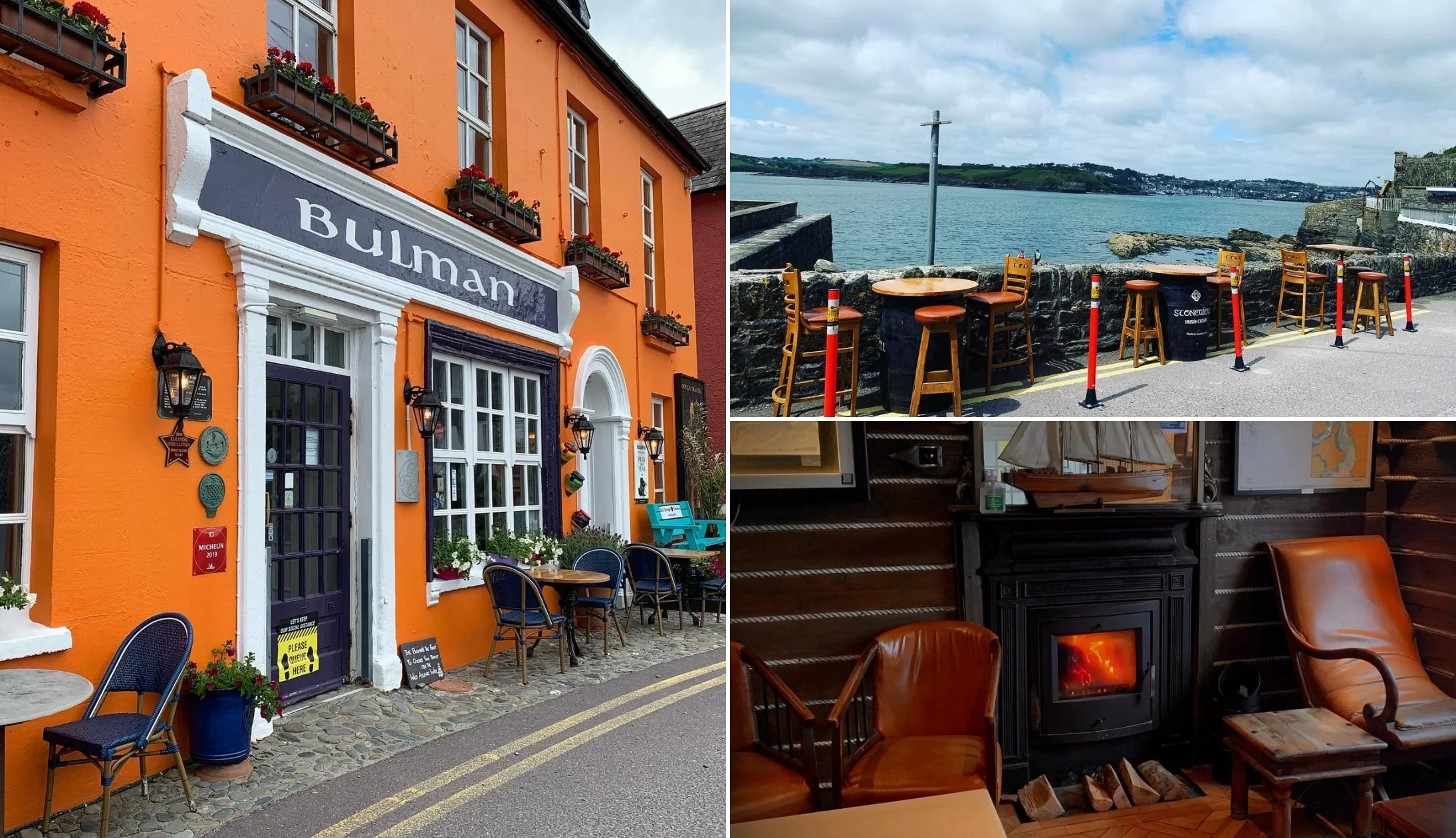
Photos via the Bullman on FB
The Bulman is a wonderful restaurant right next to an idyllic little harbour.
They have a varied menu, with everything from Thai green chicken curry, to local BBQ pork ribs with wasabi slaw. Since it’s one of the last days of your trip, consider treating yourself to grilled lobster, a customer favourite!
The restaurant kitchen is open Tuesdays to Saturdays from 12:30pm. They are closed on Sundays and Mondays.
The roads to The Bullman from Charles Fort are quite narrow, so we recommend leaving the car at the fort and enjoying the 5-minute stroll to the restaurant.
Stop 6: The trip to Cobh

Photos via Shutterstock
After lunch, hop in the car and make your way to Cobh, a historical coastal town on an island in Cork City harbour. There are two ways to get there, you can either a) go via Cork City and take the motorway, or b) drive to Passage West and take a ferry across.
The ferry in Passage West leaves from Glenbrook Wharf with non-stop crossings from 6:30am – 9:30pm every day (times may change).
We’d recommend either parking in the Cathedral Car Park here or on the street nearby, but it’s a bit of a downhill walk (around 7 minutes) to the Titanic Experience.
Stop 7: Titanic Experience

Photo left: Shutterstock. Others: Via Titanic Experience Cobh
Cobh was the last stop of the Titanic before it departed for New York. The Titanic Experience gives visitors an immersive insight into what life was like aboard the Titanic.
It includes a 30-minute tour where you’ll experience an incredible cinematographic experience of the ship sinking.
Aside from the tour, the experience has several exhibitions telling the personal stories of the passengers, the role of the RMS Carpathia in rescuing survivors, and much more.
Stop 8: St. Coleman’s Cathedral

Photos via Shutterstock
If you have the time (and energy) to walk up the hill to the cathedral. It’s a lovely building and the views over Cork Harbour are wonderful (this is where parking near the cathedral comes in handy as you’re basically walking back to the car!).
Cobh Cathedral, or St. Coleman’s Cathedral, is one of Cobh’s iconic landmarks. It’s a gorgeous cathedral with large stained-glass windows, intricate carvings, and an impressive 90-metre spire that dominates the town’s skyline.
It took 51 years from the first cornerstone being laid to the cathedral’s consecration. Building the cathedral was a mammoth project and cost well over the initial budget. It’s just as beautiful on the inside as it is from the outside, with large stone arches, pillars, and red marble shrines.
Stop 9: Back to Cork City for the night

Photos via Sin E on FB
From Cobh, it’s at least 30 minutes back to Cork City. You can either take the ferry or the motorway, but personally, we love the drive from Passage West into the city.
Our Cork food recommendations
There are heaps of brilliant restaurants in Cork City, but our personal favourites are Market Lane, Old Town Whiskey Bar at Bodega, and Cornstore.
Market Lane has a delicious-sounding menu featuring Irish favourites like pan-fried hake with braised leeks, smoked mussels, and baby potatoes.
Head to Old Town Whiskey Bar for burgers, salads, and traditional pub grub, and Cornstore for steaks and seafood.
Great Cork City pubs
There’s some glorious pubs in Cork, too. For drinks check out Mutton Lane (a quirky traditional pub), The Oval (a historic pub named after its unique oval ceiling), and Castle Inn (a traditional family-run pub with a great atmosphere).
There are some great spots for hearing some trad music in Cork, our top choices are Sin E and The Corner House.
Day 7: The Rock of Cashel and Dublin

Photos via Shutterstock
You’re halfway through your trip, and it’s time to say goodbye to Cork City and head to Ireland’s vibrant capital, Dublin. You’ll be stopping at the Rock of Cashel along the way to break up the journey.
Get yourself some breakfast at your accommodation before you check out and start driving. Or, if you’re after some great coffee and a pastry, Alchemy and Filter Coffee are both great choices.
One thing to note for the drive to Dublin is that you’ll be passing through two tolls. So make sure you have euro coins or a contactless card.
Recommended accommodation in Dublin
- Budget: Abigail’s Hostel (Temple Bar), Jacobs Inn (central hostel) and the Generator Hostel (short walk from the city)
- Mid-range: Dublin Skylon Hotel (just outside the city), Wren Urban Nest (Temple Bar) and the Harding Hotel (very central)
- Luxury: The Merrion (St. Stephen’s Green – very central) and The Westin (just off Grafton Street)
Getting around Dublin + money savers
- Time savers: If you want to avoid walking where possible, it’s worth getting a ticket for the Hop On Hop Off Bus around Dublin. It goes to or near all of the main sites on this itinerary plus plenty more.
- Money saver: If you’re visiting the ‘main’ Dublin attractions, the Dublin Pass can save you €€€ (here’s how)
Stop 1: Rock of Cashel
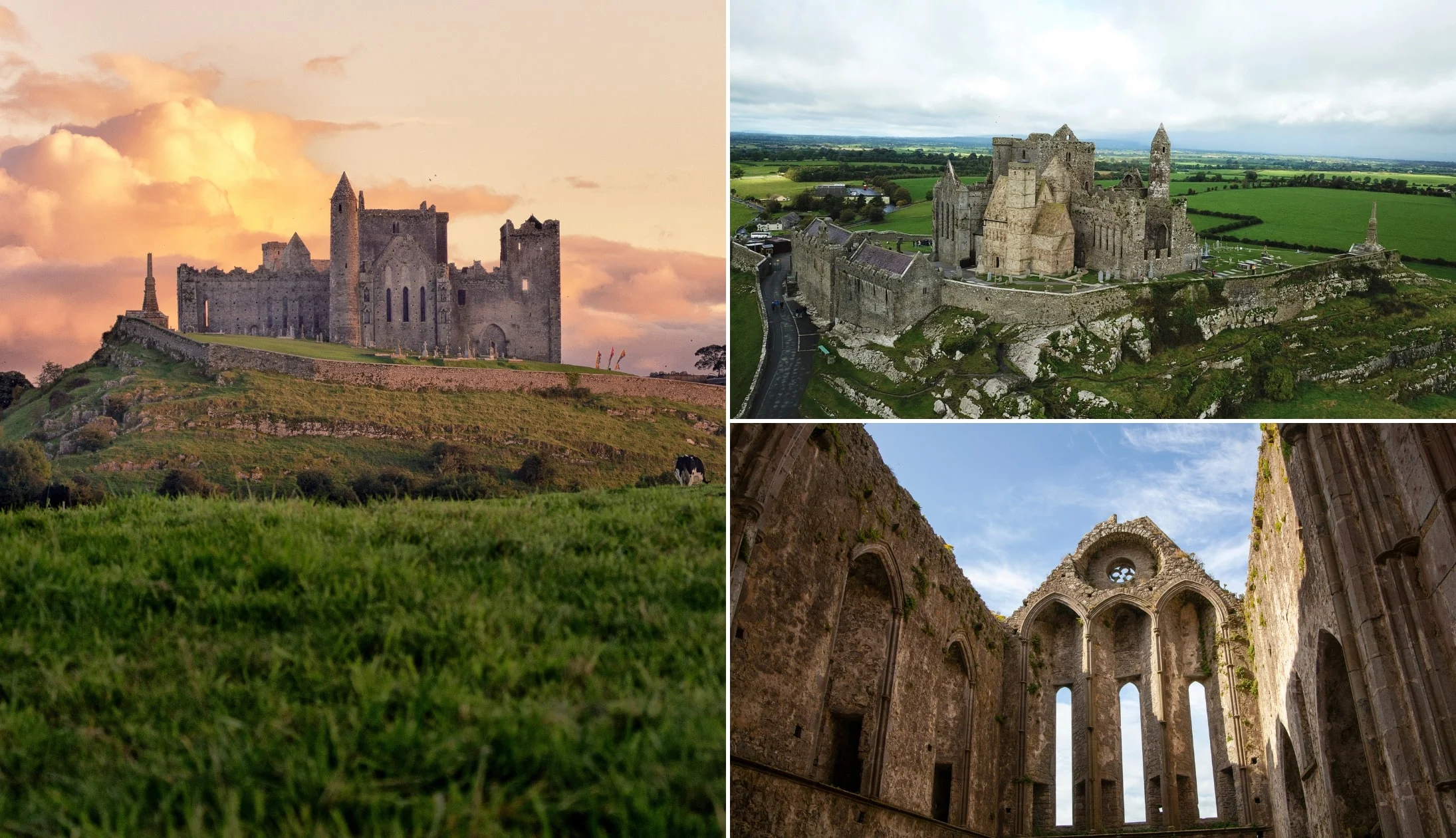
Photos via Shutterstock
The Rock of Cashel is around one hours drive from Cork City. It’s a spectacular historical site that’s perched dramatically on top of a limestone outcrop. On clear days the drive up has some spectacular views.
The site includes a high cross, a Romanesque chapel, an abbey, a Gothic cathedral, and several other buildings and monuments.
The site was originally the seat of the kings of Munster, but in 1101, it was granted to the church. After this, the Rock of Cashel quickly became one of the most important ecclesiastical centres in Ireland.
The area is shrouded in legend, and it’s said that Saint Patrick himself visited to convert King Aenghus to Christianity. Another legend says that while St. Parick was in nearby Devil’s Bit, he banished Satan from a cave, and caused the rock to land at Cashel.
Stop 2: Dublin City
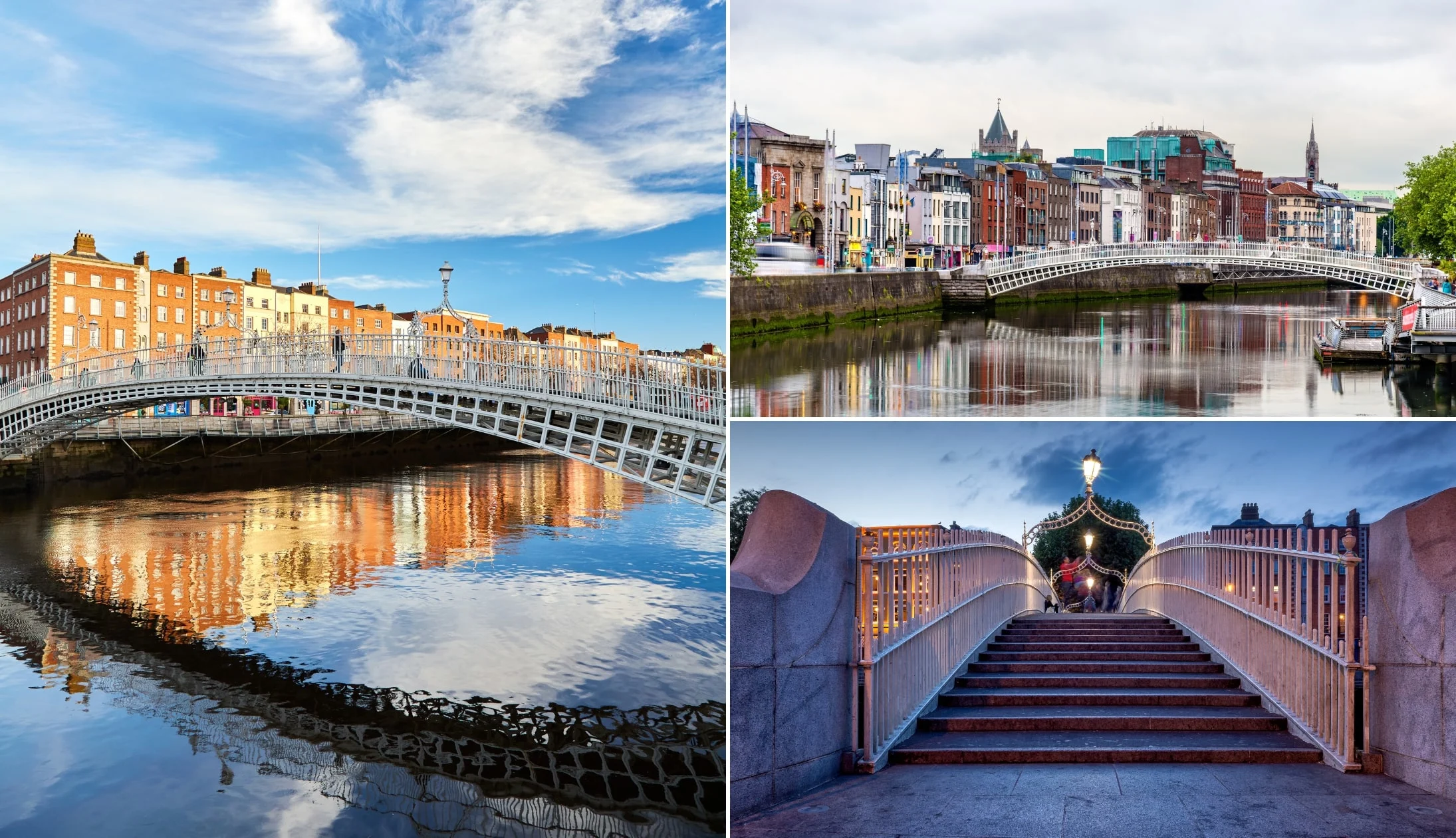
Photos via Shutterstock
From the Rock of Cashel, it’s a 2-hour drive to Dublin. Once you arrive into the city (welcome!), head to your accommodation to check in and park the car. The rest of today you’ll be exploring the city on foot, so wear appropriate footwear.
Stop 3: Lunch

Photos © Tourism Ireland
There’s plenty of great restaurants in Dublin that serve up a delicious lunch, but if you fancy a tasty bite in a lovely old-world-style pub, Neary’s just off of Grafton Street is hard to bate!
They serve simple dishes (like soups and sandwiches) that are packed with flavour and great value for money. Alternatively, Sprout and Co. on Dawson St. is also a great choice.
They have a range of hearty salad bowls, with good options for vegetarians and vegans.
Stop 4: Trinity College

Photos via Shutterstock
Now you’re all fuelled up, it’s time to head to Trinity College to see the Book of Kells, arguably the most famous cultural attraction in Dublin.
If you can, we highly recommend pre-booking your tickets online, as the queues can get really long (bordering on ridiculous!). This fast-track ticket allows you to dodge the queue and gets you into Dublin Castle, too!
Spend around one hour seeing the Book of Kells, walking around the exhibit, and taking in the beauty of the Old Library. After that, give yourself another 20 minutes or so to walk around the university campus.
Stop 5: Christ Church Cathedral
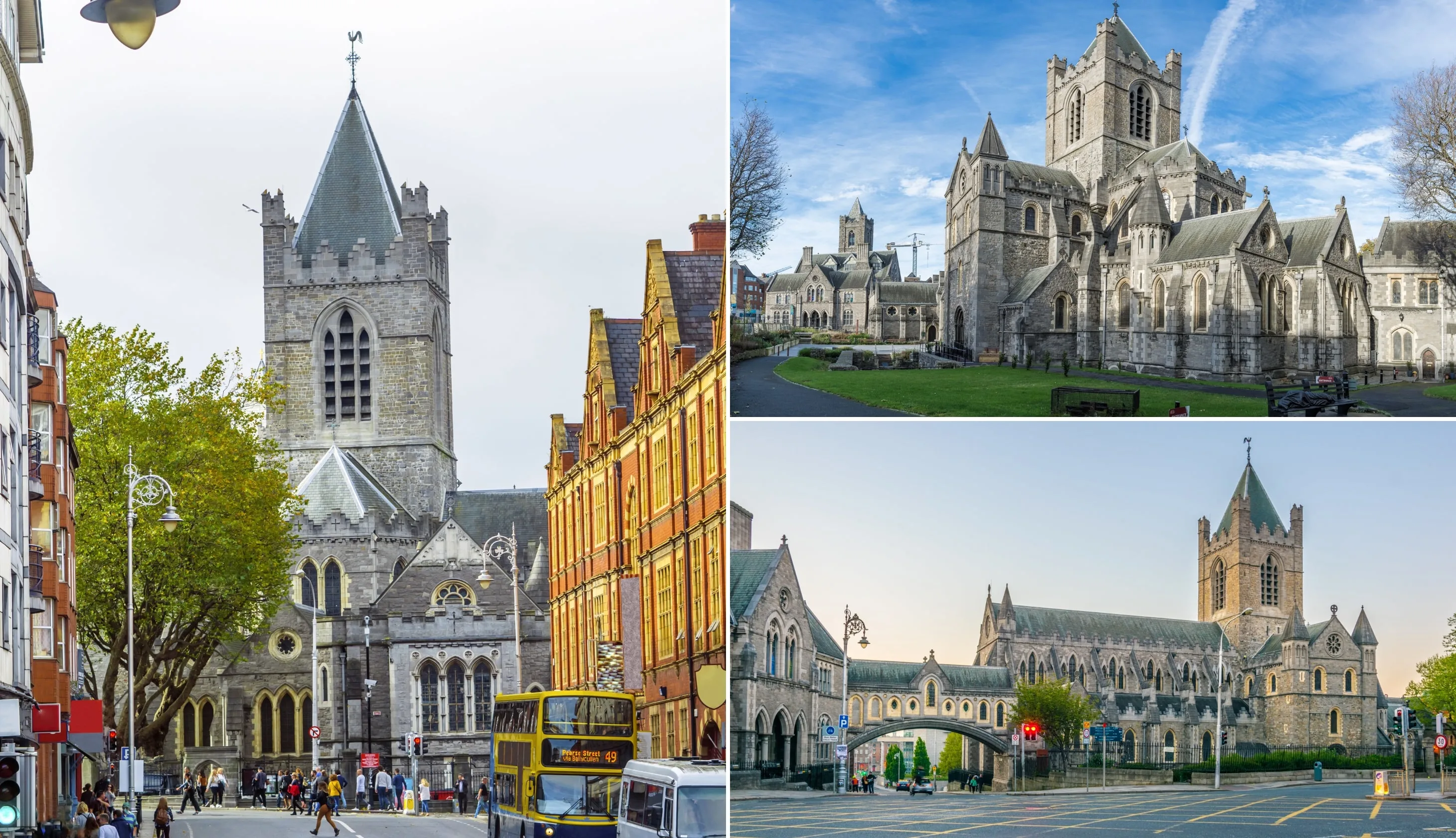
Photos via Shutterstock
Christ Church Cathedral dates back to the early 11th century when it was founded under Sigtrygg Silkbeard, a Norse King of Dublin. It was rebuilt later in stone, largely thanks to the first Anglo-Norman archbishop, John Cumin, in the late 12th century.
The cathedral is only a 10-minute walk from Trinity College and a really interesting place to visit. Some highlights are the restored crypt houses, Strongbow’s tomb, and the Treasures of Christ Church exhibition.
You can grab a ticket online here – these include an audio guide that comes in several languages, with three themes to choose from – ‘Power and Politics’, ‘Music and Spirituality’, and ‘Christ Church and the City’.
Self-guided tours with an audio guide usually last around one hour.
Stop 6: Guinness Storehouse

Photos © Diageo via Ireland’s Content Pool
The next stop is the Guinness Storehouse, a 17-minute walk from the cathedral. It’s at St. James’s Gate, the home of Guinness, and there are several tours available.
We recommend the Guinness Storehouse Experience, a self-guided tour that takes roughly 90 minutes.
You’ll learn about Guinness’ history, its ingredients, and get to enjoy a pint of Guinness and one other Guinness beer (for ages 18+) whilst taking in the views of the Gravity Bar.
Stop 7: Dinner, drinks and live music
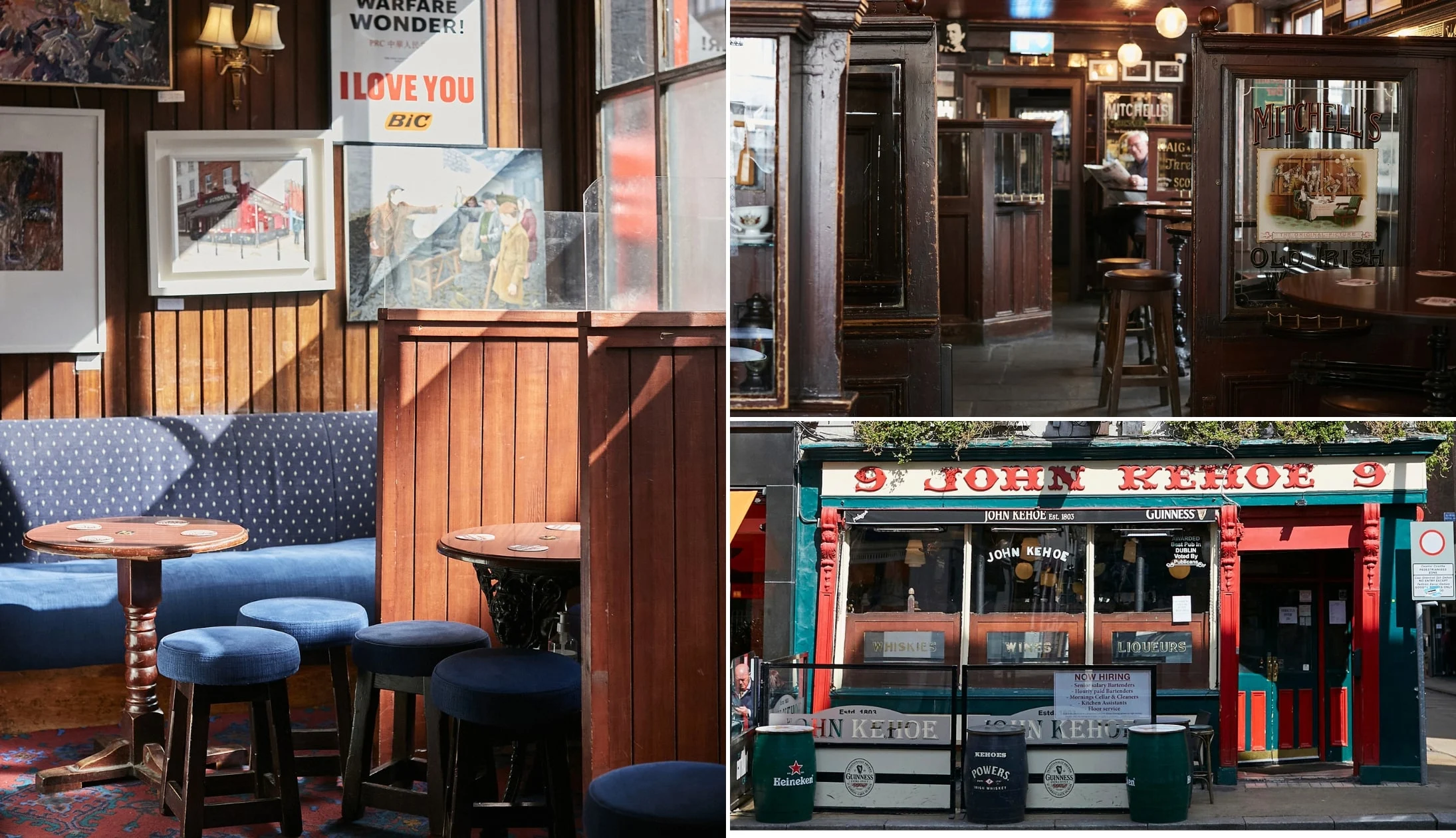
Different trad bars in Dublin. © Tourism Ireland
By now you must be getting hungry. Dublin has heaps of options for dinner, but we’ve got a couple of suggestions for you!
Our dinner recommendations
If you’re looking for something close by, Spitalfields is a short walk from the cathedral. It’s a little bit pricey, but the atmosphere is great and the food is top-notch!
However, Spitalfields is 16+ only, so it’s not suitable for young families. Otherwise, check out The Bull and Castle across the street from Christ Church Cathedral.
Their menu has F.X. Buckley Steaks (renowned in Dublin), plus a great selection of local craft beers. The restaurant can get booked out pretty quickly, but you can always eat in the bar upstairs, which also has steak on the menu.
Live music and trad bars
If you want a taste of what Dublin’s best pubs are, see our detailed Dublin pubs guide. If you’re solely looking for places that do exceptional Guinness, see our guide to Dublin’s best pints.
If you fancy a bit of live music, there’s plenty on offer. Pipers Corner on Marlborough St. has some great tunes, with live music from 9pm every Tuesday to Saturday, and from 8pm on Sunday.
The inside has more of a modern feel, but you’ll be guaranteed authentic Irish music.
For the full experience, O’Donoghues Bar on Merrion Row has live music every night of the week. It’s about as traditional as Irish pubs get, with a brilliant atmosphere.
The Celt is another fantastic pub with live music every night from 9pm, although it’s not always traditional.
Day 8: Wicklow’s Wonders
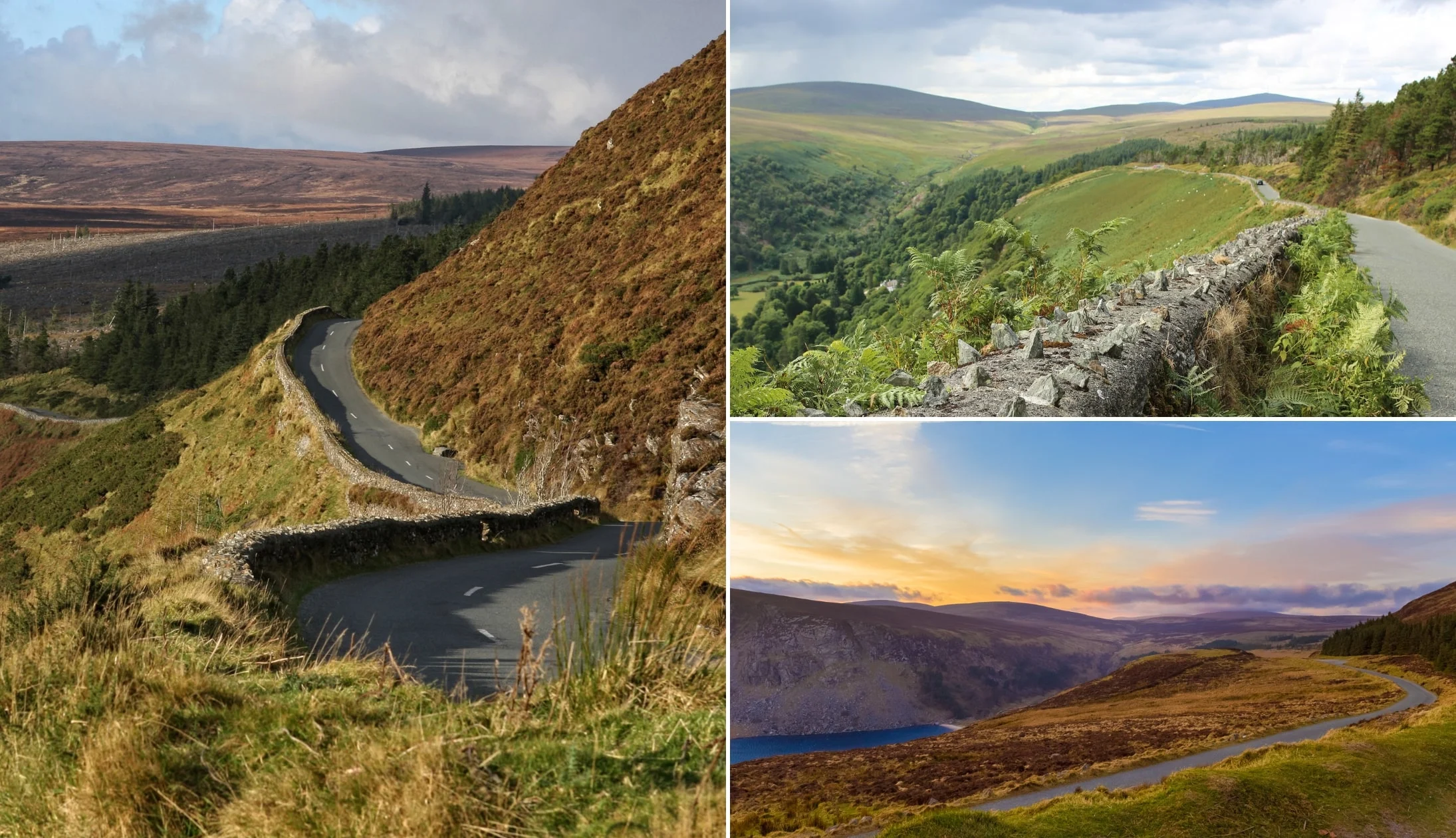
Photos via Shutterstock
On day 8 of your 12 days in Ireland itinerary, you’ll be exploring Wicklow, also known as the Garden of Ireland.
Get yourself some breakfast either where you’re staying or at a cafe nearby. Then, double-check there’s a good amount of fuel in the car before heading to beautiful Wicklow via the Sally Gap Drive.
Stop 1: The Sally Gap Drive (multiple stops)

Photos via Shutterstock
The glorious Sally Gap Drive can’t be missed and you’re best off doing it either before you head to Glendalough if you’re up early, or after, on your way home.
The reason for this is that you’re best off getting to Glendalough as early as you can, as it tends to get very busy at times.
When you do get to do the drive, aim for Lough Tay, first. Also known as Guinness Lake, Lough Tay is the jewel in Sally Gap’s crown!
From here, follow the winding road down, over the PS I Love You bridge and around until you reach a car park (on your right).
From here, very carefully walk around and get an eyeful of Glenmacnass Waterfall before heading on to Glendalough.
Stop 2: Glendalough Visitor Centre and Monastic City
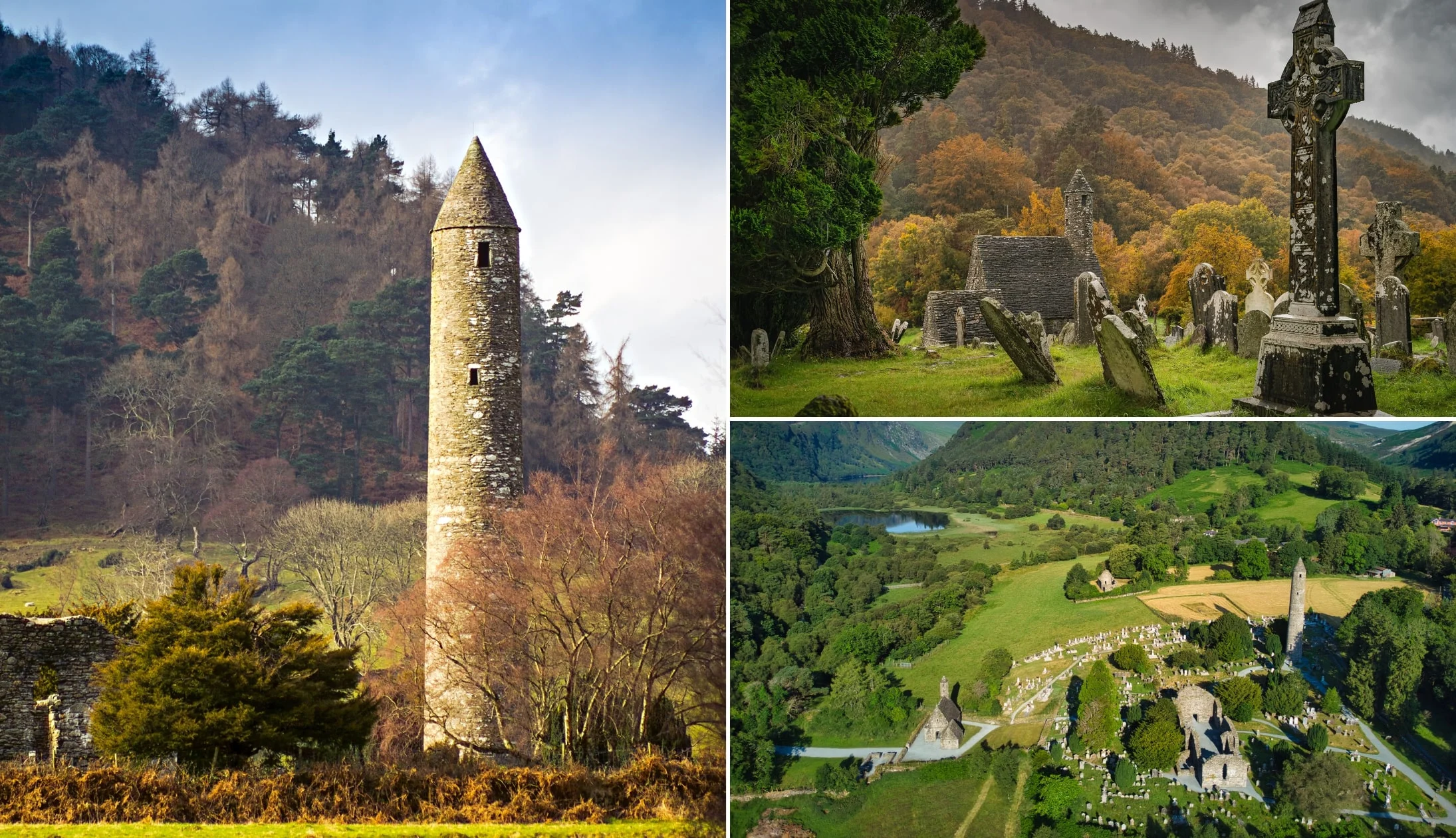
Photos via Shutterstock
Park up at the Glendalough Visitor Centre (the Lower Car Park – €4) and plan to spend between one and 30 – 45 minutes exploring the centre and the ‘Monastic City’ (your next stop).
The visitor centre is right next to the Monastic City, one of the most important monastic sites in the country. The city was founded by St. Kevin in the 6th century and went on to become one of Europe’s most famous religious sites!
At the centre, there’s a wonderful exhibition on the history of Glendalough and St. Kevin. There’s also an interesting 15-minute long audio and visual presentation about early Irish Saints and monasteries.
Now you’ve learned about the site, it’s time to take a 2-minute stroll to the Monastic City next door. Whilst the remains of the city are scattered all across the glen, many of the main ruins and features are within walking distance of the visitor centre.
These include the Glendalough Round Tower, one of the city’s most well-known landmarks. It stands 33 metres high and dates back almost 1000 years! Other attractions nearby include St. Kevin’s Church and the Glendalough Cathedral ruins.
Stop 3: Glendalough Upper Lake
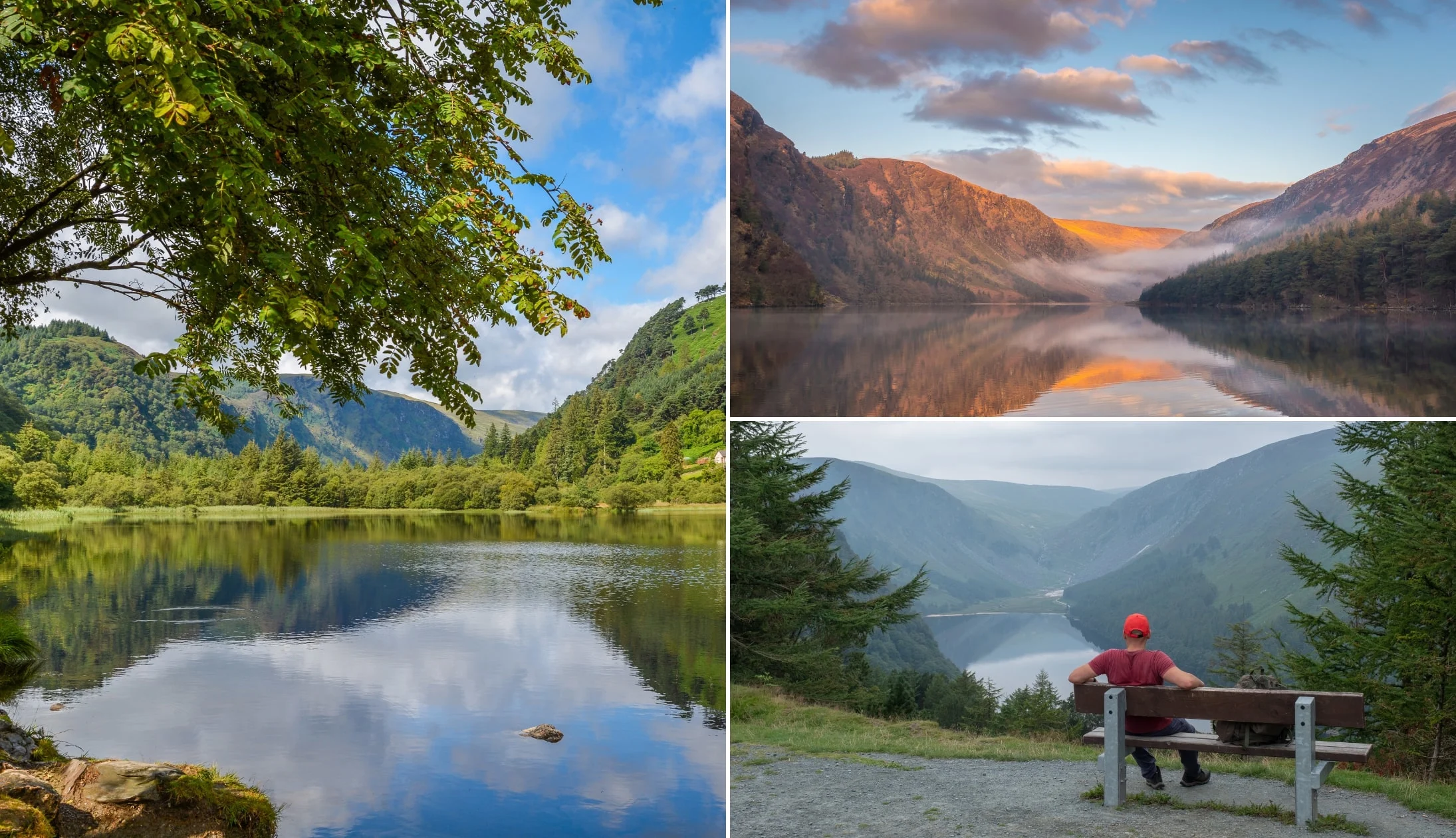
Photos via Shutterstock
Your next stop is Glendalough Upper Lake. You can either walk the 20 minutes from the Monastic City via the scenic Green Road, or if you’re too tired, grab the car and make the quick 2-minute drive. However, it’s important to note that the car park tends to fill up quickly (see parking here on Google Maps).
From the car park, there are two paths leading to the Upper Lake’s sandy shore. There are spectacular views from the lakeshore, and in the summer, it’s a popular place for a picnic and some paddling. We don’t recommend swimming as there are no lifeguards on duty, and paddlers should beware of sudden depth changes in the lake.
Stop 4: Lunch at the Wicklow Heather

Photo left: The Irish Road Trip. Others: Via Wicklow Heather
We absolutely love stopping by the Wicklow Heather for lunch whenever we’re in Glendalough. The restaurant is in the heart of idyllic Laragh, with a historical interior and some lovely outdoor seating areas.
The menu has traditional Irish dishes, like comforting seafood chowder or hearty cottage pies, with an option for vegetarians and vegans.
It’s just a 4-minute drive from the Glendalough Visitor Centre/Monastic City, and 6 minutes from the Upper Lake Car Park.
Stop 5: Powerscourt House and Gardens

Photos by Chris Hill via Failte Ireland
Once you’re nicely fed, hop in the car for the 35-minute drive to Powerscourt House and Gardens. Powerscourt House is a beautiful 68-room mansion nestled inside a 47-acre garden.
We’d recommend you give yourself at least two hours here to admire the house and to walk through the gorgeous gardens.
The current Powerscourt House was completed in 1741 under the watchful eye of the 1st Viscount Powerscourt. However, it was built around a 13th-century Mediaeval Castle belonging to the Le Power family, where ‘Powerscourt’ is derived.
Like the house, the gardens at Powerscourt are filled with grandeur and were voted by National Geographic as one of the world’s Top Ten Gardens!
Stop 6: Back to Dublin for the night

Different trad bars in Dublin. © Tourism Ireland
By now you must be getting hungry. Dublin has heaps of options for dinner, but we’ve got a couple of suggestions for you!
Our dinner recommendations
If you’re looking for something close by, Spitalfields is a short walk from the cathedral. It’s a little bit pricey, but the atmosphere is great and the food is top-notch!
However, Spitalfields is 16+ only, so it’s not suitable for young families. Otherwise, check out The Bull and Castle across the street from Christ Church Cathedral.
Their menu has F.X. Buckley Steaks (renowned in Dublin), plus a great selection of local craft beers. The restaurant can get booked out pretty quickly, but you can always eat in the bar upstairs, which also has steak on the menu.
Live music and trad bars
If you want a taste of what Dublin’s best pubs are, see our detailed Dublin pubs guide. If you’re solely looking for places that do exceptional Guinness, see our guide to Dublin’s best pints.
If you fancy a bit of live music, there’s plenty on offer. Pipers Corner on Marlborough St. has some great tunes, with live music from 9pm every Tuesday to Saturday, and from 8pm on Sunday.
The inside has more of a modern feel, but you’ll be guaranteed authentic Irish music.
For the full experience, O’Donoghues Bar on Merrion Row has live music every night of the week. It’s about as traditional as Irish pubs get, with a brilliant atmosphere.
The Celt is another fantastic pub with live music every night from 9pm, although it’s not always traditional.
Day 9: Mighty Meath and Louth

Photos via Shutterstock
On day 9 of the 12 days in Ireland itinerary, you’ll be heading out to County Meath to explore the Boyne River Valley, known for its archaeological sites.
Today, we recommend getting breakfast either at your accommodation or a nearby cafe. There won’t be places to grab a bite near your first stop, so it’s best to eat before you leave Dublin.
Stop 1: Newgrange

Photos via Shutterstock
Newgrange is a fascinating prehistoric monument and the main attraction in the Brú na Bóinne World Heritage Site. The neolithic passage tomb was built around 3200 BC, making it older than the Egyptian pyramids and Stonehenge!
From Dublin City Centre, it’s around a 45-minute drive (depending on traffic). We recommend setting out as early as possible to avoid traffic.
You can book your Newgrange Tour + Exhibition tickets here, pre-booking is essential. Please note, that you cannot go to the monuments directly. You must start at the Brú na Bóinne Visitor Centre. The Newgrange Tour is roughly one hour long.
Stop 2: Monasterboice

Photos via Shutterstock
Monasterboice is a 12-minute drive from Newgrange. The ruins date back to the late 5th century and were founded by Saint Buithe.
The Christian settlement was an important centre of religion and learning in the area up until 1142 when the Mellifont Abbey was founded.
Highlights of the settlement are the 28-metre round tower, two church ruins, and the magnificent 10th-century high crosses – the Muiredach’s Cross and the West Cross (the tallest in Ireland).
We recommend spending around 30 minutes here.
Stop 3: Hill of Slane
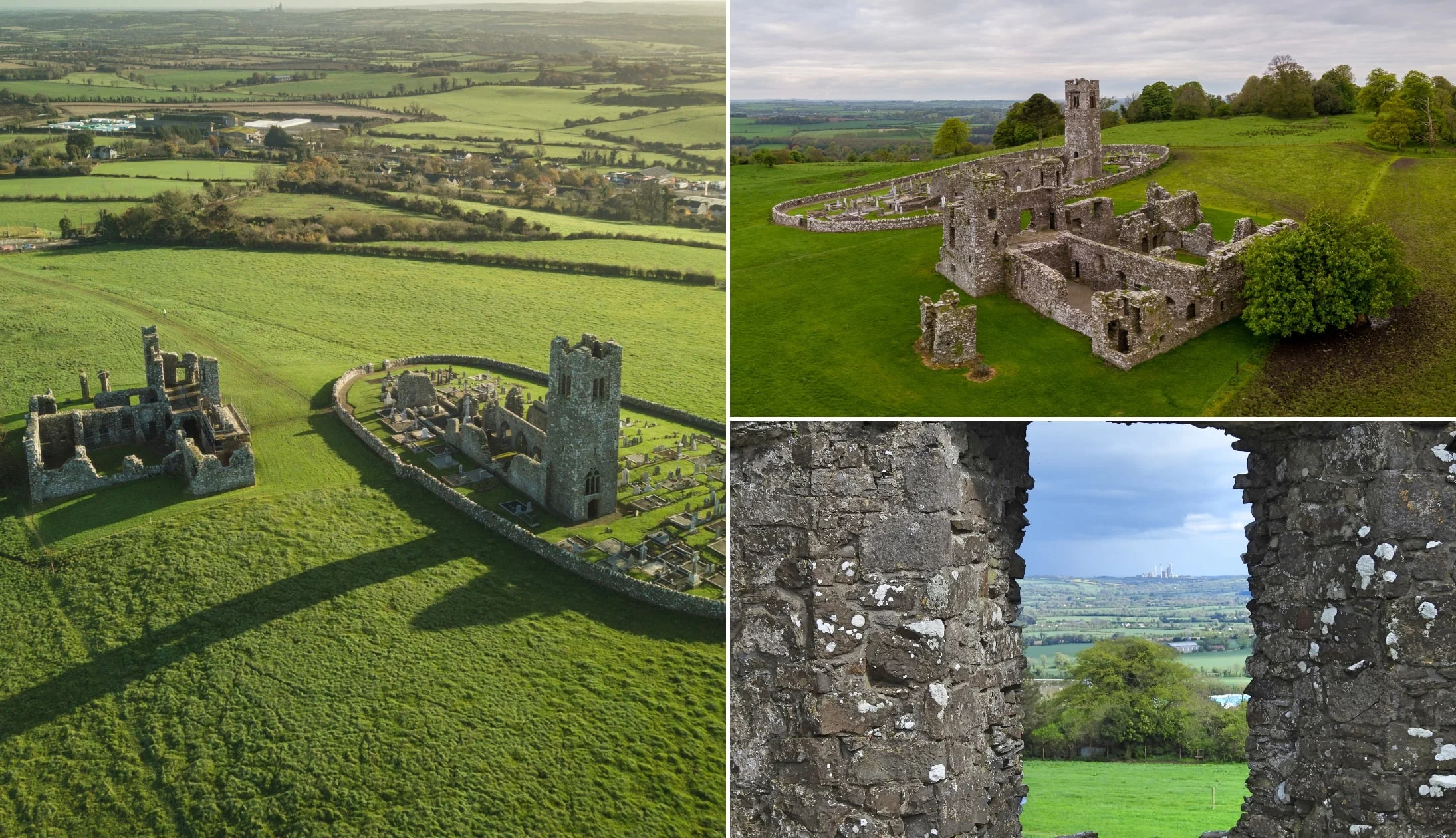
Photos via Shutterstock
The Hill of Slane is an incredibly important site, and a possible location for where St. Patrick lit the Paschal Candle, which represented Christianity coming to Ireland.
The site is home to 16th-century Franciscan Monastery ruins, built on top of an older monastery founded by St. Erc, one of St. Patrick’s followers.
It’s a 15-minute drive from Monasterboice, and we’d recommend spending between 30 minutes to an hour here, depending on how much you want to explore.
Stop 4: Lunch in Trim and Trim Castle

Photos via Shutterstock
From the Hill of Slane, drive 30 minutes to Trim to grab some lunch. Our top pick is Rosemary Bistro, which has a mixture of hearty dishes and lighter bites like sandwiches. Once you’ve eaten, head over to Trim Castle .
Trim Castle is Ireland’s largest Anglo-Norman fortification. It’s very impressive with an imposing presence. The Castle dates back to the 12th century and took Hugh de Lacy and his successors 30 years to complete.
It’s free to visit the castle grounds, but a guided tour of the keep costs €5 (adult), €4 (senior), €3 (student/child), and €13 (family). The tour is well worth it, especially for any Brave Heart fans, as parts of the movie were filmed there!
The castle is open daily between 10am and 5pm. We’d recommend at least 30 minutes to one hour here.
For lunch, check out the StockHouse Restaurant or Rosemary Bistro.
Stop 5: Bective Abbey
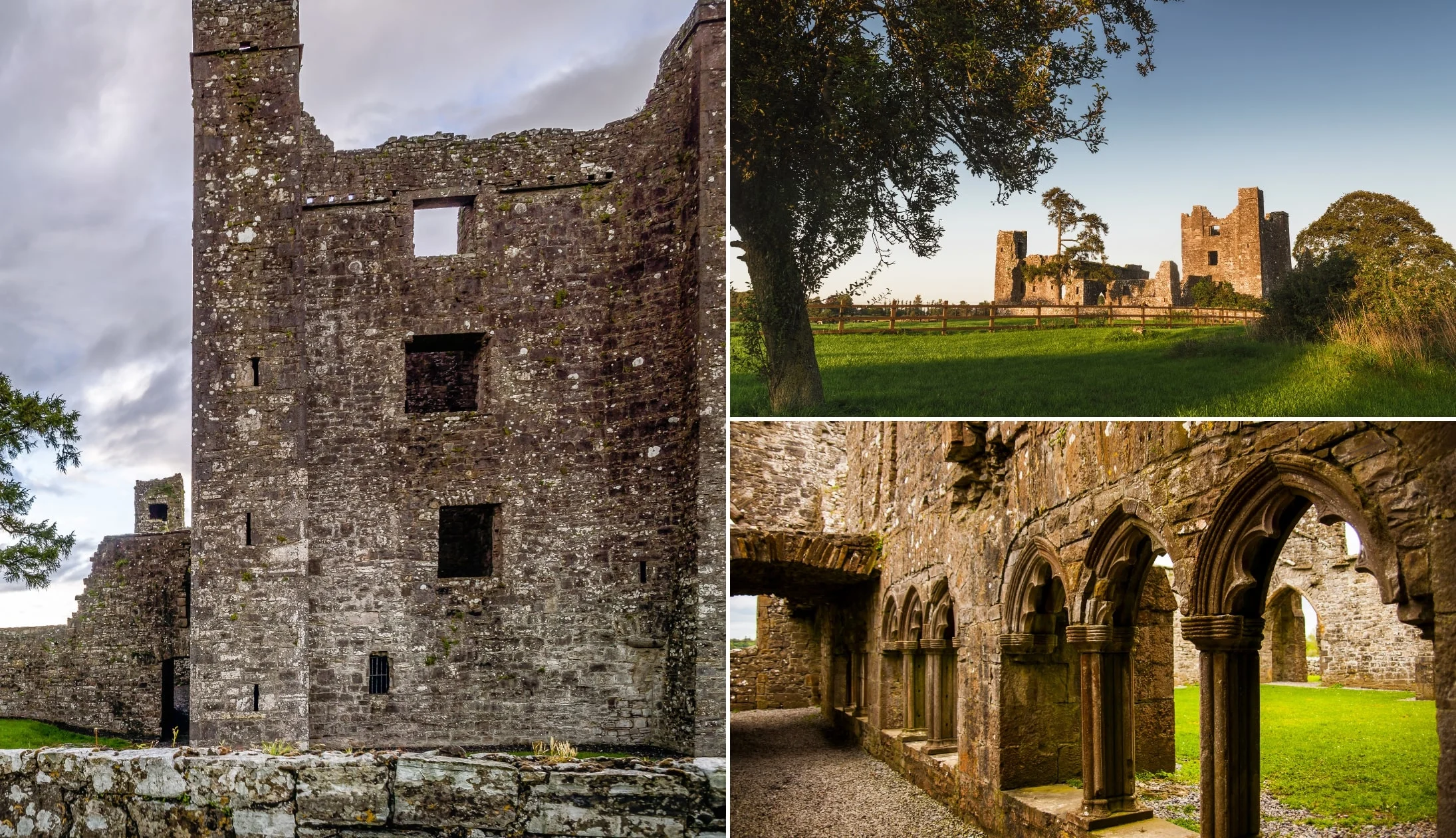
Photos via Shutterstock
The next stop is Bective Abbey, a 10-minute drive away. It was founded in 1147 for the Cistercian Order and became a significant monastic settlement.
The ruins you can see today mostly date back to the 13th and 15th centuries, with a chapter house, a church, and a cloister.
The ruins have been used several times in Hollywood movies. Most recently, in The Last Duel, which came out in 2020.
The abbey is free to visit with a designated car park. Give yourself around 30 minutes here.
Stop 6: Hill of Tara
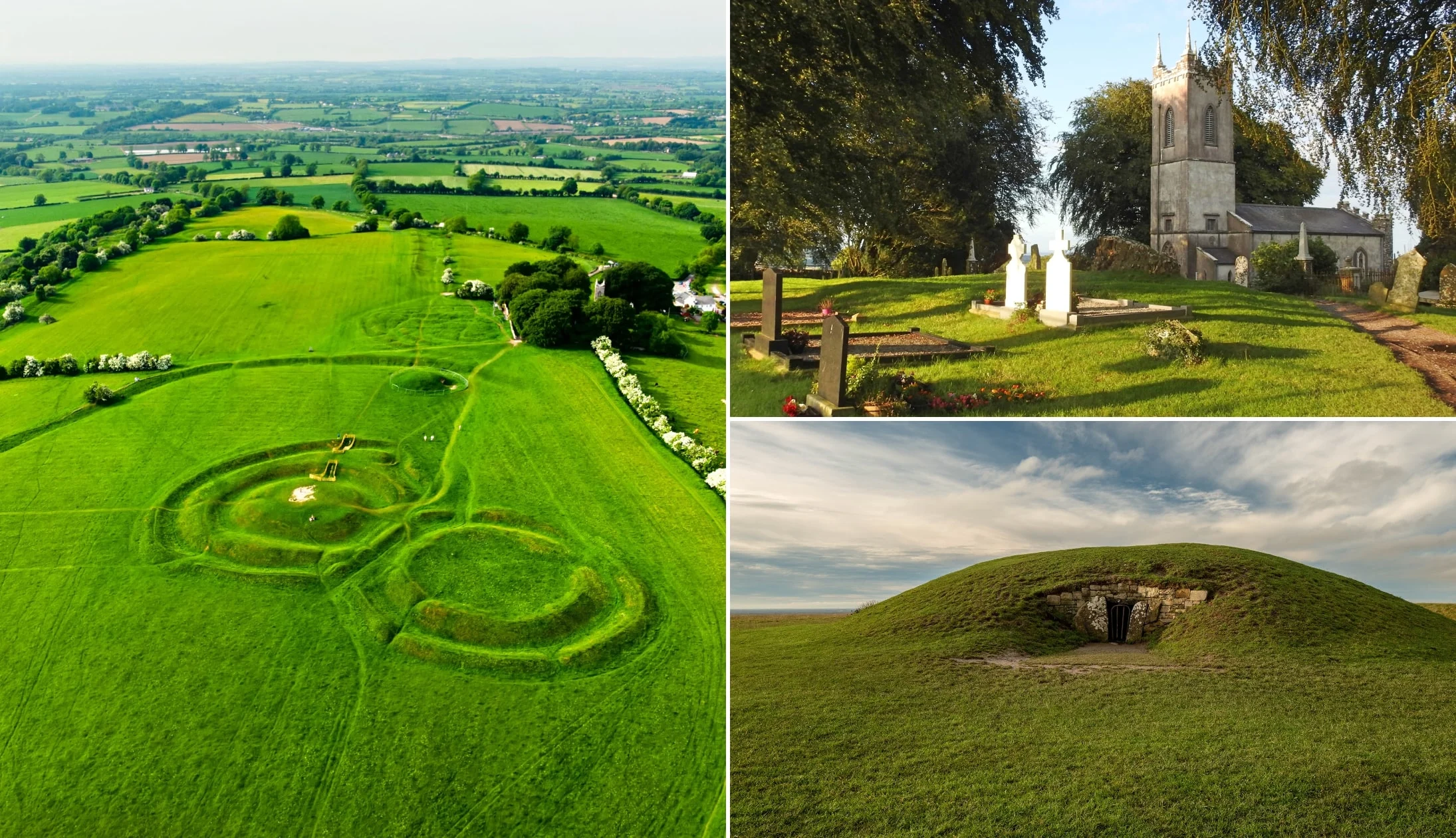
Photos via Shutterstock
The last stop of the day is the Hill of Tara. It’s a 12-minute drive from Bective Abbey and we’d say 30-45 minutes is a good amount of time to spend here.
The Hill of Tara has been in use since the late Stone Age, but it’s known best as the seat of the High Kings of Ireland, with all old Irish roads leading to the site!
The site is shrouded in myth, and the story of Conn of the Hundred Battles tells the tale of how the High Kings of Ireland came to be.
It’s free to visit, with a free 25-minute Audio Visual Show at the visitor centre (in the church), and free guided tours scheduled every day. The centre is open between 10am and 5pm year-round, but the site is open 24/7.
Stop 7: Back to Dublin for the night

Different trad bars in Dublin. © Tourism Ireland
From the Hill of Tara, it’s a 50-minute drive back to Dublin City Centre (depending on traffic).
Our dinner recommendations
If you’re looking for something close by, Spitalfields is a short walk from the cathedral. It’s a little bit pricey, but the atmosphere is great and the food is top-notch!
However, Spitalfields is 16+ only, so it’s not suitable for young families. Otherwise, check out The Bull and Castle across the street from Christ Church Cathedral.
Their menu has F.X. Buckley Steaks (renowned in Dublin), plus a great selection of local craft beers. The restaurant can get booked out pretty quickly, but you can always eat in the bar upstairs, which also has steak on the menu.
Live music and trad bars
If you want a taste of what Dublin’s best pubs are, see our detailed Dublin pubs guide. If you’re solely looking for places that do exceptional Guinness, see our guide to Dublin’s best pints.
If you fancy a bit of live music, there’s plenty on offer. Pipers Corner on Marlborough St. has some great tunes, with live music from 9pm every Tuesday to Saturday, and from 8pm on Sunday.
The inside has more of a modern feel, but you’ll be guaranteed authentic Irish music.
For the full experience, O’Donoghues Bar on Merrion Row has live music every night of the week. It’s about as traditional as Irish pubs get, with a brilliant atmosphere.
The Celt is another fantastic pub with live music every night from 9pm, although it’s not always traditional.
Day 10: The drive to Galway (via Athlone)

Photos by Stephen Power via Ireland’s Content Pool
Today, it’s time to say goodbye to Dublin and head over to beautiful Galway. The drive usually takes around two and a half hours, but you’ll be stopping in historic Athlone to break up the journey and do some sightseeing.
Recommended accommodation in Galway
- Budget: Feeney’s Audubon Lodge (in Salthill outside of the city by the sea) and Corrib View Guesthouse (a 45-minute walk from Eyre Square)
- Mid-range: Balcony House B&B (10-minute walk from Eyre Square) and Ash Grove House (gorgeous guesthouse near Galway Cathedral)
- Luxury: The G Hotel (luxury hotel in the city) and Glenlo Abbey (one of Ireland’s top hotels – 15-minute drive from the city)
Stop 1: Athlone Castle
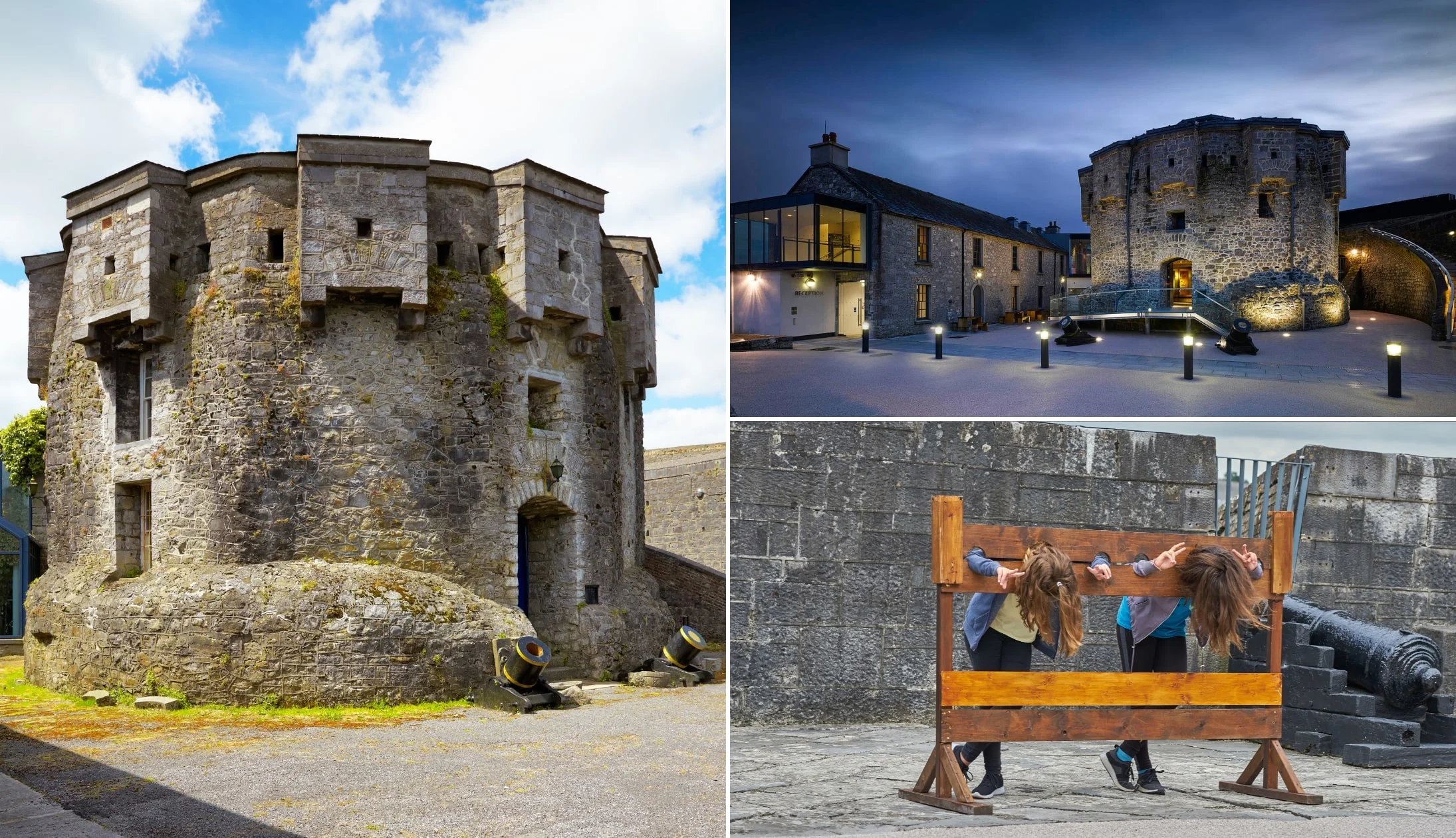
Top right photo: Ros Kavanagh via Failte Ireland. Others: Shutterstock
Athlone Castle is in the centre of Athlone on the banks of the River Shannon. There are two public car parks around the castle, as well as plenty of street parking if these get full (see parking here and here on Google Maps).
The stone castle is in great condition and dates back to the 13th century. It was in a key strategic position for defending the Athlone river crossing and played an important part in the infamous Siege of Athlone. The visitor centre is full of information about the castle’s history, with eight exhibitions.
The castle is open year-round, with seasonal opening times that you can check here. General admission costs €10 (adult), €7 (seniors and students), €5 (children under 15), €25 (family). Schedule in at least one hour here.
Stop 2: Sean’s Bar
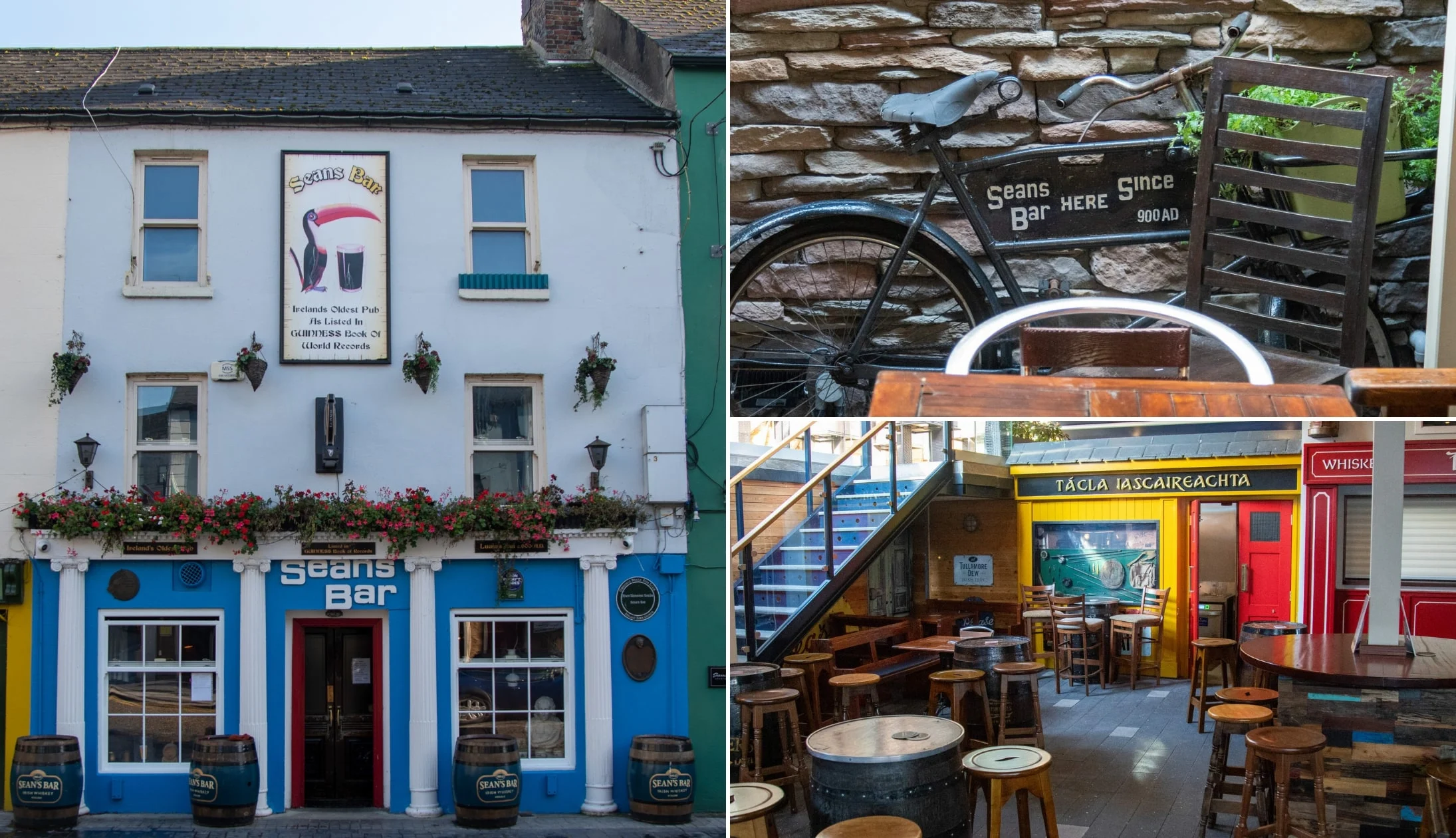
Photos courtesy Sonder Visuals via Ireland’s Content Pool
Sean’s Bar is right next to the castle and just a one-minute walk away. The pub is a must-visit when in Athlone, as it’s officially recognised by the Guinness Book of World Records as the oldest pub in Ireland (and possibly the world!).
It dates back to 900 AD when it was opened by a man named Luain Mac Luighdeach. Inside, it’s a treasure trove of history, plus, they serve a fantastic pint of Guinness.
Stop 3: Lunch

Photos via Beans & Leaves on FB
By now, you must be hungry, so it’s time to find somewhere for a bite to eat. Our favourite places for lunch in Athlone are The Left Bank Bistro (modern Mediterranean and Asian), Beans and Leaves (all-day-breakfast and Irish cuisine), and Corner House Bistro (gourmet sandwiches and international cuisine). All of these are within short walking distance of Sean’s Bar.
Stop 4: Galway City

Photos by Stephen Power via Ireland’s Content Pool
From Athlone, Galway City is one hour’s drive. Once you’ve arrived (welcome!) It’s time to check into your hotel and head out to explore this charming city on foot.
Stop 5: Check-in, get lunch and decide between walking/the bus
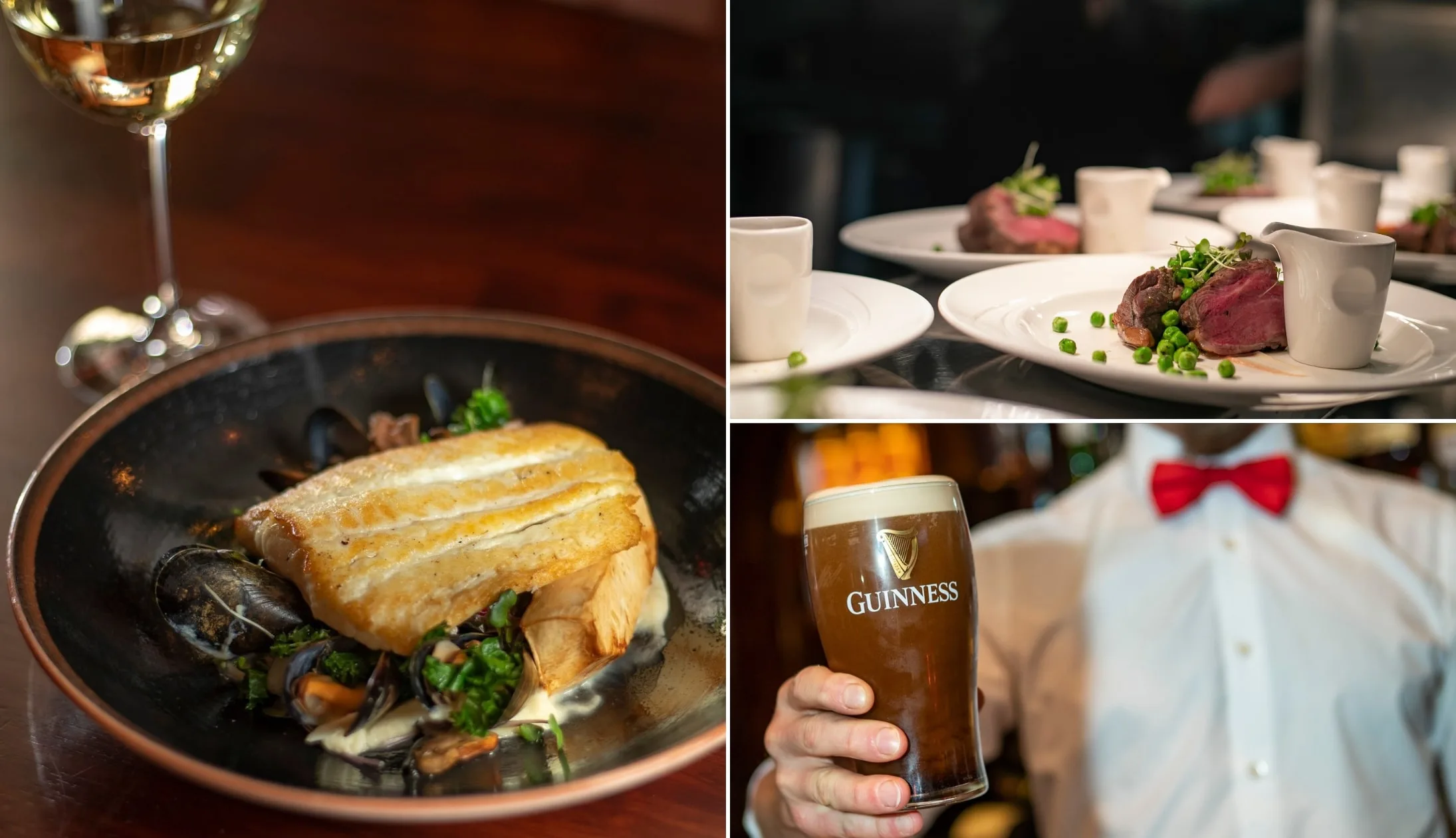
Photos via Blakes Bar Galway on FB
When you land in Galway, head to your accommodation, get checked in and head for lunch.
By now, you must be hungry. There are heaps of brilliant places for lunch in Galway, but if you don’t want the hassle of finding somewhere to eat, we’ve got a few suggestions!
We recommend Blakes Bar (traditional pub grub), Zappis (authentic Italian cuisine), or Tigh Neachtain (Irish and international cuisine).
Now, Galway is a very walkable city, but if it’s raining or if you fancy getting dropped to the ‘main’ attractions the hop-on/hop-off bus tour is well worth buying.
Regardless of which option you choose, here are some of our favourite sites in Galway City (we’ve listed them in a logical way for you to walk between them).
Stop 6: Galway Cathedral

Photos via Shutterstock
Galway Cathedral is wonderfully impressive both inside and out. It’s arguably the jewel in the Galway City skyline and you’ll cop it from many places as you stroll around the city.
Interestingly enough, it’s not as old as it looks, and construction on the building was only completed in 1965, earning it the title of ‘the last great stone cathedral to be constructed in Europe’.
The cathedral is free to enter, but visitors are asked for a donation of €2 to help with the building’s upkeep.
Stop 7: Quay Street and the Latin Quarter

Photos by Stephen Power via Ireland’s Content Pool
Galway’s colourful streets are an absolute joy the ramble along regardless of the time of year.
If you’re walking from the cathedral, you’re a short stroll away from the Latin Quarter and Quay Street where you can have a nosey around.
These streets are alive with the buzz from tourists and locals alike.
Stop 8: The Hall of the Red Earl
One of our favourite places to visit in Galway (especially if it’s raining!) is the Hall of the Red Earl.
The Hall of the Red Earl is one of Galway’s most interesting sites. The ruins date back to the 13th century, with ties to the founding of Galway and the Anglo-Norman De Burgo family.
It was the first municipal building in the city, used for collecting taxes, hosting banquets, and sentencing criminals.
The Hall of the Red Earl was lost as the city grew until 1997, when the ruins were unearthed by archaeologists on behalf of the Office of the Public Works.
Today, you can walk amongst the ruins, view the artefacts, and learn about the hall’s history from the informative displays.
Stop 9: Galway City Museum
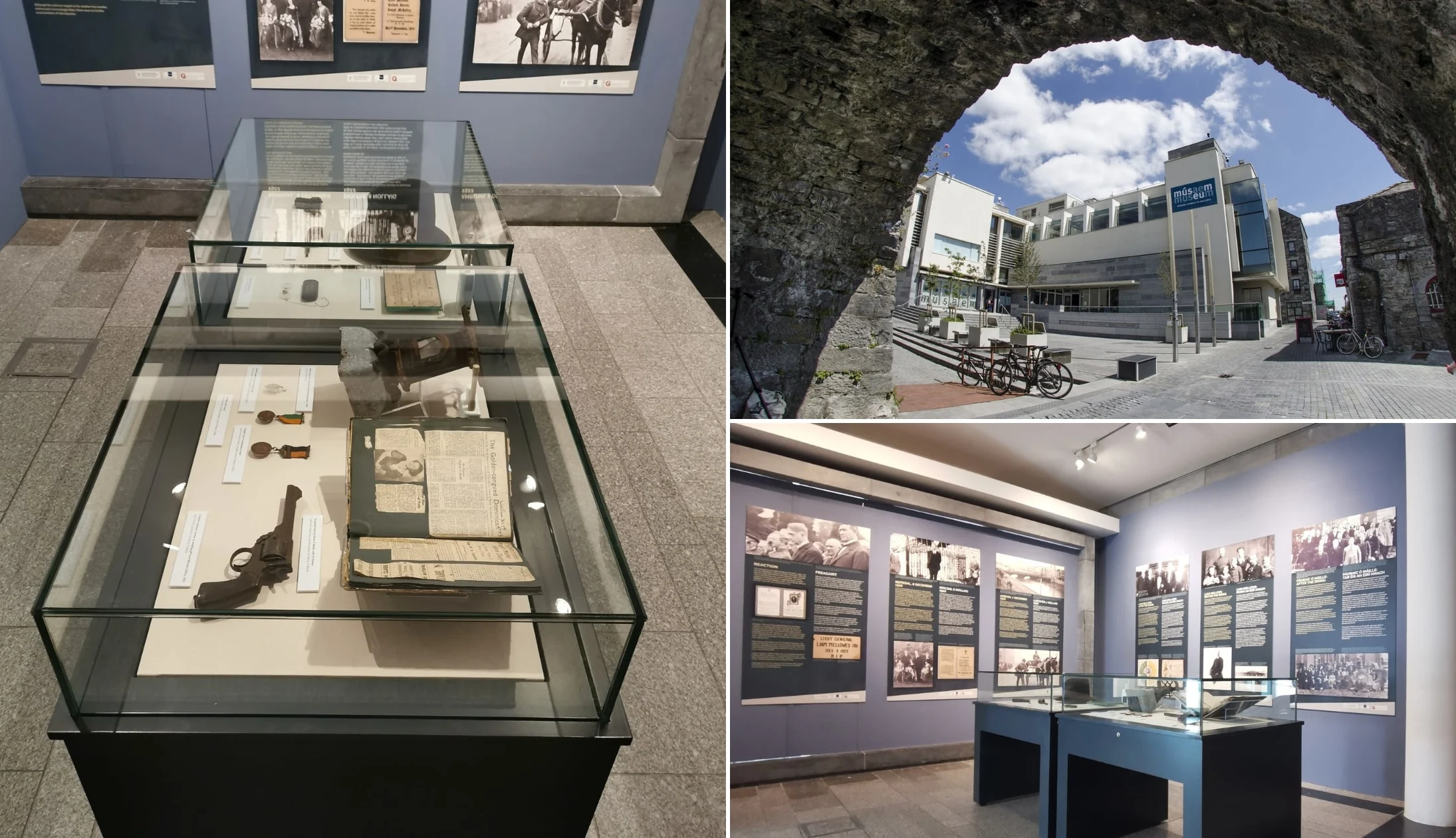
Photos via Galway City Museum on FB
The Galway City Museum is just a stone’s throw from the Spanish Arch. It’s one of the best places to learn about Galway’s history, culture, and archaeology, with collections telling the story of prehistoric Galway all the way through to 19th and 20th-century Galway!
The museum has three floors and seven long-term exhibitions, including The Wild Atlantic – Sea Science, and an exhibition on Pádraic Ó Conaire.
It’s free to visit, although donations are always appreciated.
Stop 10: Spanish Arch and the Long Walk
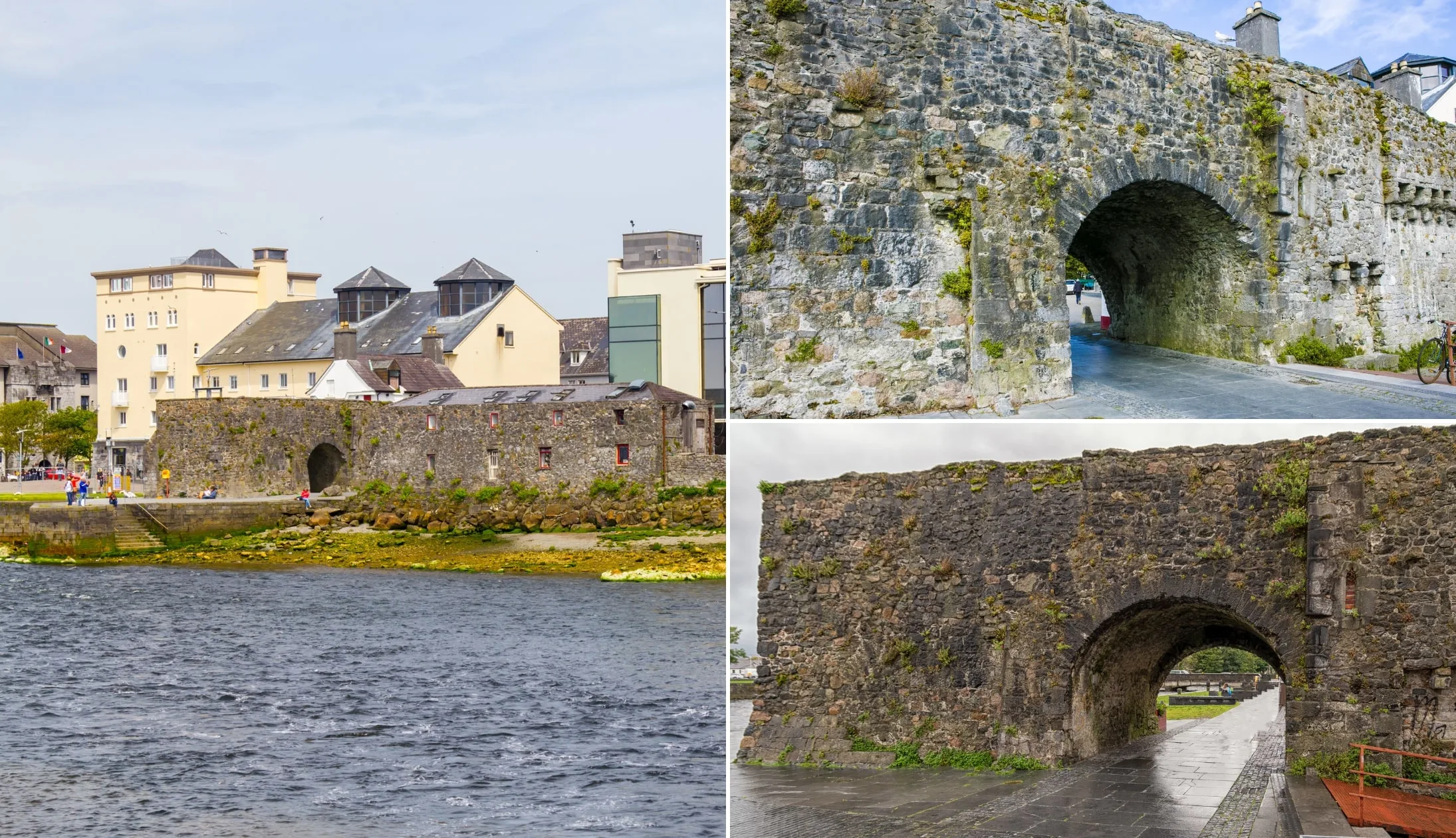
Photos via Shutterstock
The Spanish Arch is a must-see Galway attraction, dating back to Medieval times. The large stone arch is located on the outskirts of the city centre, overlooking the Claddagh (shore).
It originally housed soldiers who were keeping watch on the city’s Medieval walls. Its nickname is thought to come from the city’s merchant trade with the Spanish, whose ships would often be docked in the area!
From the Spanish Arch, you can take a short stroll alongside the water to what’s known as The Long Walk. You’ll likely have seen pictures of it (it’s a line of colourful buildings right on the water).
Stop 11: Dinner, drinks and live music
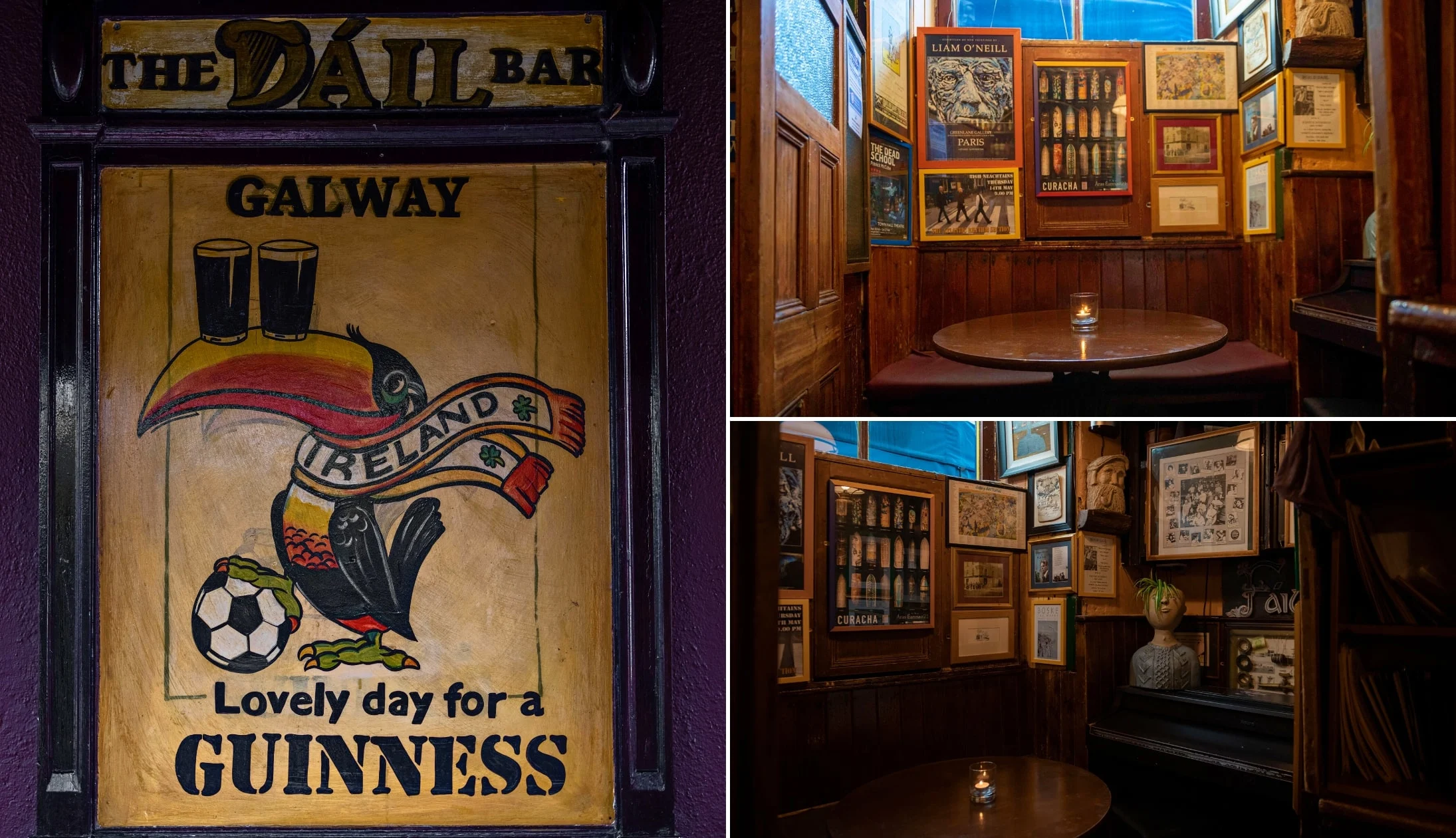
Photos courtesy Failte Ireland
You’ve had a busy aul day today, so it’s time to kick back and chill with food and, if you fancy, a drink and some live music.
Galway is a lively city regardless of the time of year. Here’s some spots worth checking out:
Our dinner recommendations
For dinner, we’ve got a few stellar recommendations: Ard Bia, The Quay Street Kitchen, and Dela. Ard Bia is absolutely fantastic, but you need to book in advance for dinner.
The restaurant has a quirky interior and serves beautifully presented modern dishes.
The Quay Street Kitchen has a great selection of vegan and vegetarian-friendly dishes, and Dela has modern Irish cuisine on the menu.
Live music and trad bars
There’s some mighty pubs in Galway. After dinner, head out for drinks at either Tigh Neachtain or The Crane. Both are traditional pubs with a great atmosphere.
Trad music is an integral part of the city, with heaps of options to choose from. Our favourite spots are Crane Bar (mentioned above) and Tigh Chóilí.
Day 11: North Clare

Photos courtesy of Chaosheng Zhang
You’re saying goodbye to Galway today and heading over to Doolin for a night. The total drive time is less than 2 hours depending on whether you take the coast road. But we have lots of places for you to stop on the way!
Doolin is a lovely village on Ireland’s west coast, known for its trad music. It’s got some lovely places to stay and we’ve popped out top picks below:
Doolin accommodation recommendations
- Popular and central stays: West Haven House (short stroll from McDermott’s Pub) and Cullinan’s Guesthouse (great reviews and right across from Fitzpatrick’s Bar)
- Our favourites: Doolin Inn (a stone’s throw from Fisher Street), Fiddle + Bow Hotel (boutique and very central) and Hotel Doolin (good value and nice and central)
Stop 1: Dunguaire Castle
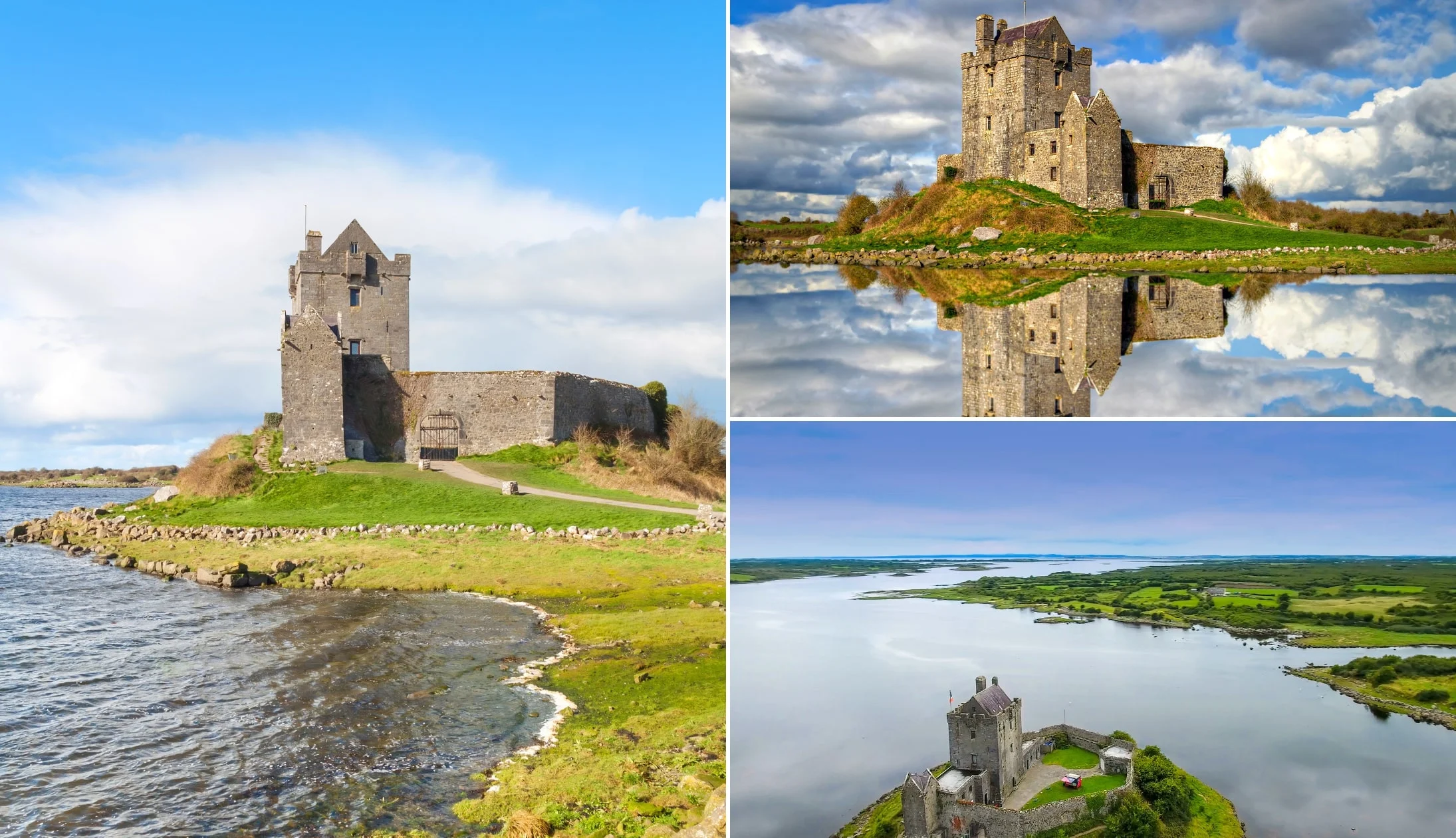
Photos via Shutterstock
Dunguaire Castle is a 35-minute drive from Galway. The castle was built in 1520 and belonged to the O’Hynes clan. In 1912, the castle was bought by writer Oliver St. John Gogarty.
During his ownership, he restored the castle and hosted several famous writers, including W.B. Yeats and George Bernard Shaw.
The enchanting castle sits on the shores of Galway Bay and has an impressive 75-foot tower. We’d recommend spending at least an hour here, walking the grounds and taking a self-guided tour.
According to legend, if you stand at the front gate and ask a question, you’ll have an answer by the end of the day!
Stop 2: Aillwee Cave

Photos via Aillwee Caves on FB
Your next stop, the Aillwee Cave, is around 27 minutes from Dungaire. The Aillwee Cave is a fascinating underground system, full of caverns, rock formations, and even the bones of an ancient bear!
The site is close to the Birds of Prey Centre, a unique and educational experience involving some of the world’s top birds of prey.
We’d recommend spending at least one hour at this stop, or even longer if you visit both attractions. The Aillwee Cave tour lasts 45 minutes, passing by an underground waterfall and over bridged ravines.
At the Burren Birds of Prey Centre, you’ll be able to see predators like owls, vultures, and hawks, and possibly watch a 45-minute flying demonstration.
Stop 3: Ballyvaughan for lunch
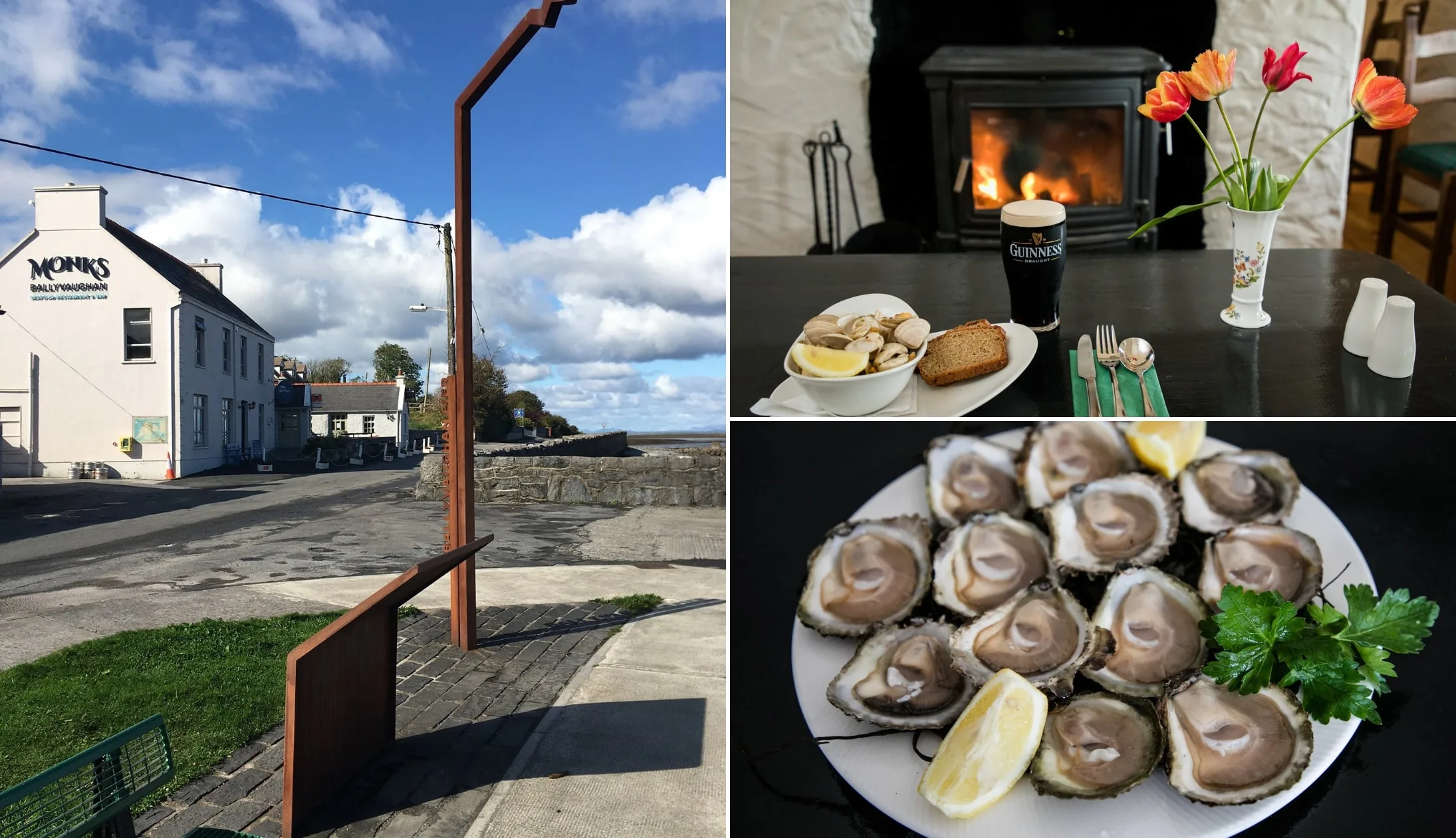
Photos via Monk’s on FB
It’s time to head to the quaint seaside village of Ballyvaughan, only 5-minutes from Aillwee Cave.
Our favourite places to eat in the village are Monks (a brilliant seafood restaurant with handpicked Galway Bay oysters), The Wild Atlantic Lodge (a beautiful restaurant with delicious Irish cuisine), or The Larder (a cosy cafe with sandwiches, soup, and quiches).
Once you’re done, take the scenic coastal drive to Doolin along the R466.
Stop 4: Doolin

Photos courtesy of Chaosheng Zhang
The coastal drive from Ballyvaughan to Doolin usually takes around 40 minutes, but we would recommend giving yourself a little extra time.
There are some amazing views of the Burren along the way and you might want to pull over! Once you arrive at Doolin, check into your hotel and rest/freshen up/etc.
Stop 5: Cliffs of Moher

Photos via Shutterstock
Your next stop, the magnificent Cliffs of Moher are one of the area’s, (if not Ireland’s) most popular attractions.
The cliffs are a 15-minute drive from Doolin, with breathtaking views of the wild Atlantic, Galway Bay, and the Aran Islands.
There’s a visitor centre on-site, as well as 800 metres of paved walkways with viewing areas, and the historic O’Brien’s Tower. In our opinion, the visitor centre isn’t really anything that special, but you’ll get access to all three with the Cliffs of Moher Experience.
Stop 6: Dinner, drinks and music in Doolin
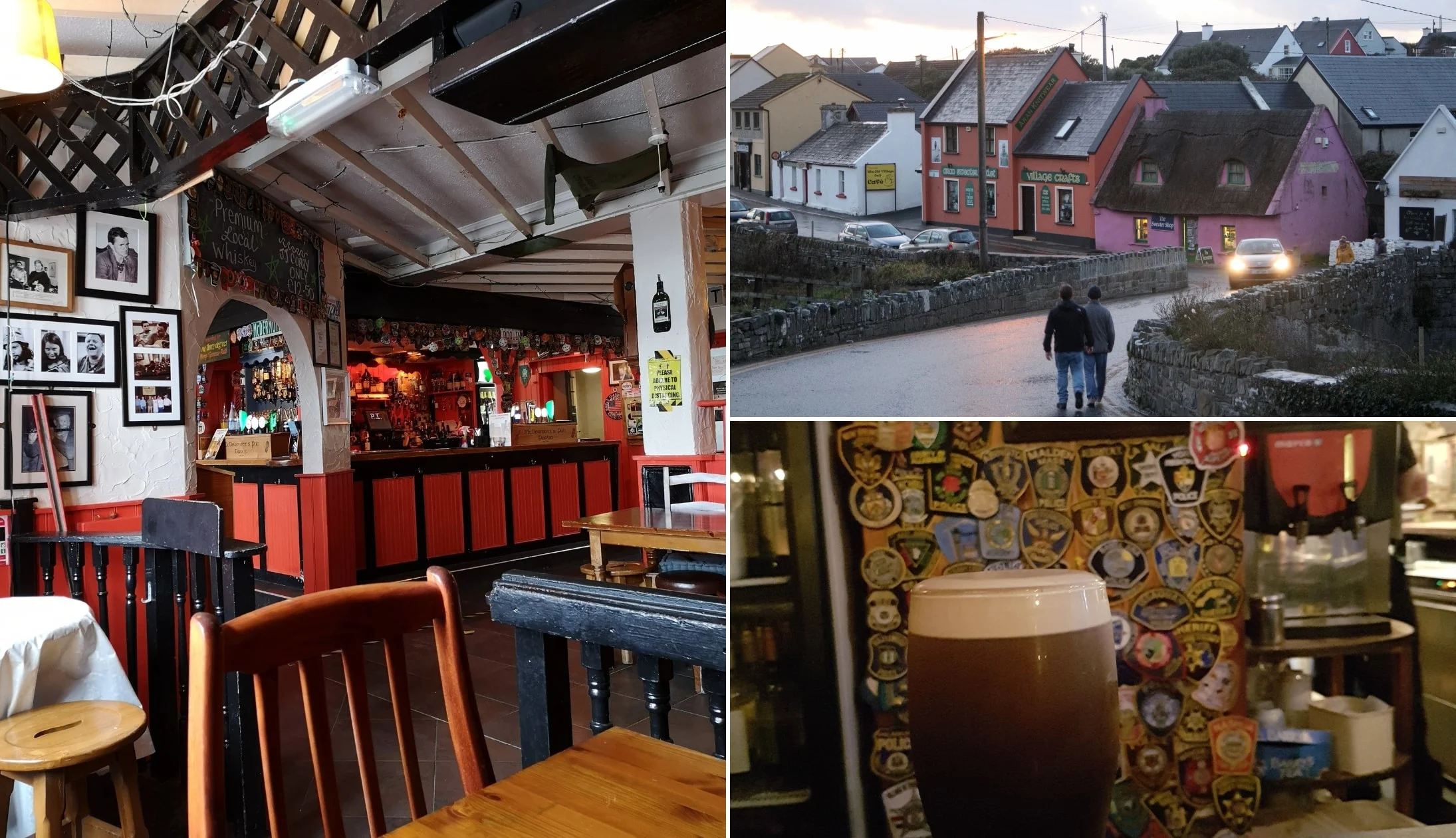
Photos by The Irish Road Trip
Although it’s fairly small, there’s some great restaurants in Doolin and there’s a handful of mighty pubs in Doolin, too.
Our Doolin food recommendations
We have quite a few recommendations for where to eat in Doolin. These are Riverside Bistro (the seafood pasta and lamb shank are delicious), Anthony’s at Doolin (modern Irish and international cuisine with a great selection of cocktails), and Russell’s Seafood Bar at Fiddle + Bow (amazing local seafood from award-winning chef Viv Kelly).
Our Doolin pub recommendations
Doolin is packed full of traditional Irish pubs which are great for a pint (or a hearty pub meal if the restaurants above aren’t to your liking). Our favourites are McDermot, McGanns, Fitz’s, and Gus O’Connors.
The pubs above are also a good place to catch some live music, as well as Anthony’s at Doolin.
Day 12: Back to Limerick and on to Shannon

Photos via Shutterstock
Today is your last day! The drive from Doolin to Shannon is around 1 hour. It takes another 15 minutes to get into Limerick City. What you do today is up to you. If your flight leaves today, then head on over to the airport. If you have some free time, why not head to Bunratty?
If you are flying out today, head to Shannon and bon voyage! If you have one more day, make your way back towards Limerick and check out anything you have not already visited.
If you are going to stay a little longer in Limerick, don’t forget to check out our accommodation suggestions below.
Recommended accommodation in Limerick
- Budget: Woodfield House Hotel (15-minute walk from the city with excellent reviews) and Shelbourne House (cosy spot 20 minutes walk from the castle)
- Mid-range: Limerick City Hotel (very central hotel near the river) and The Bedford (very central boutique townhouse with exceptional reviews)
- Luxury: The Savoy Hotel (central, boutique 5-star) and The George (central spot on O’Connell Street in Limerick city centre)
And that’s a wrap on this road trip
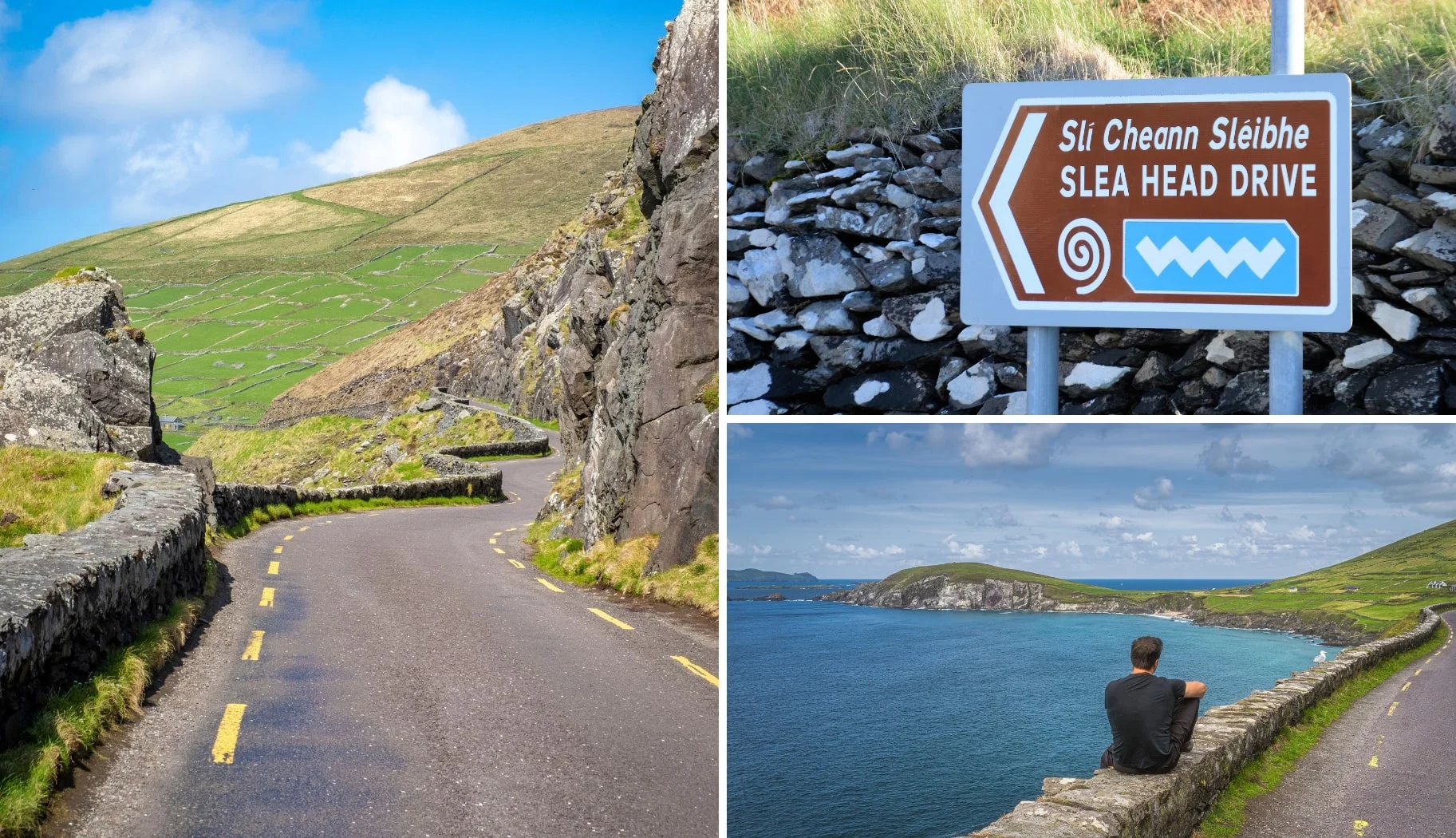
Photos via Shutterstock
We hope you found the above road trip guide useful. If you have any questions, ask in the comments below and we’ll do our best to help.
Or, if you’d like to browse our other Irish Road Trip itineraries, visit our Road Trip Hub – cheers!
Keith O’Hara has lived in Ireland for 35 years and has spent most of the last 10 creating what is now The Irish Road Trip guide. Over the years, the website has published thousands of meticulously researched Ireland travel guides, welcoming 30 million+ visitors along the way. In 2022, the Irish Road Trip team published the world’s largest collection of Irish Road Trip itineraries. Keith lives in Dublin with his dog Toby and finds writing in the 3rd person minus craic altogether.

